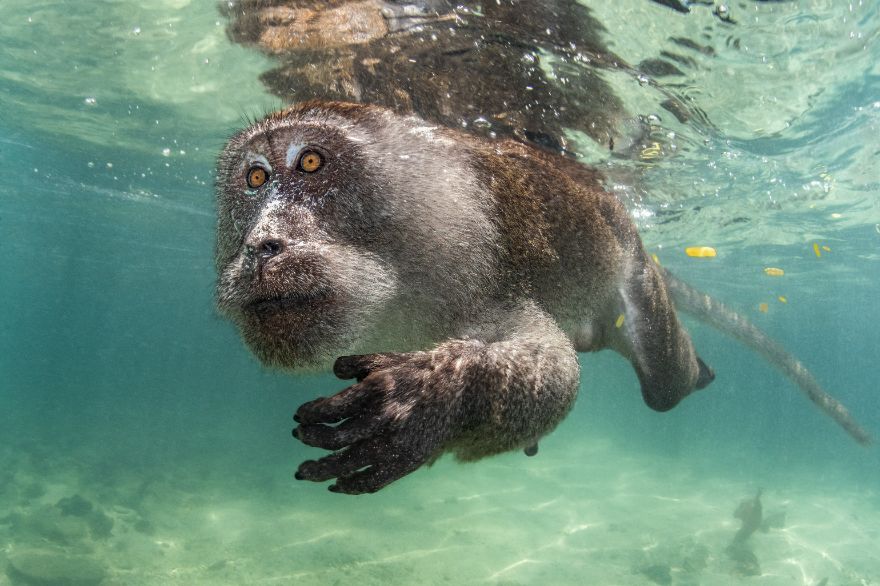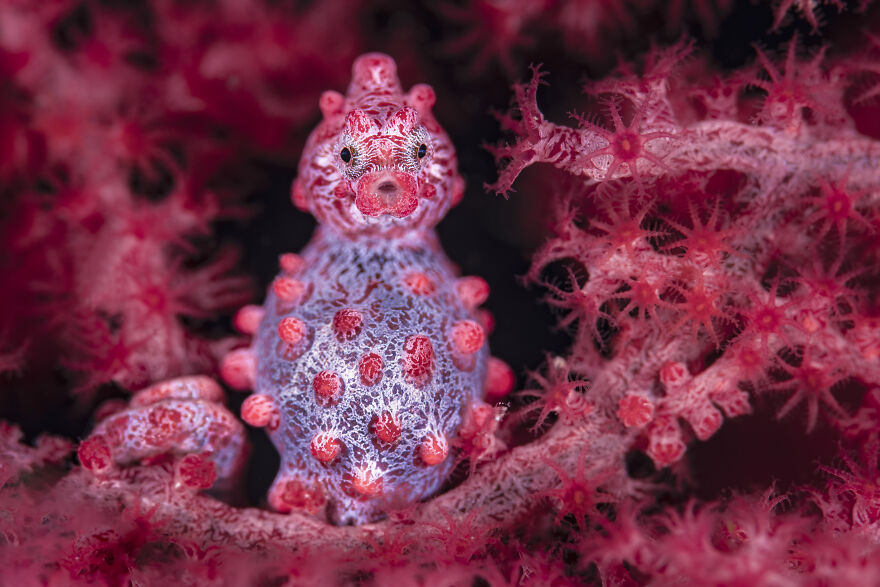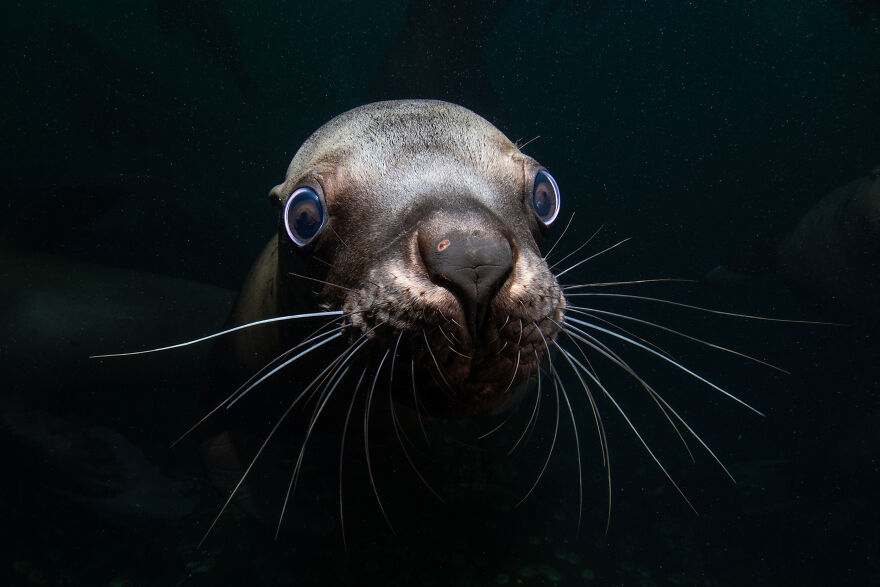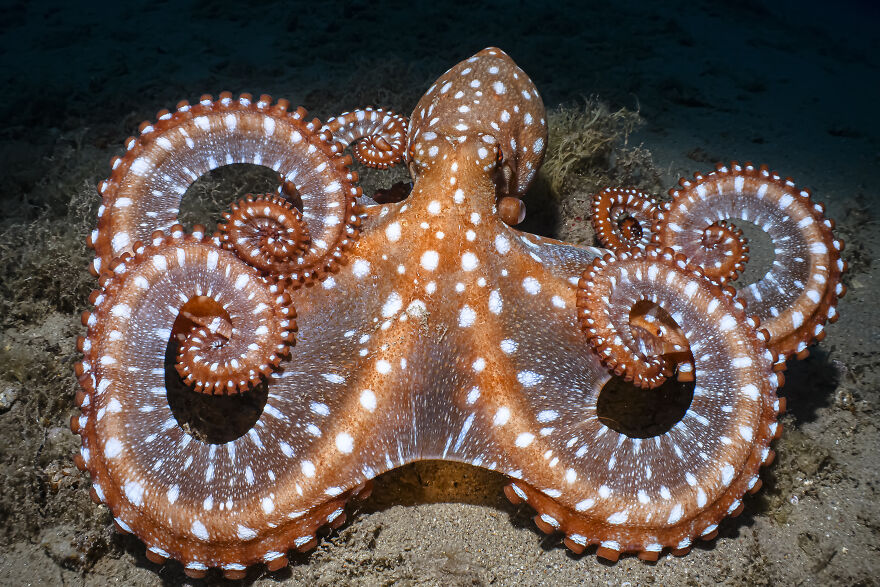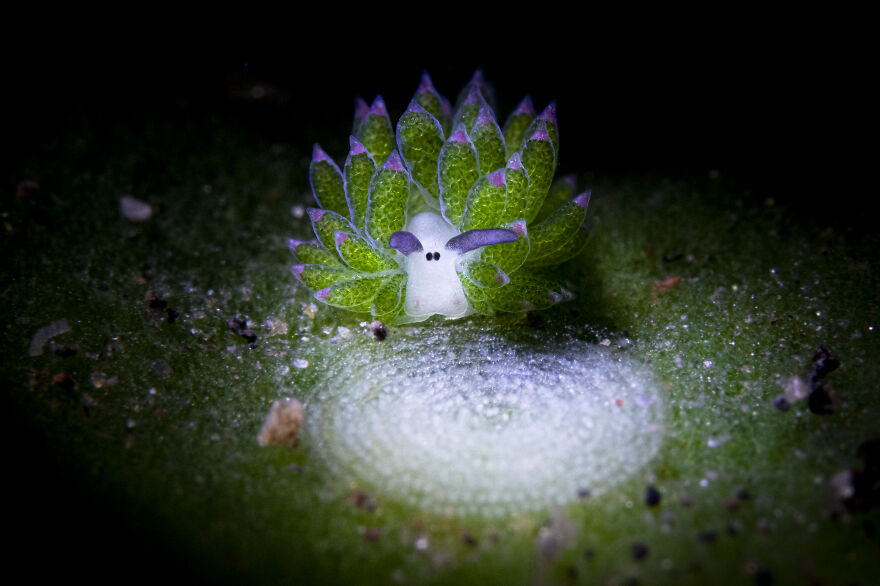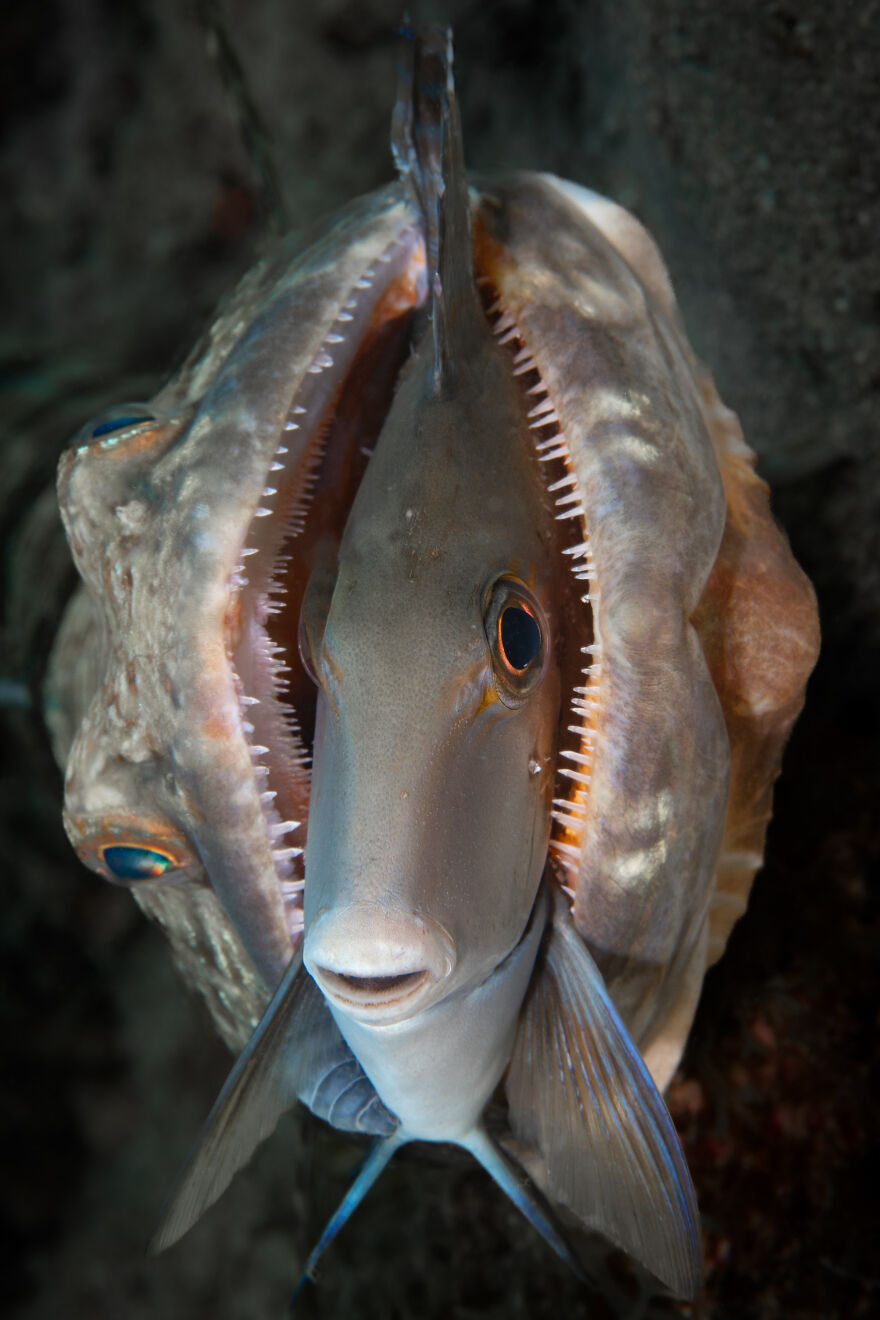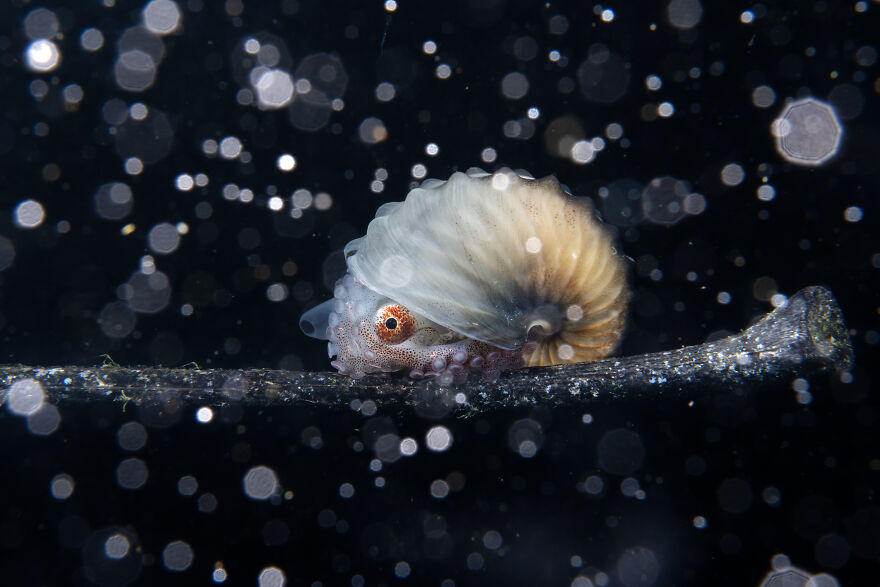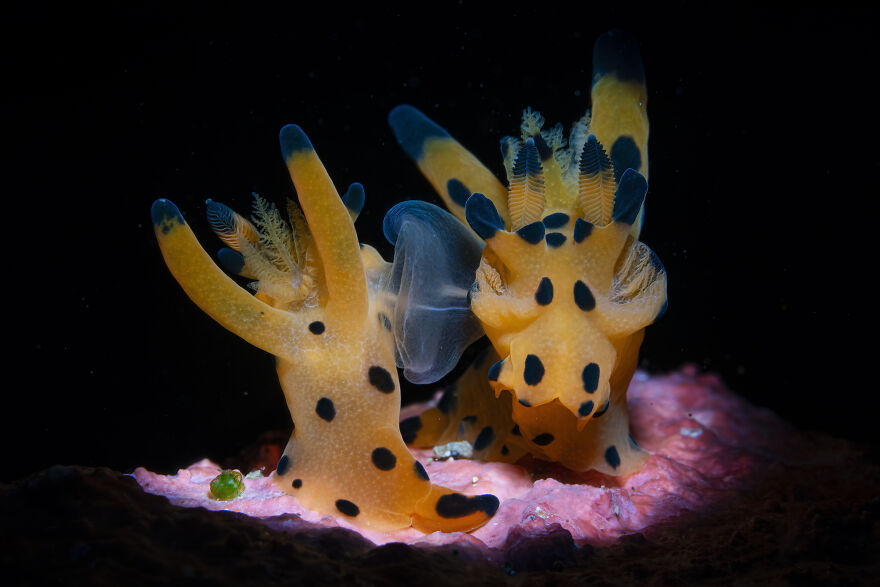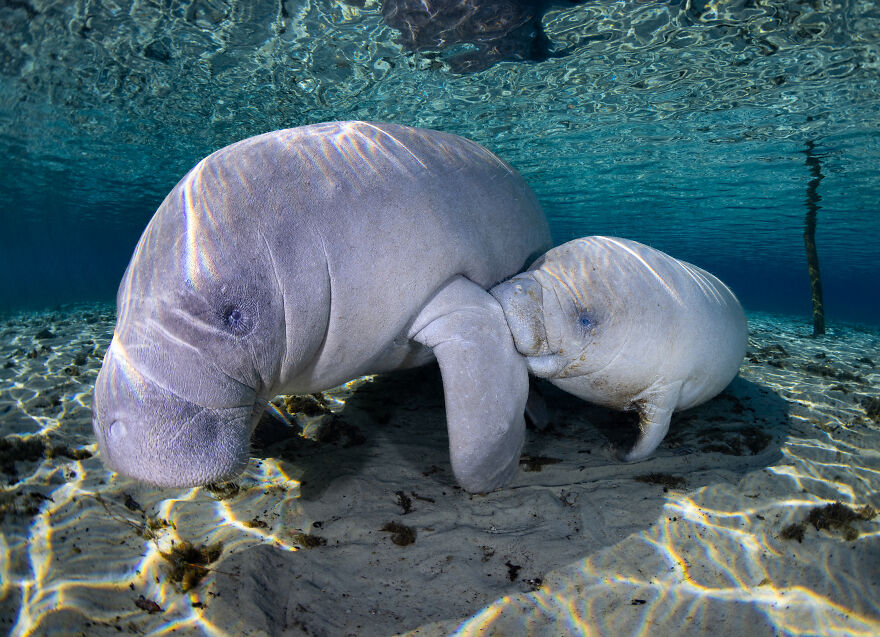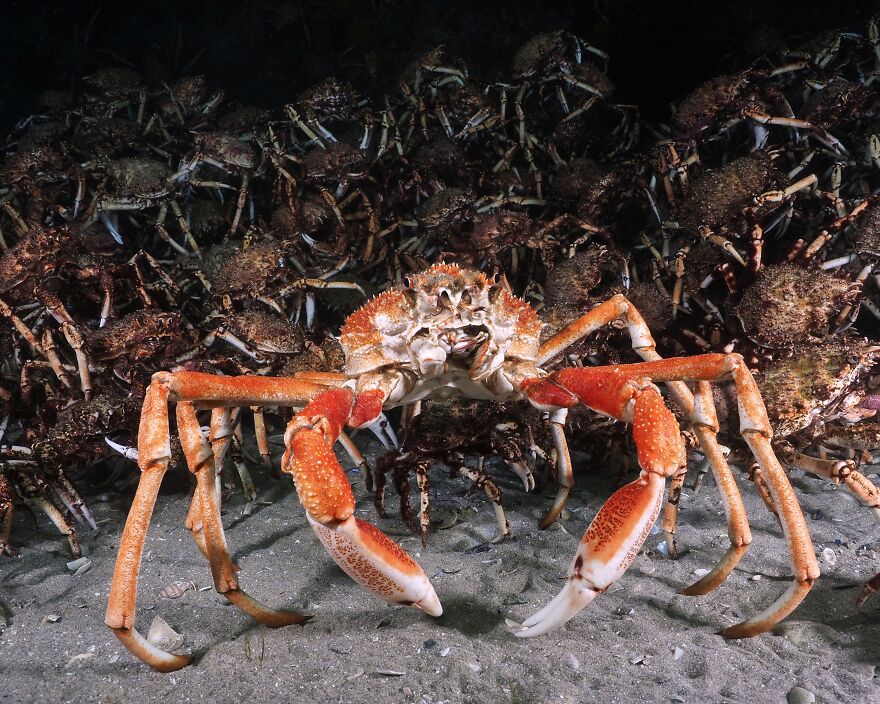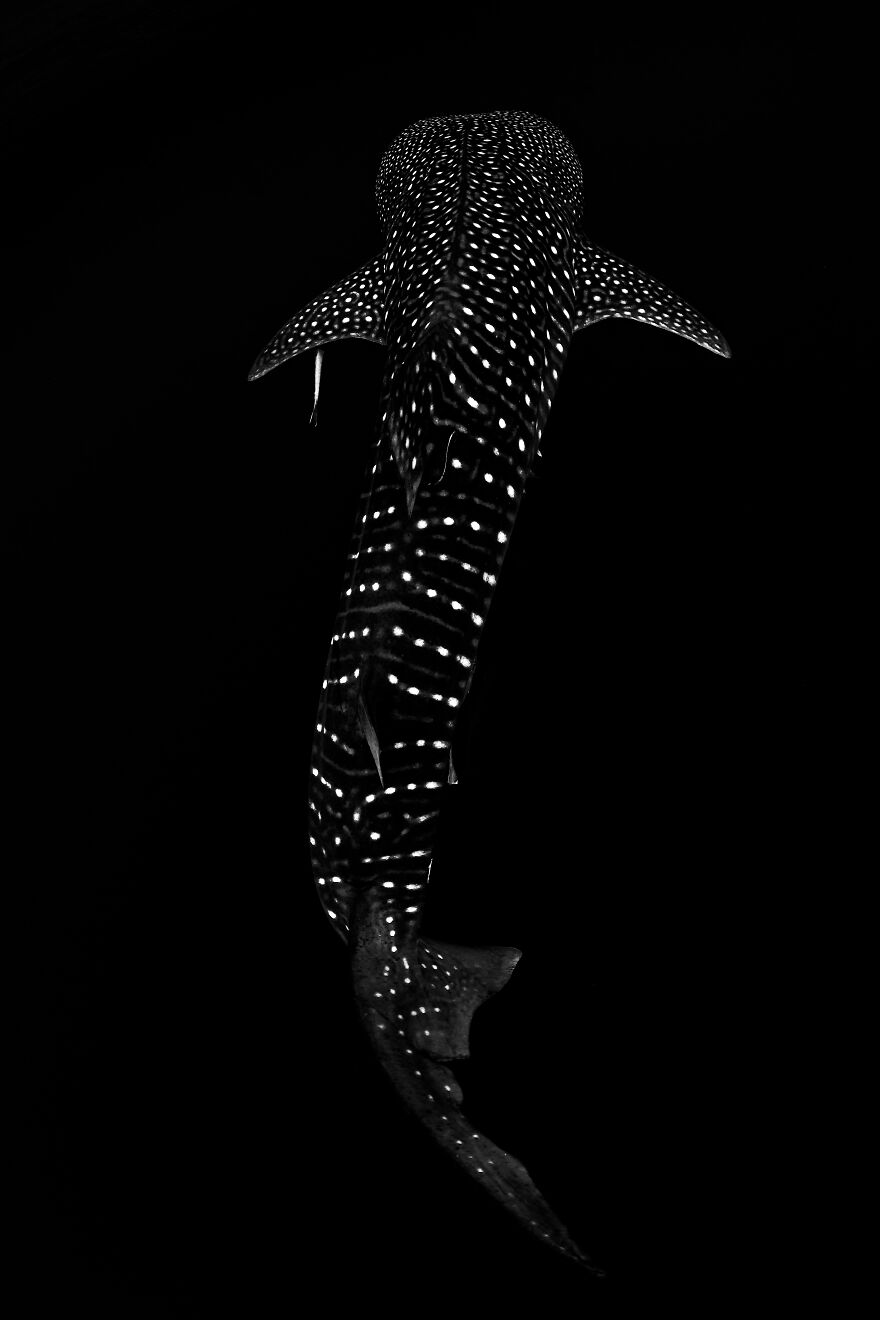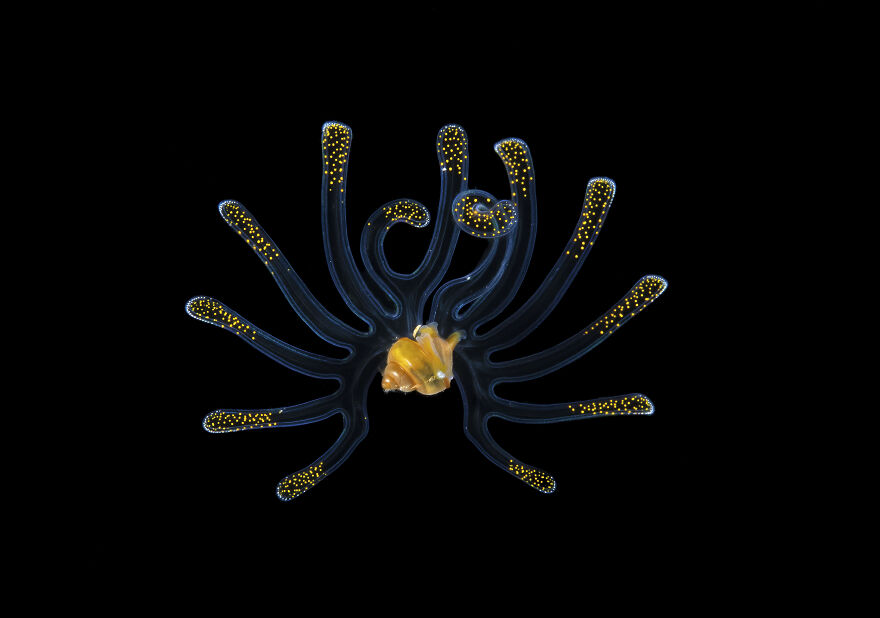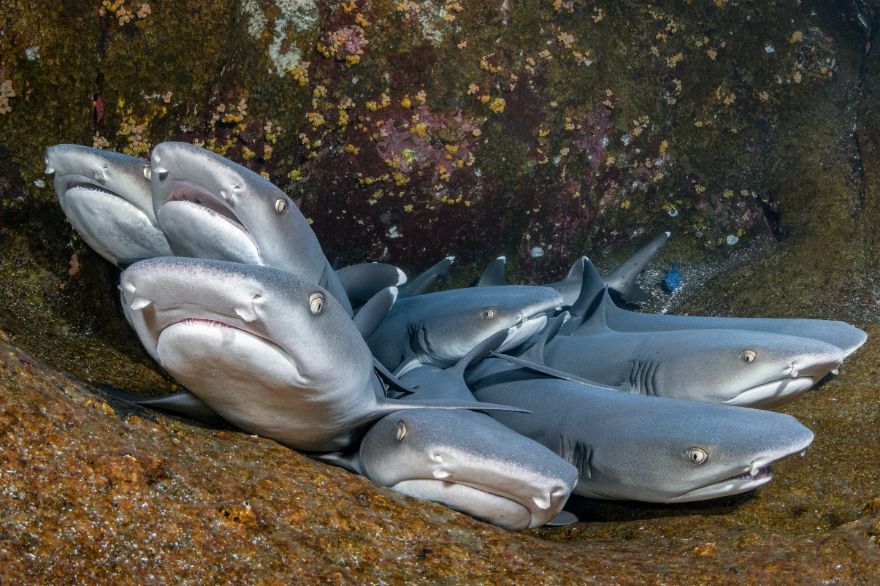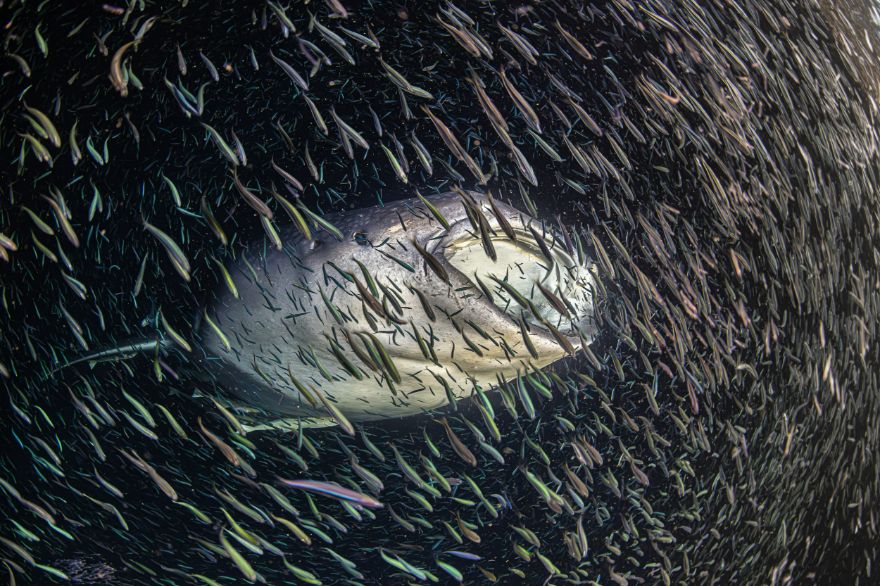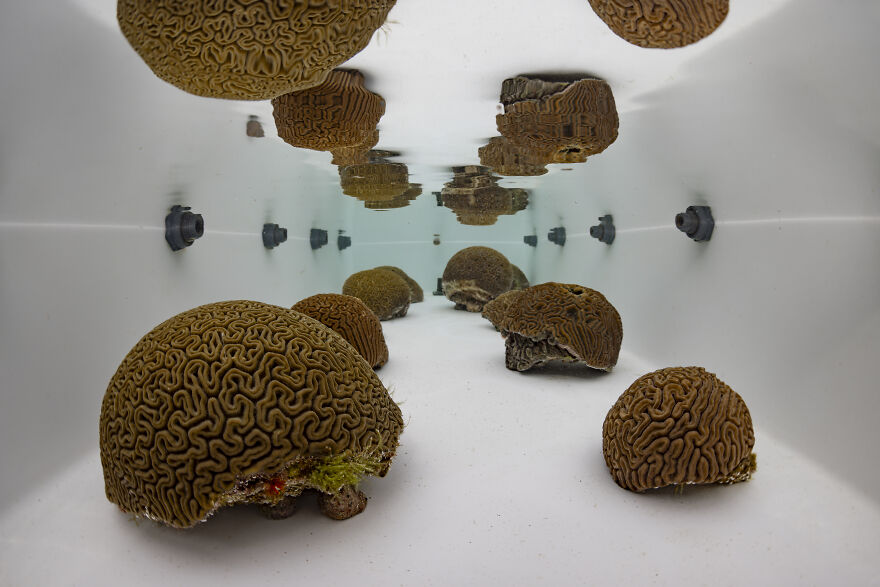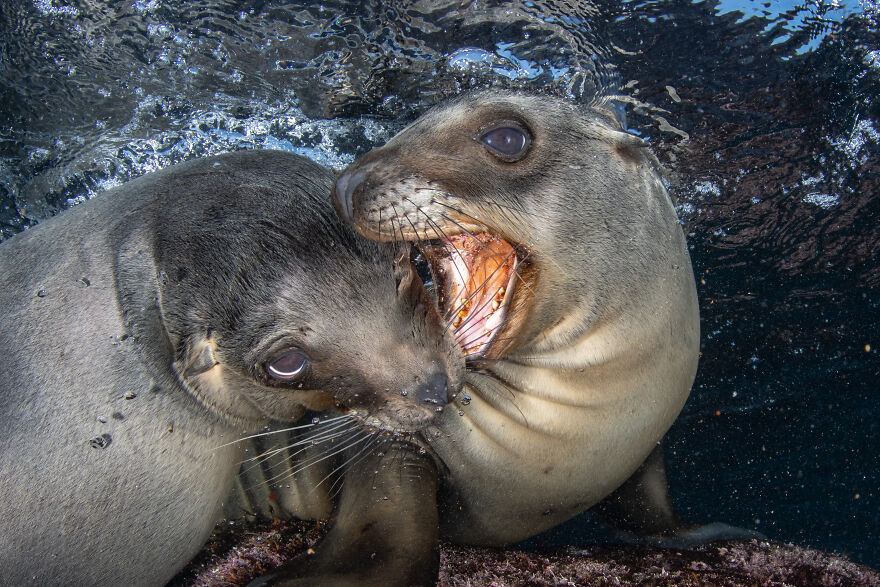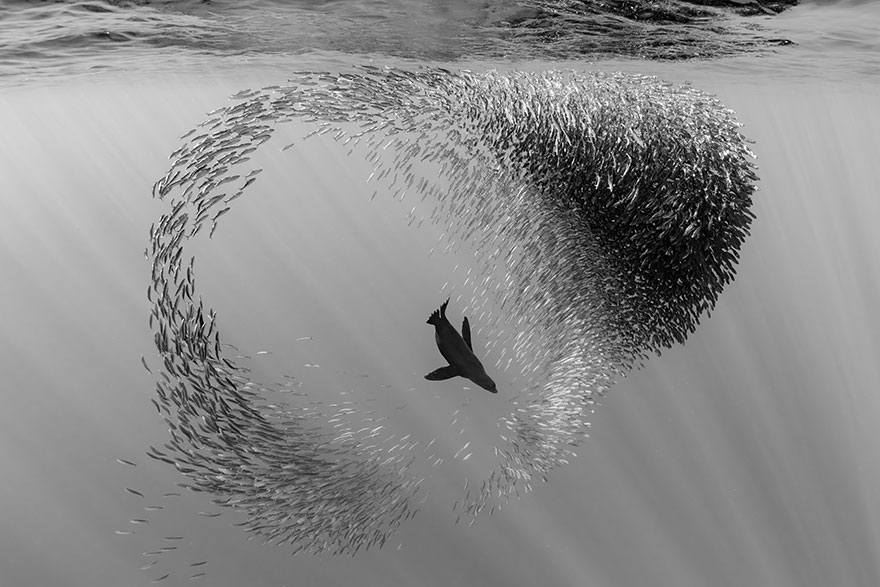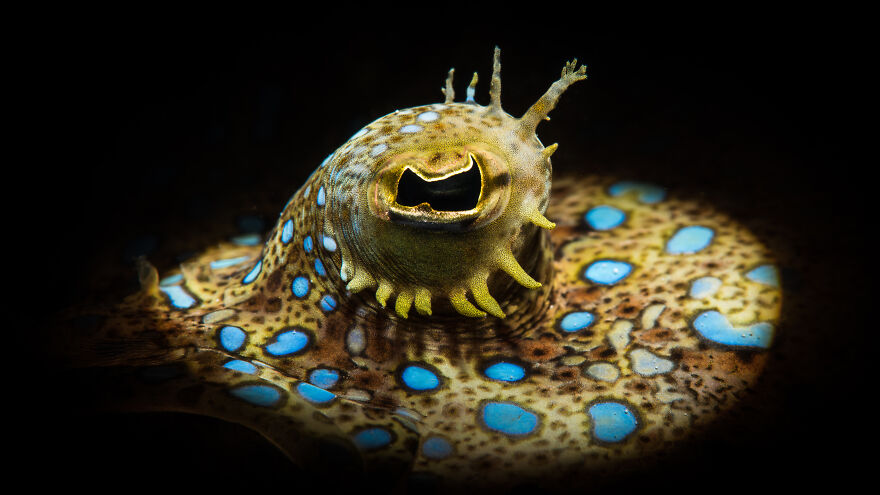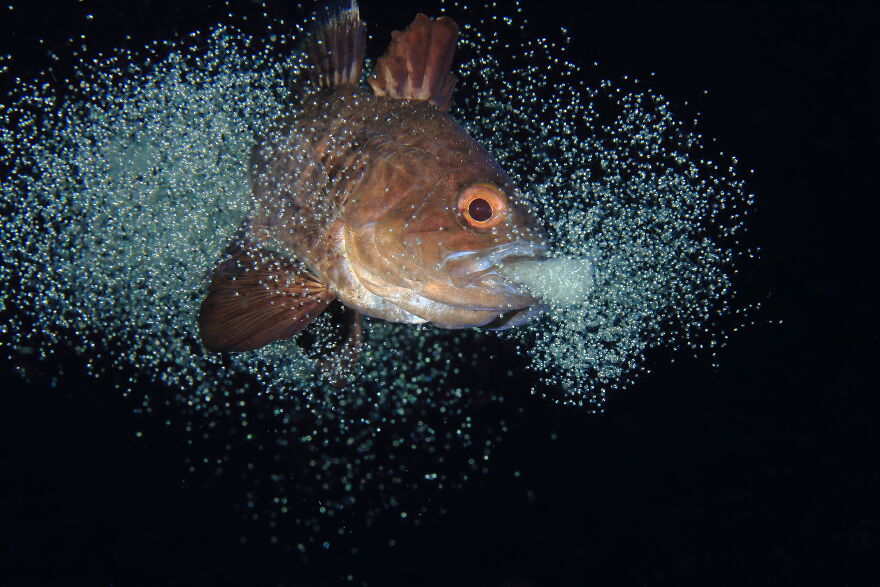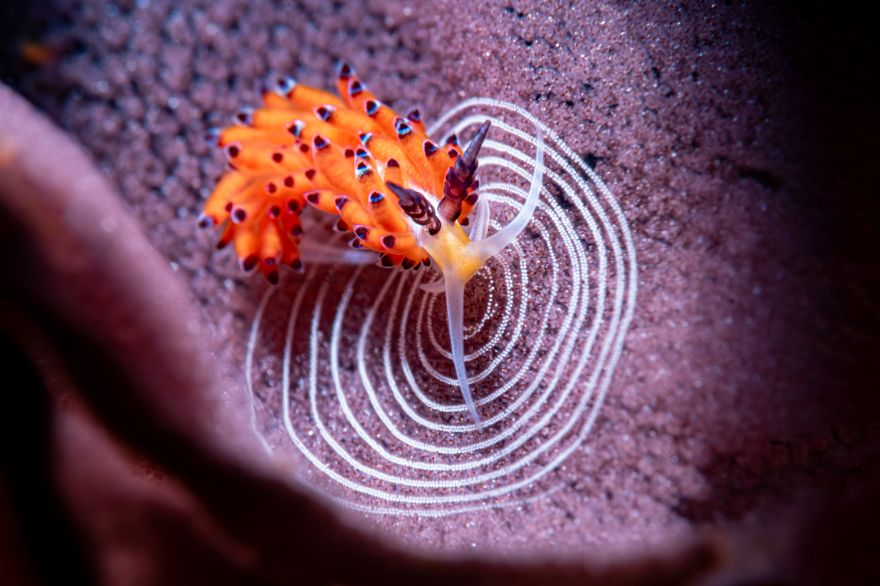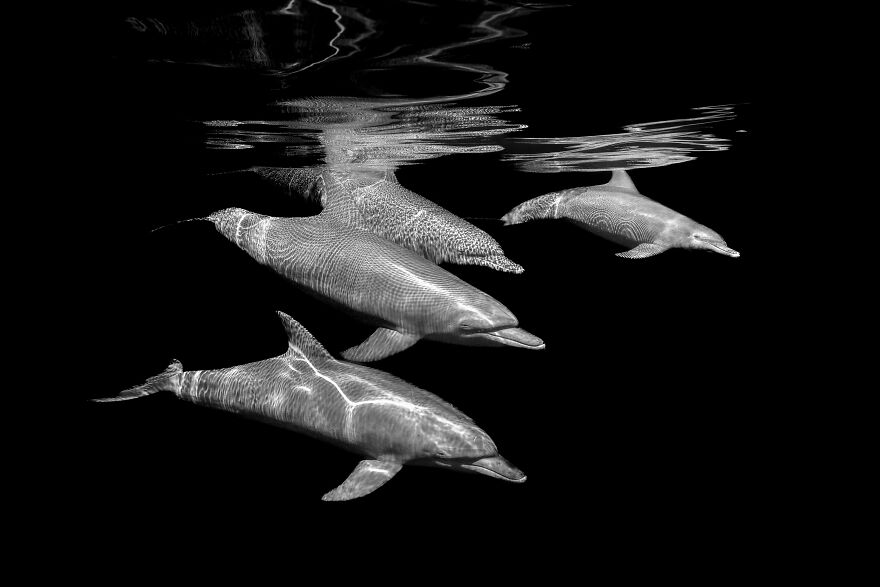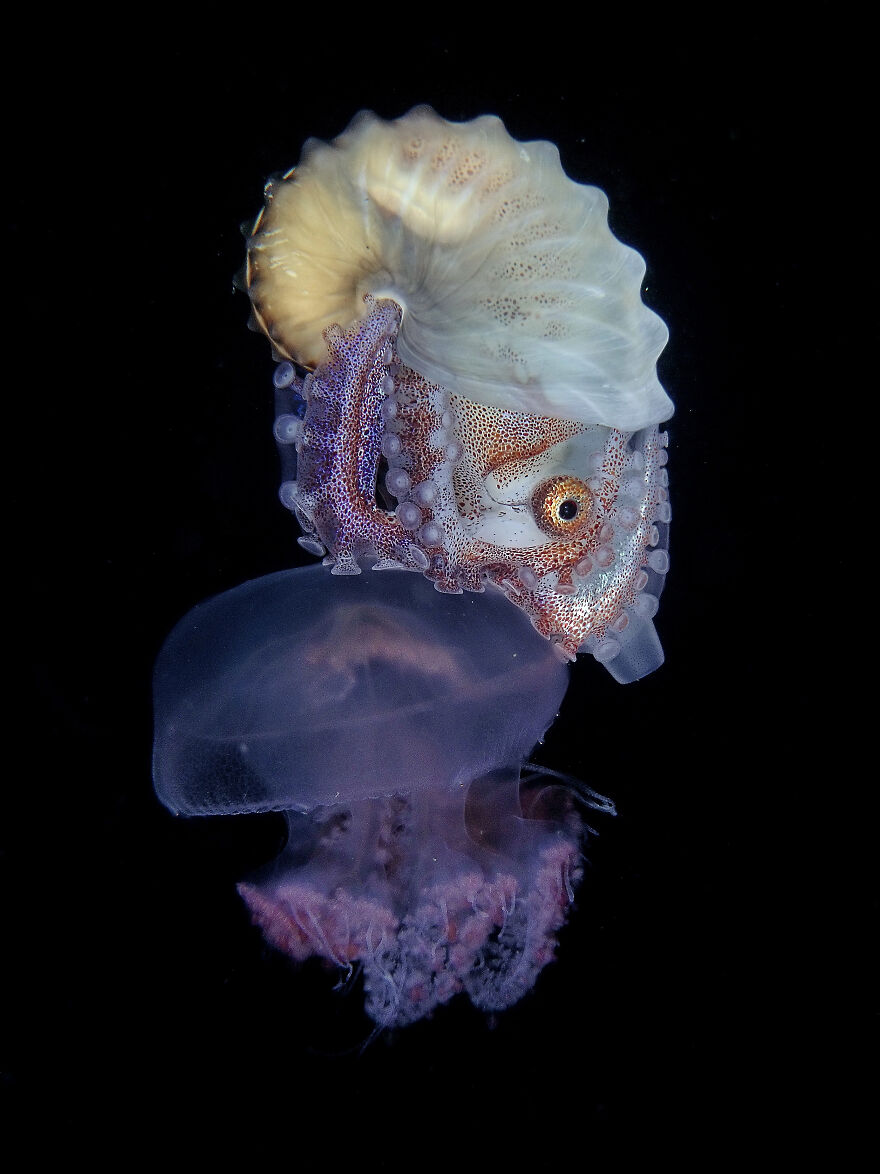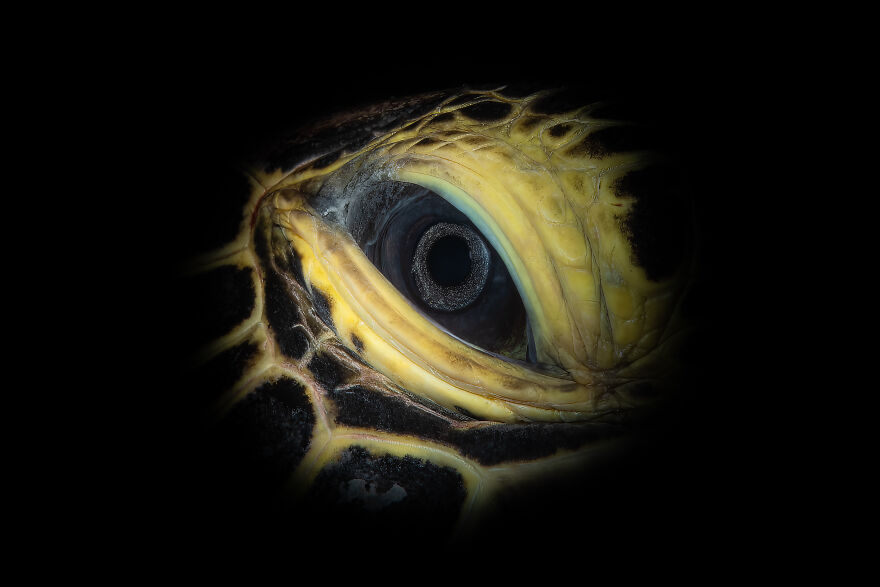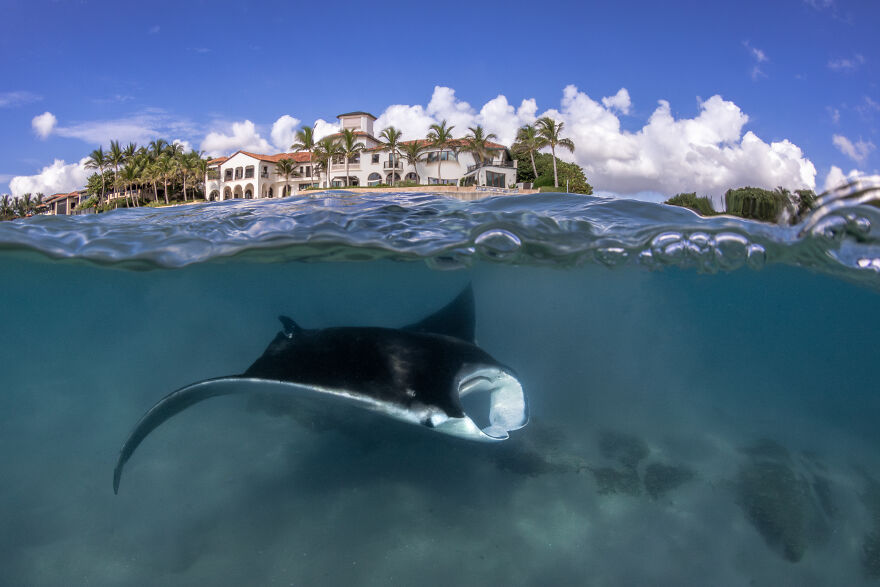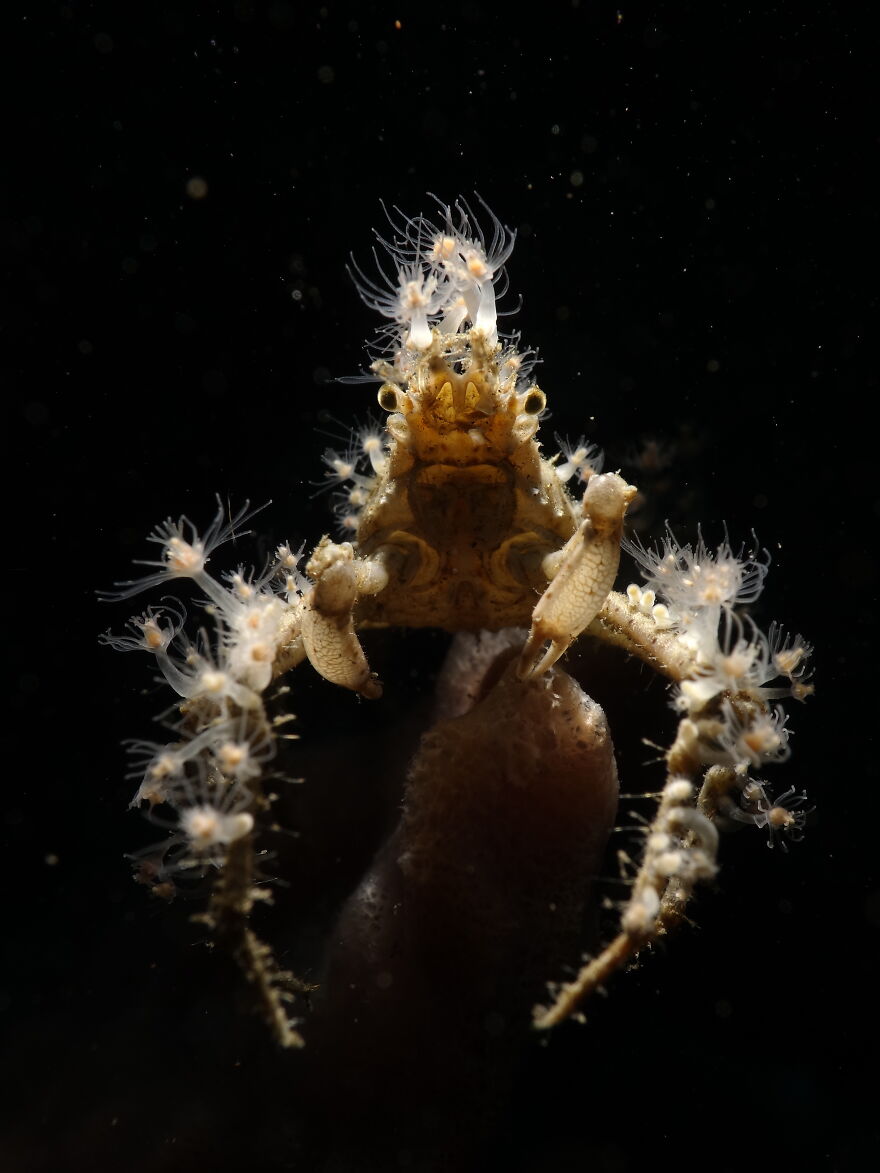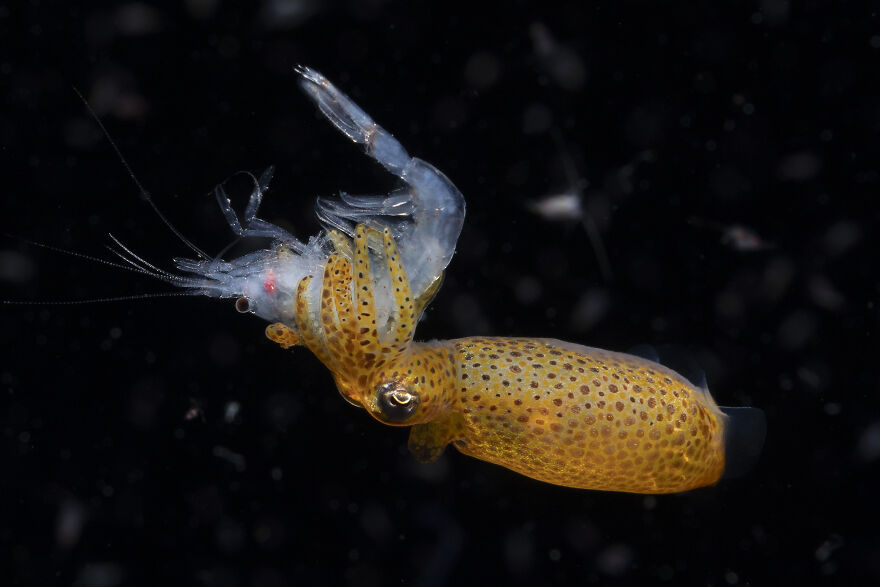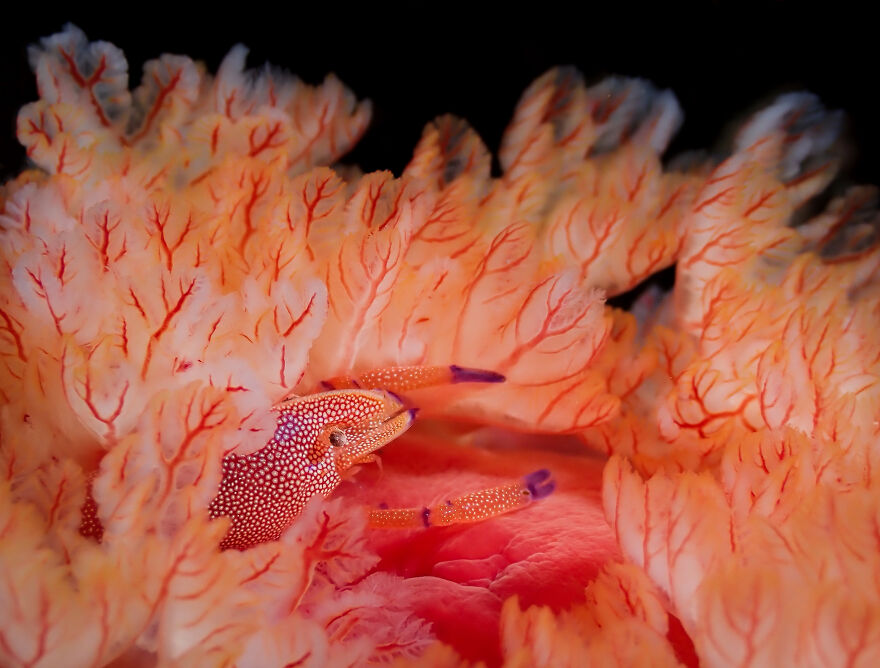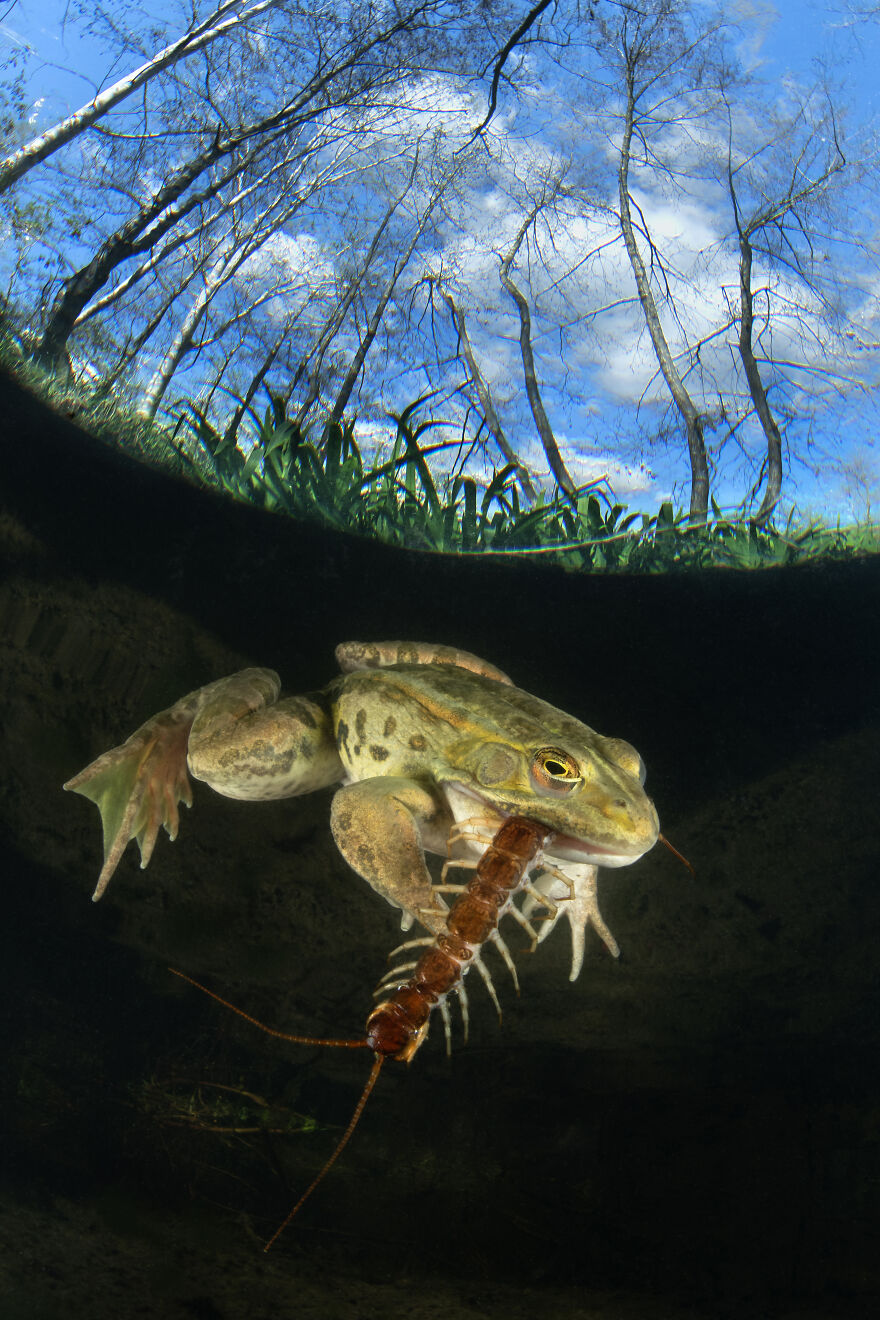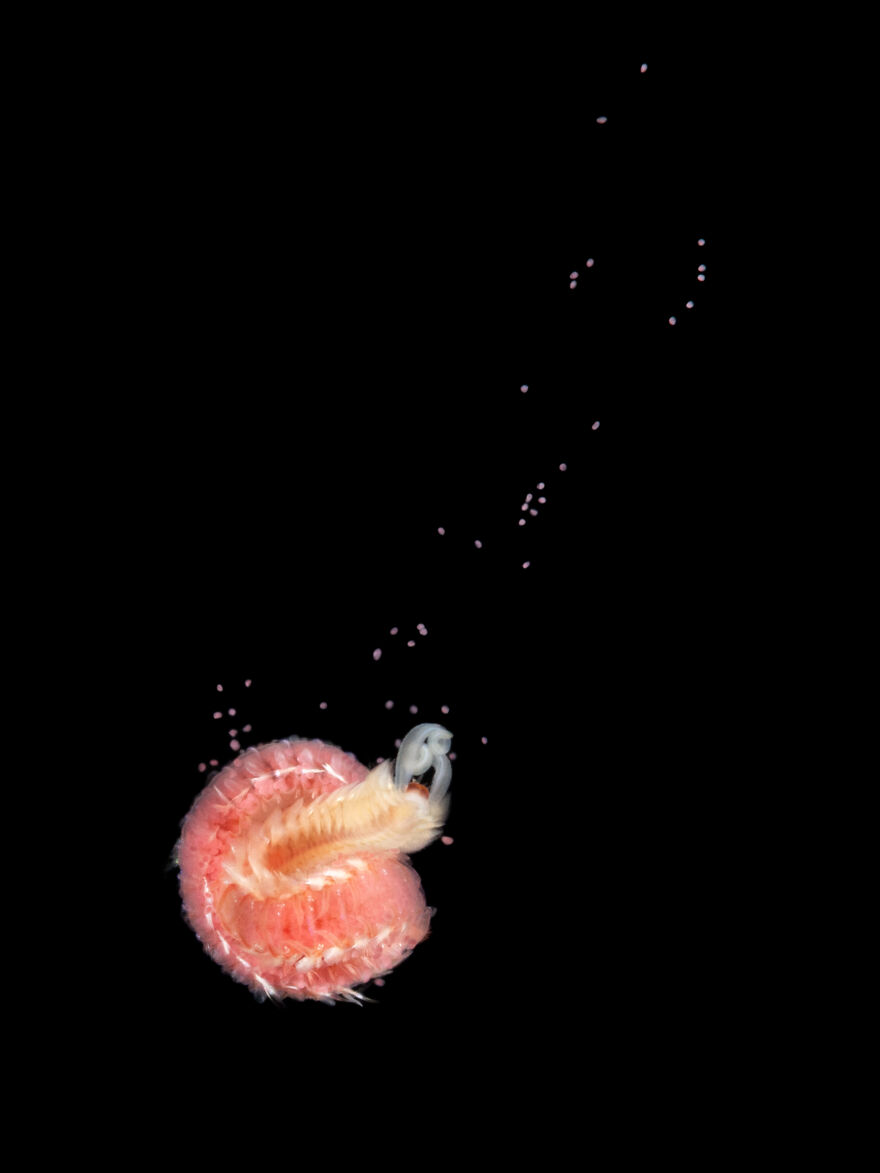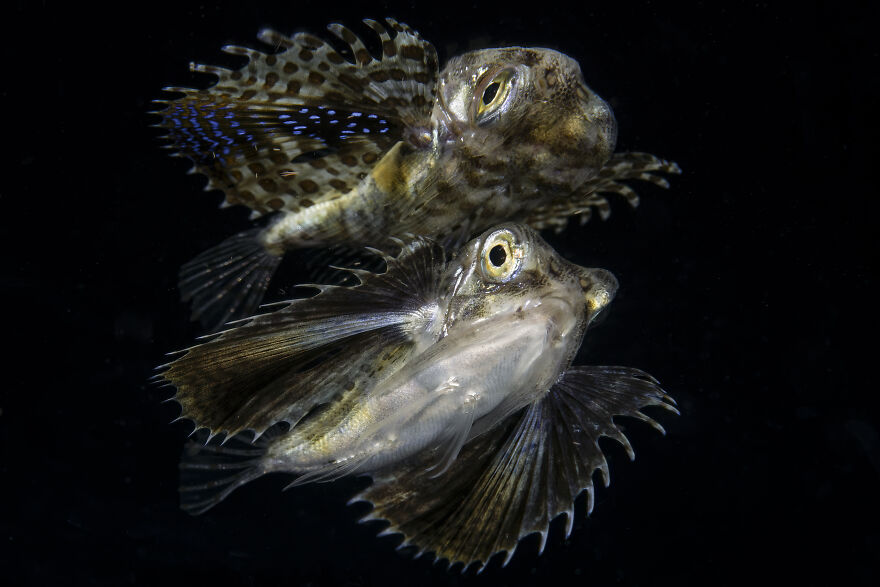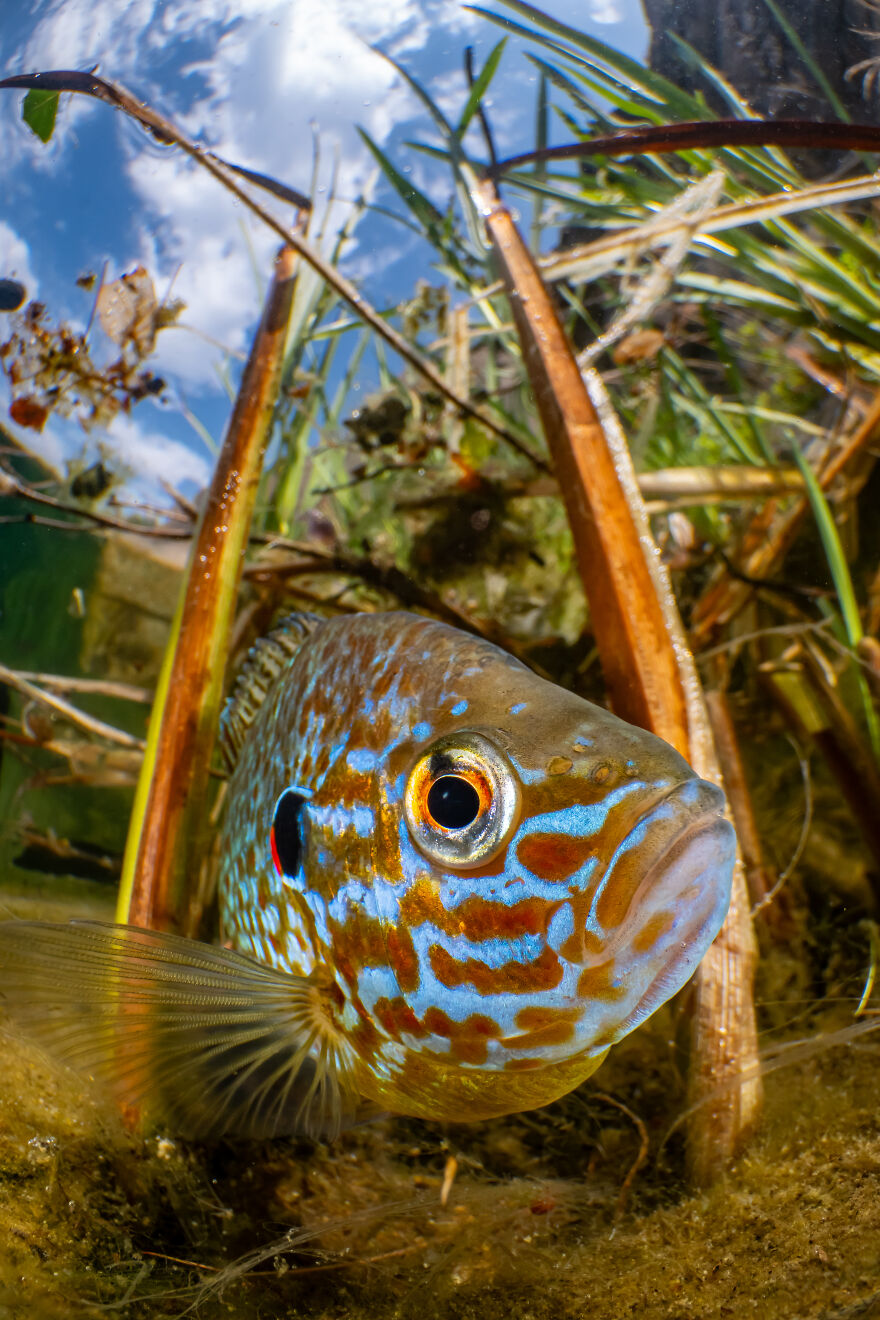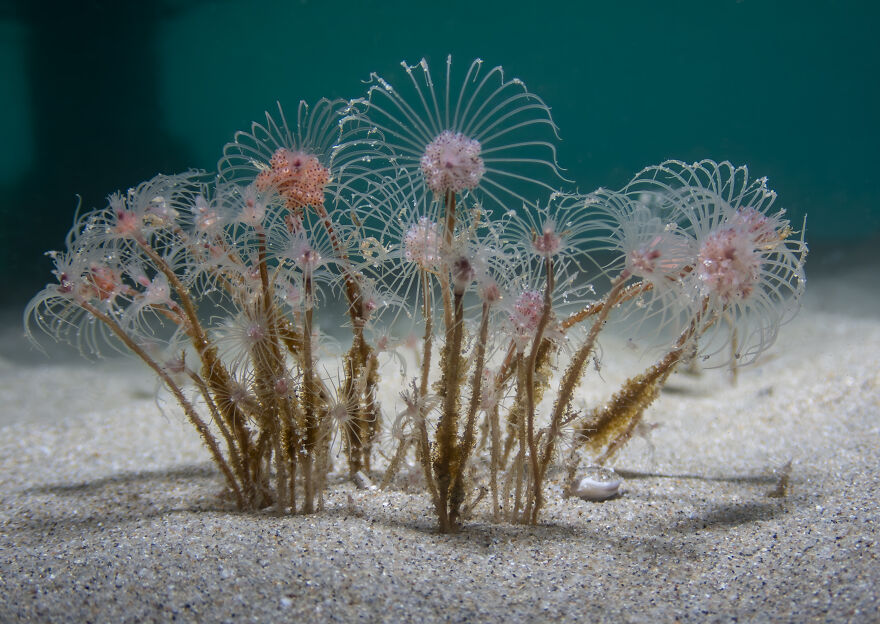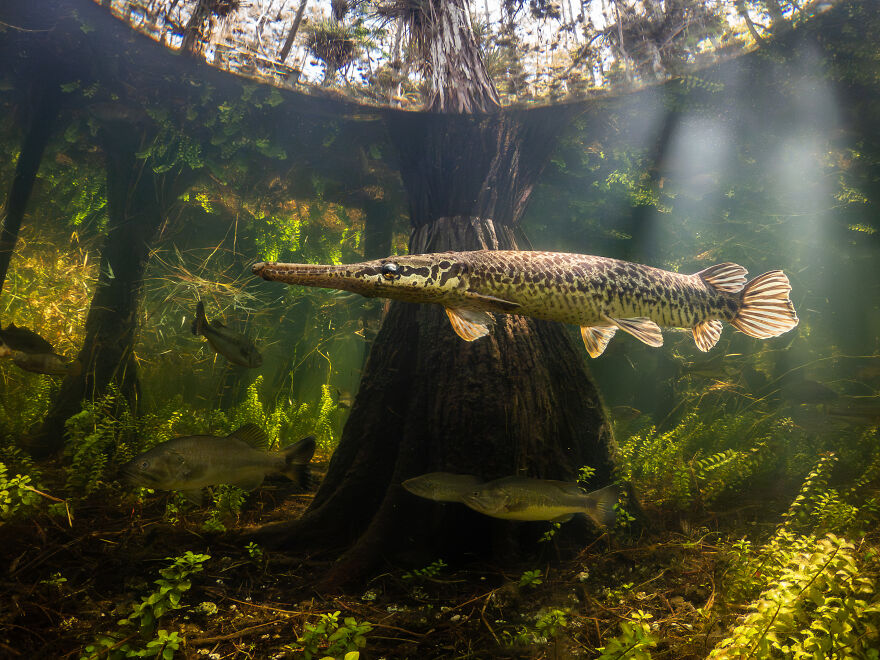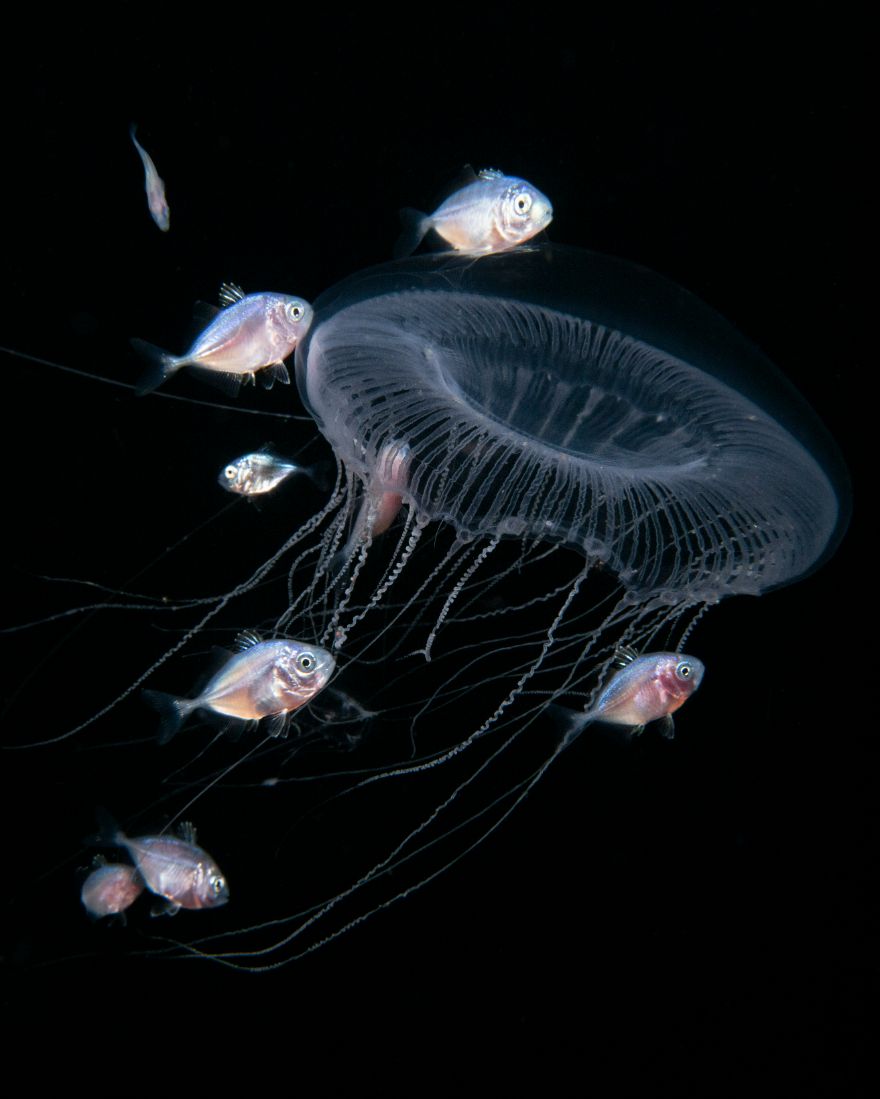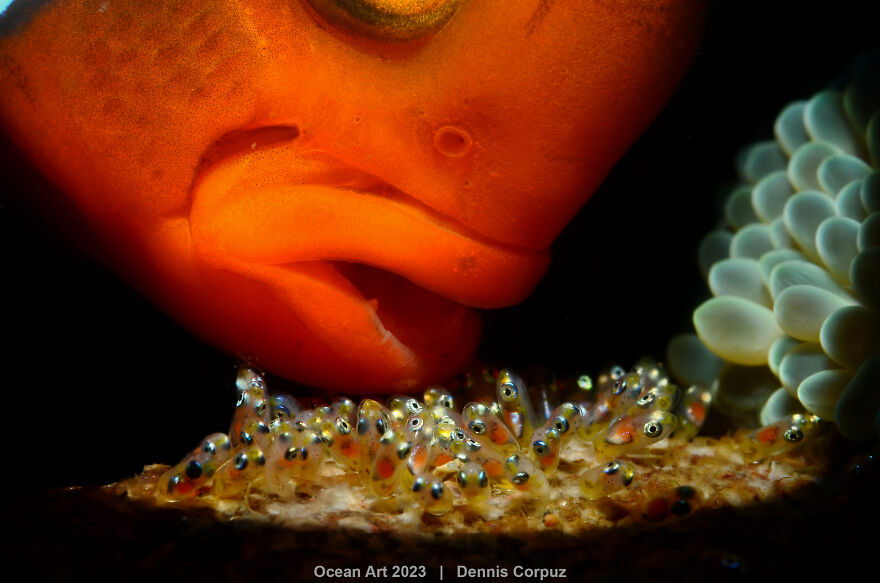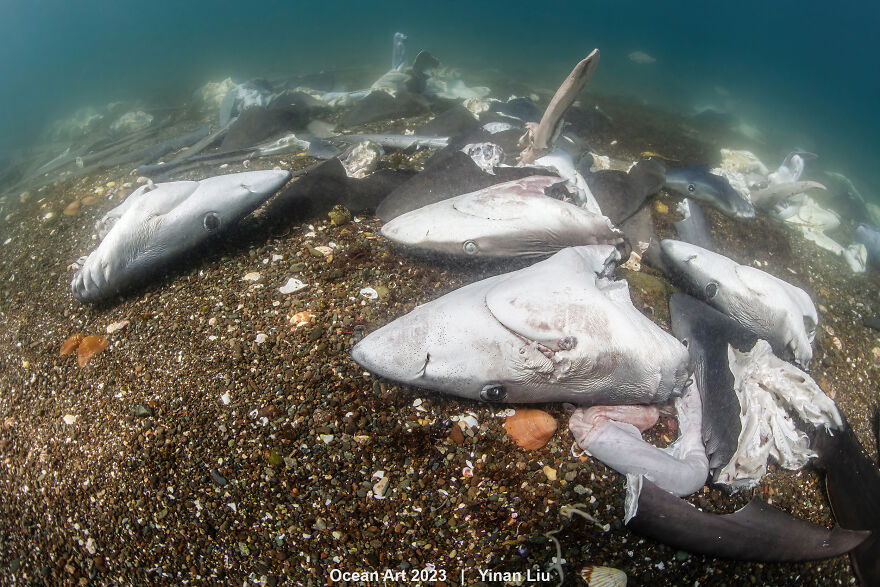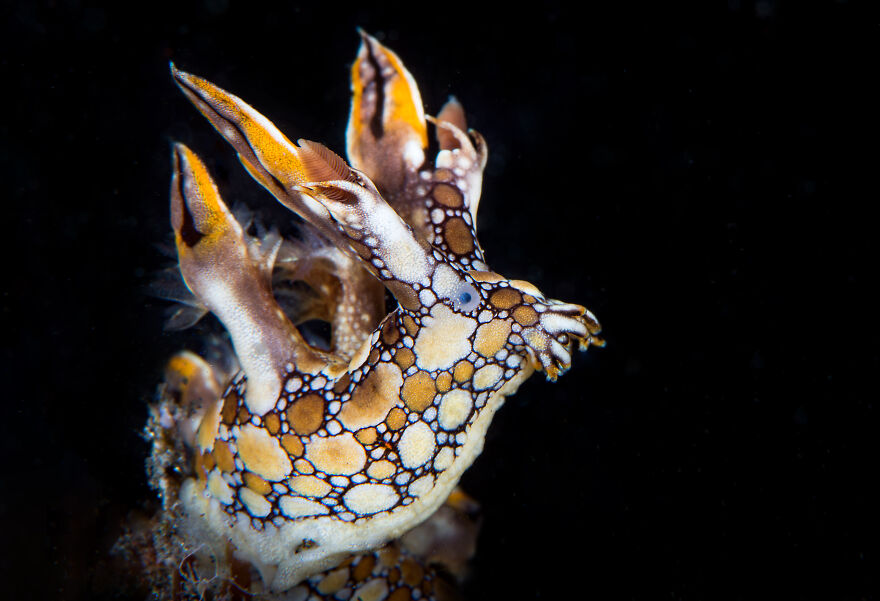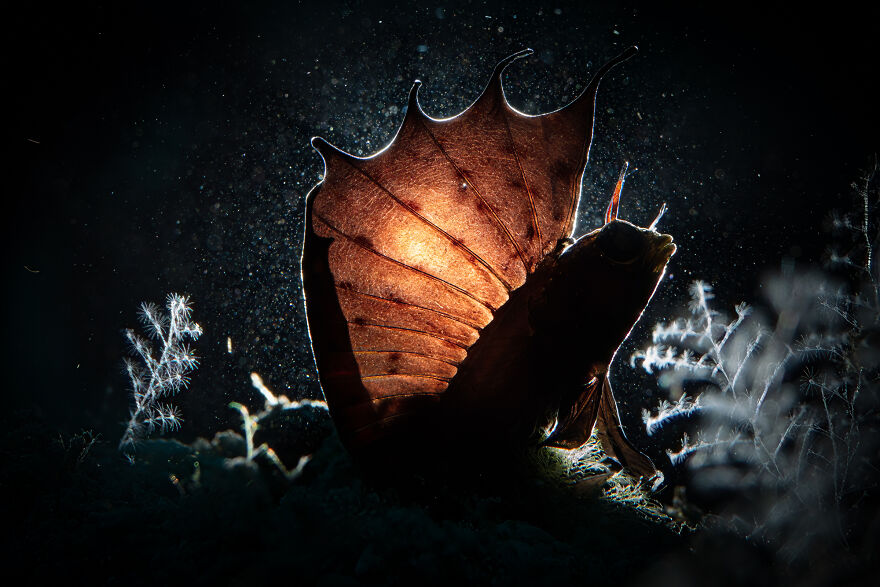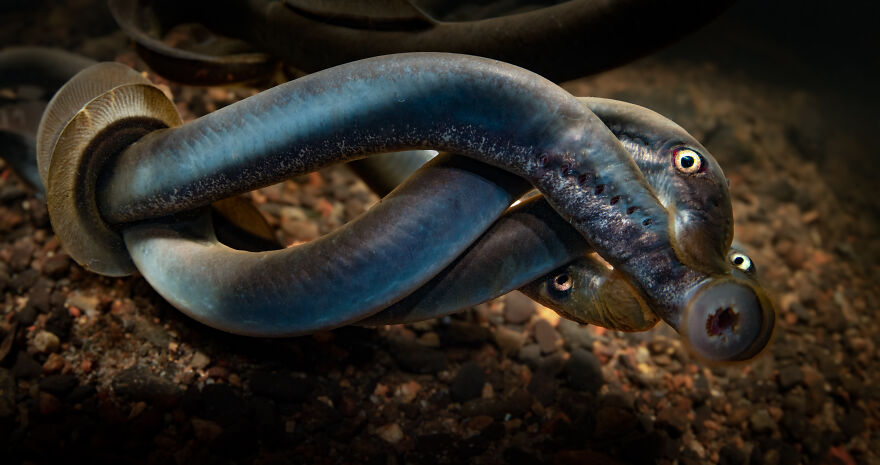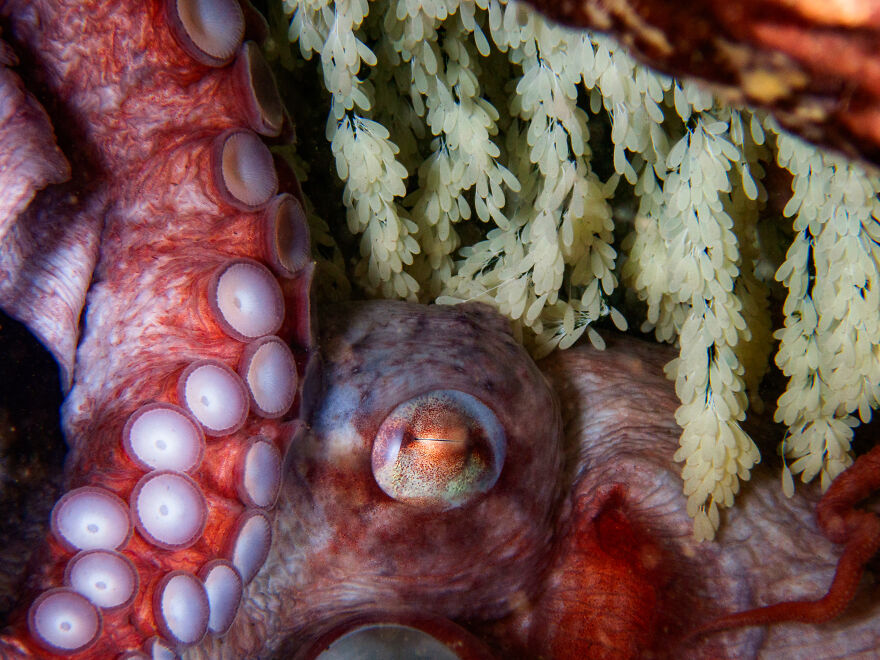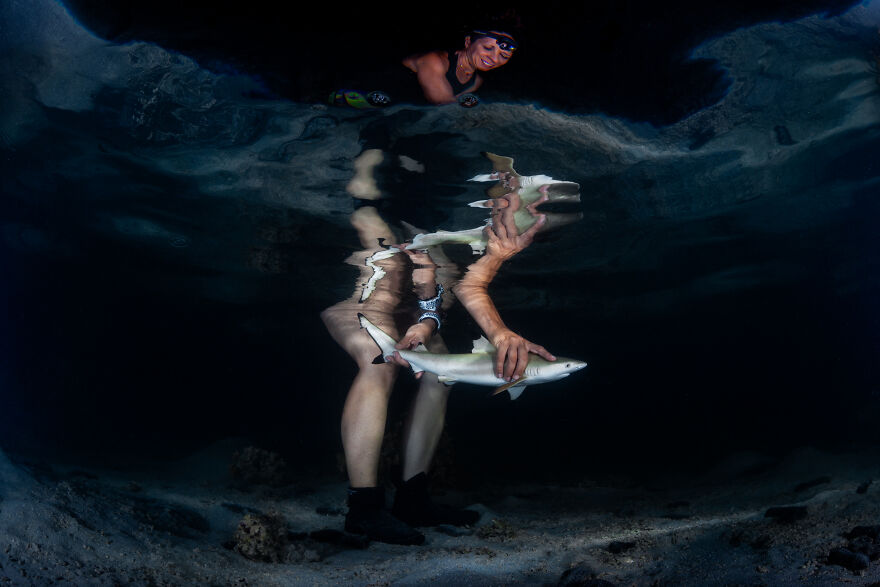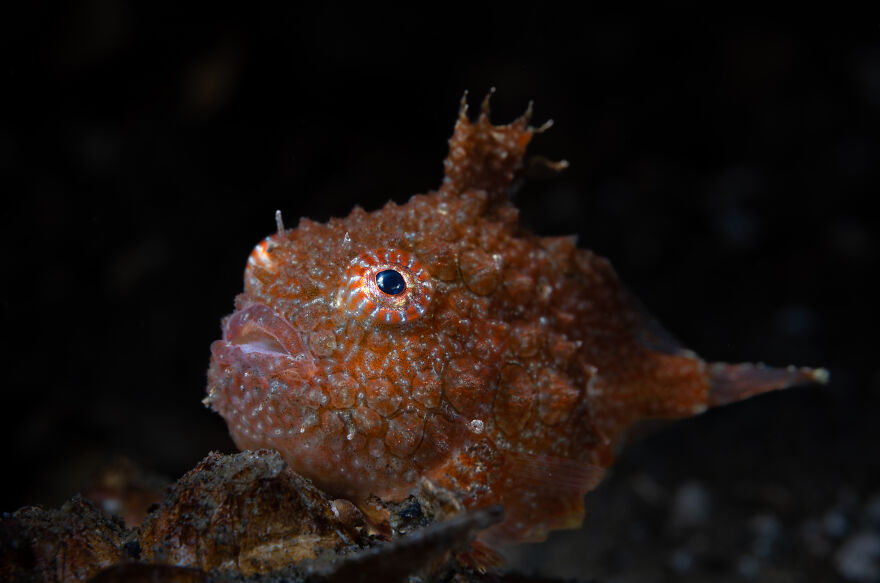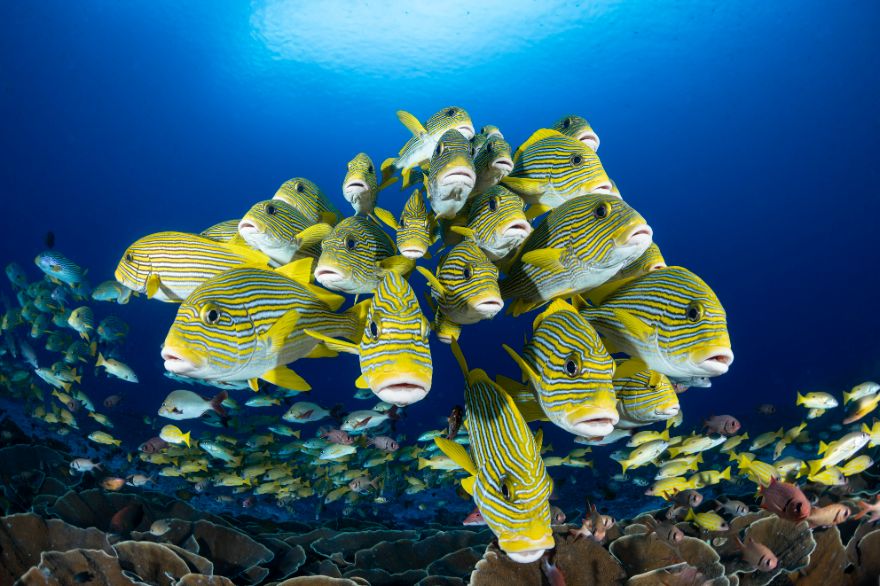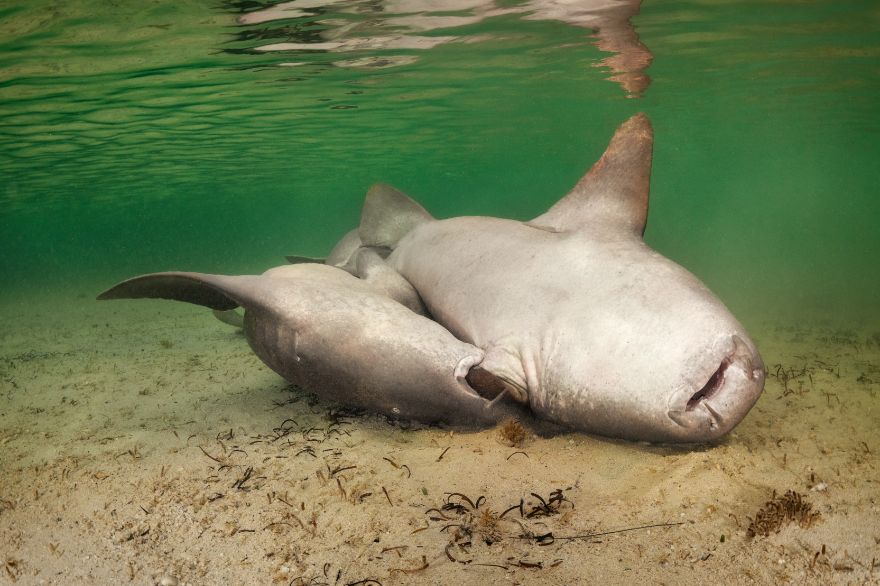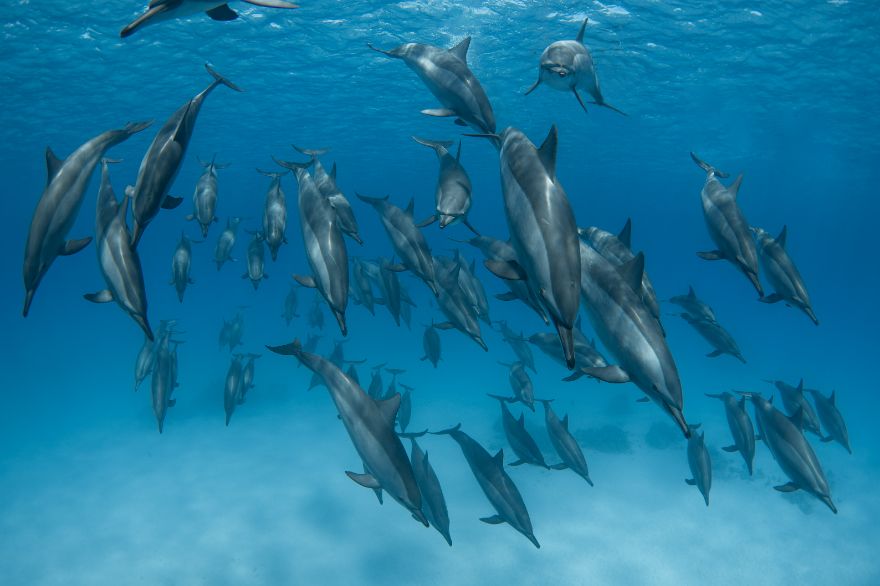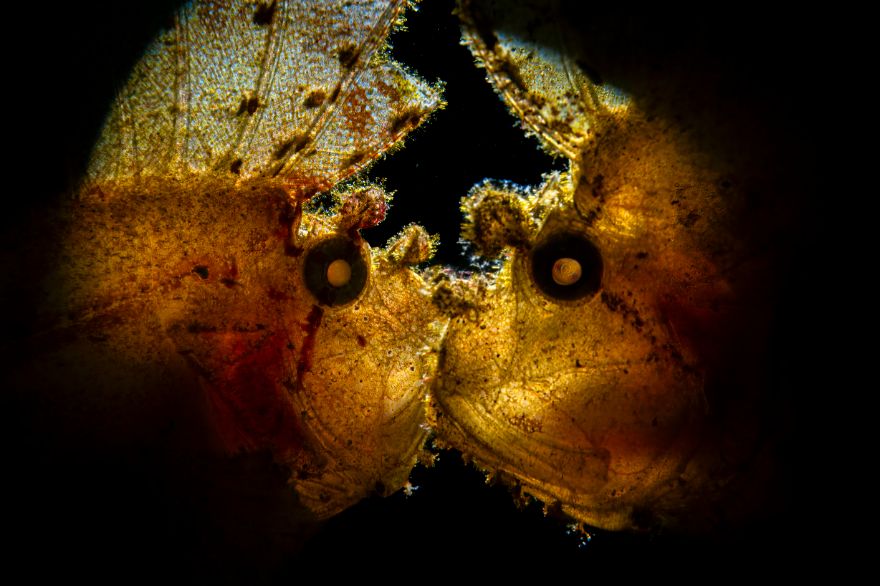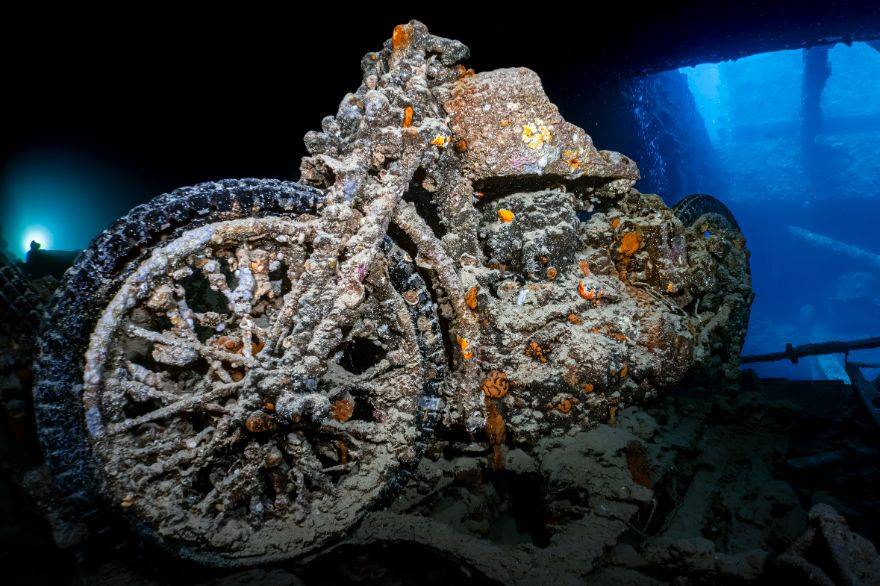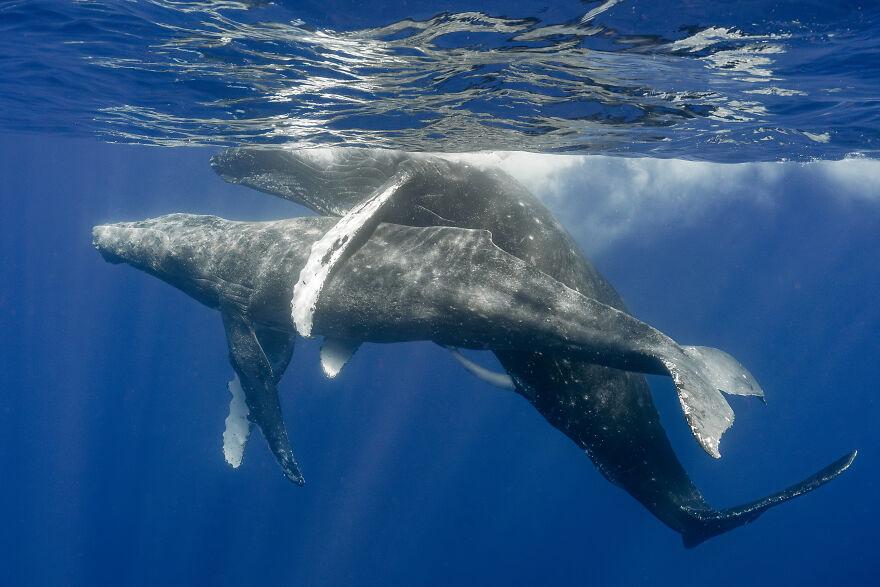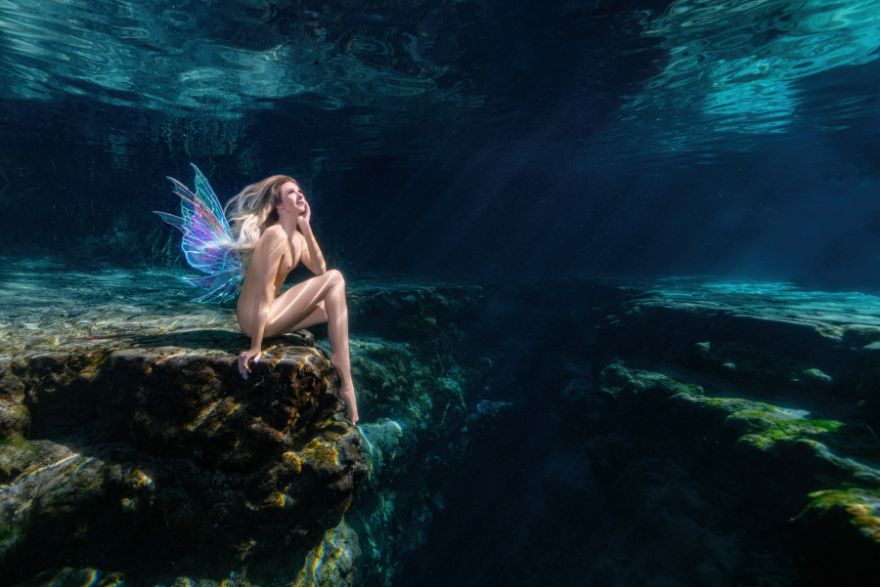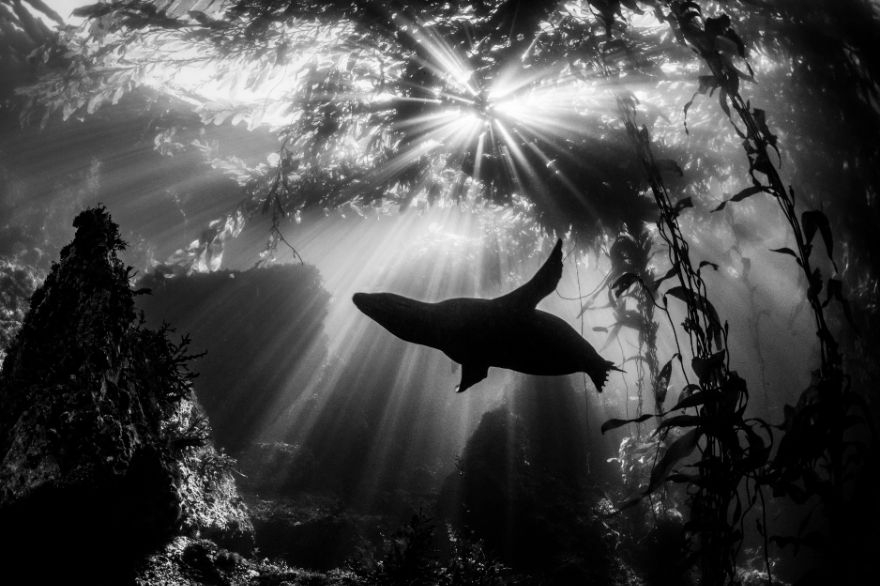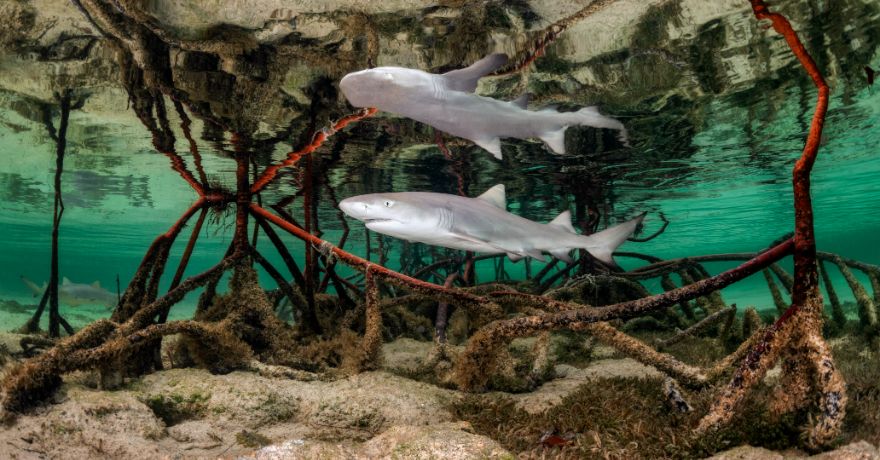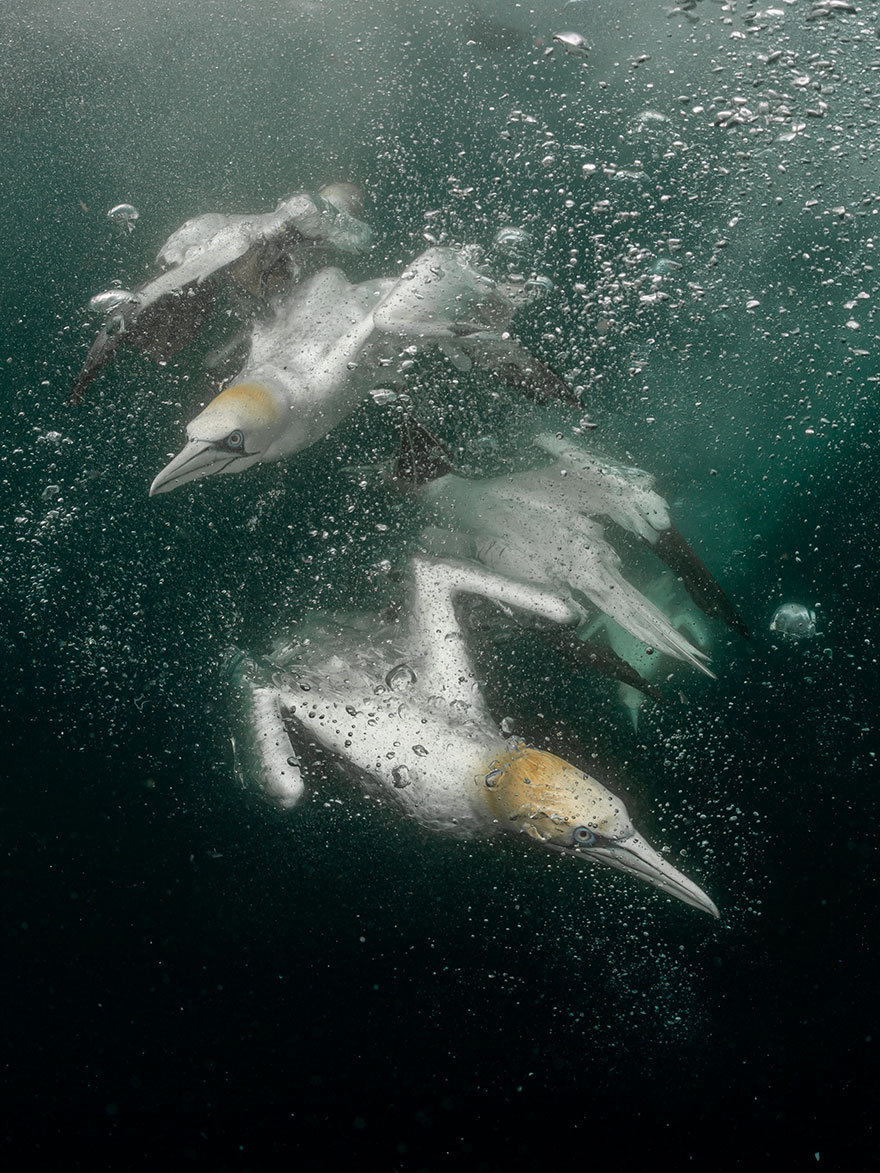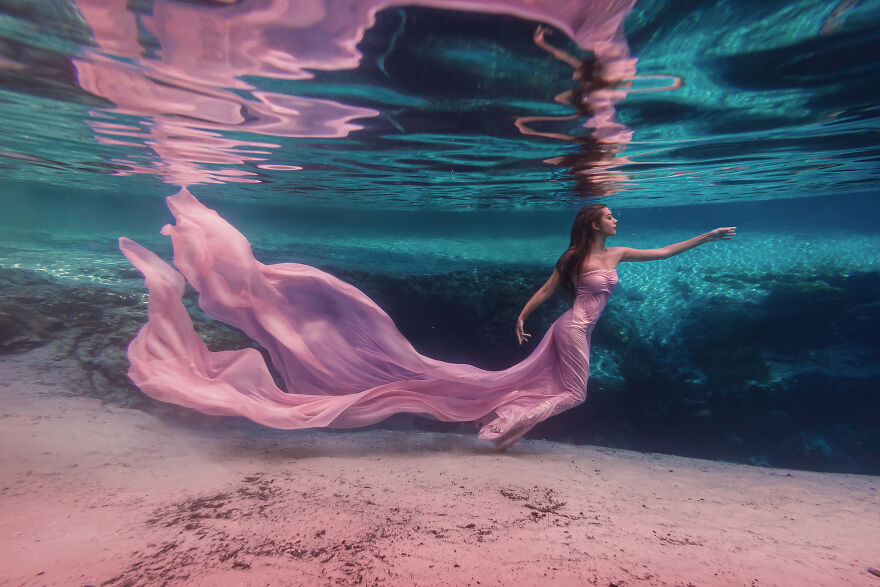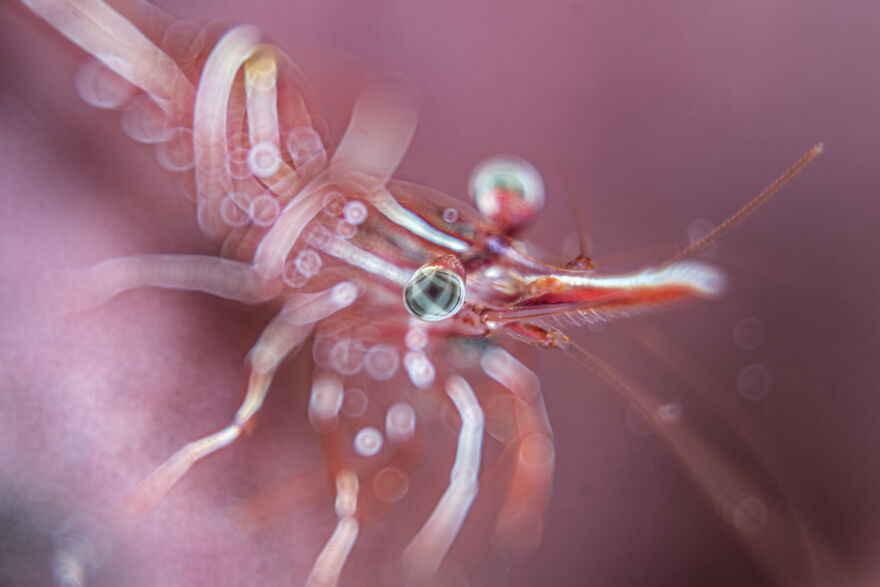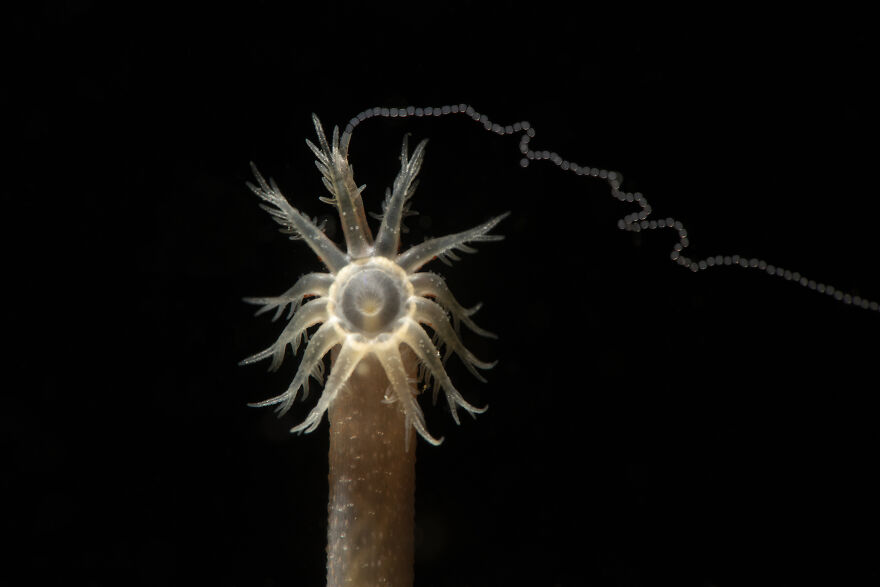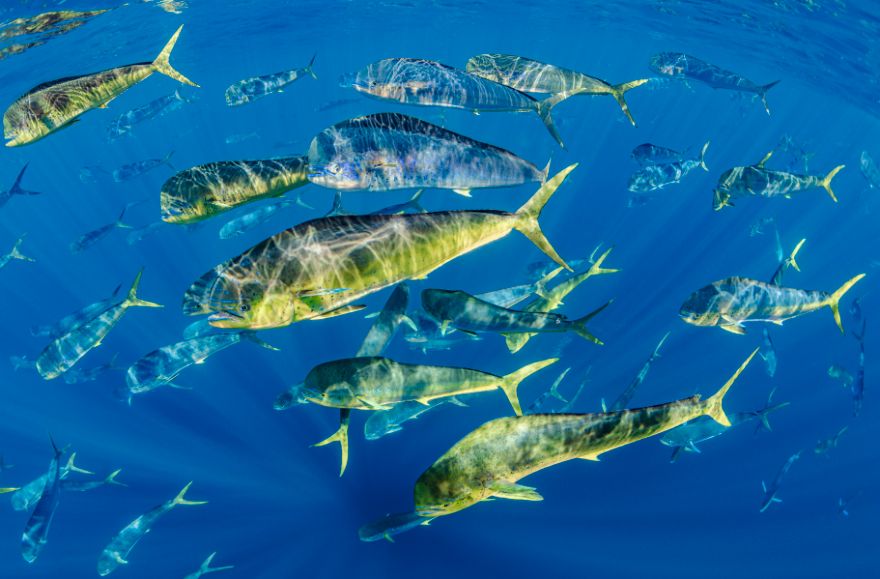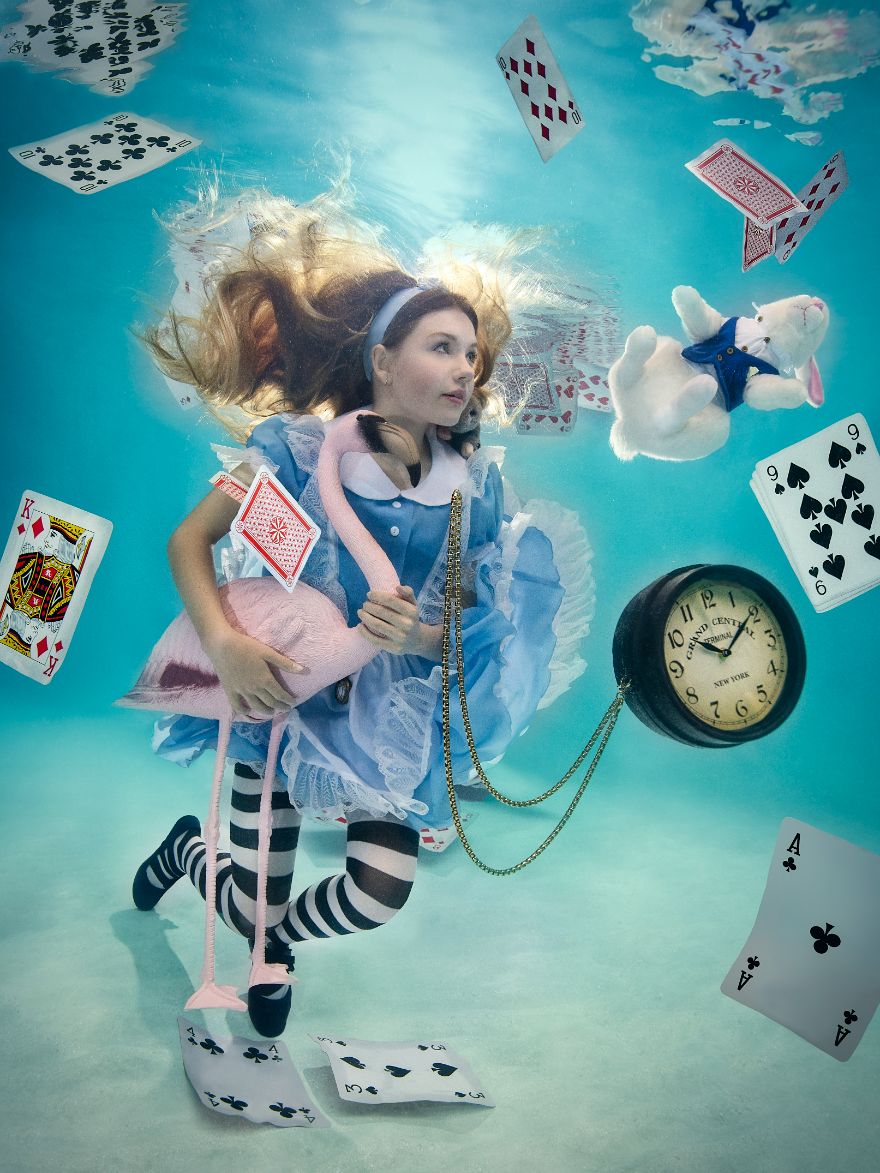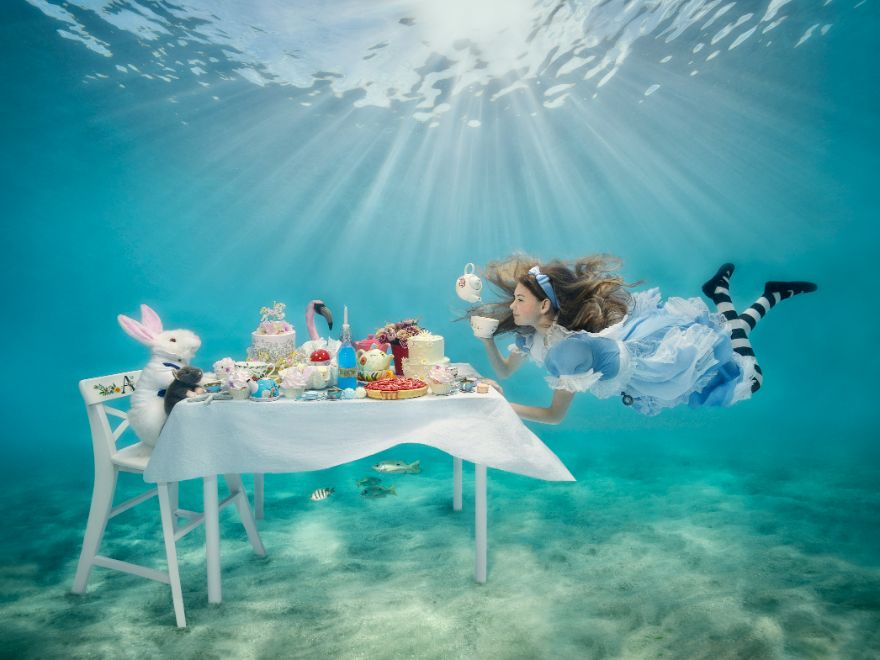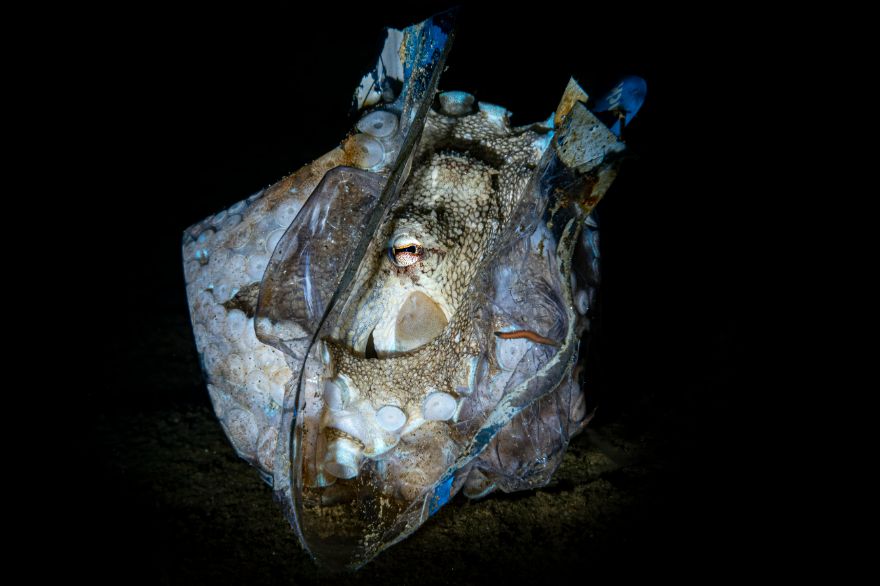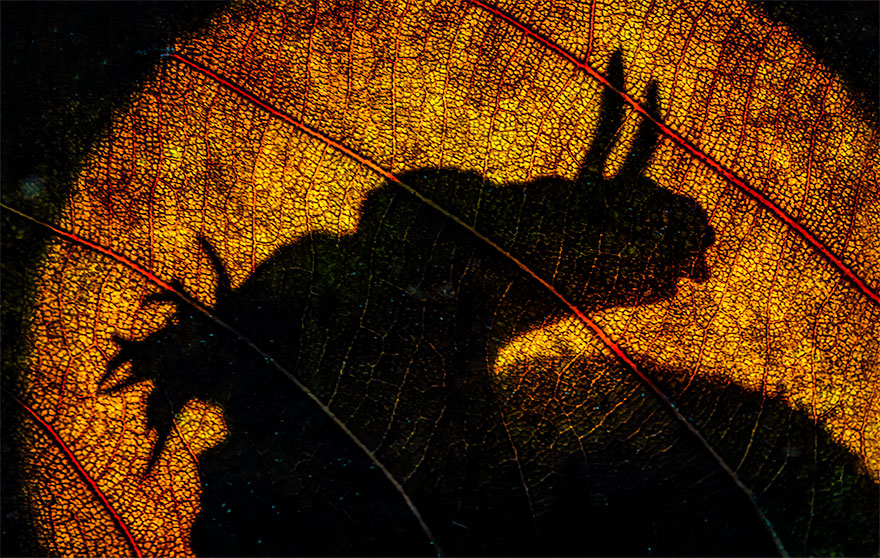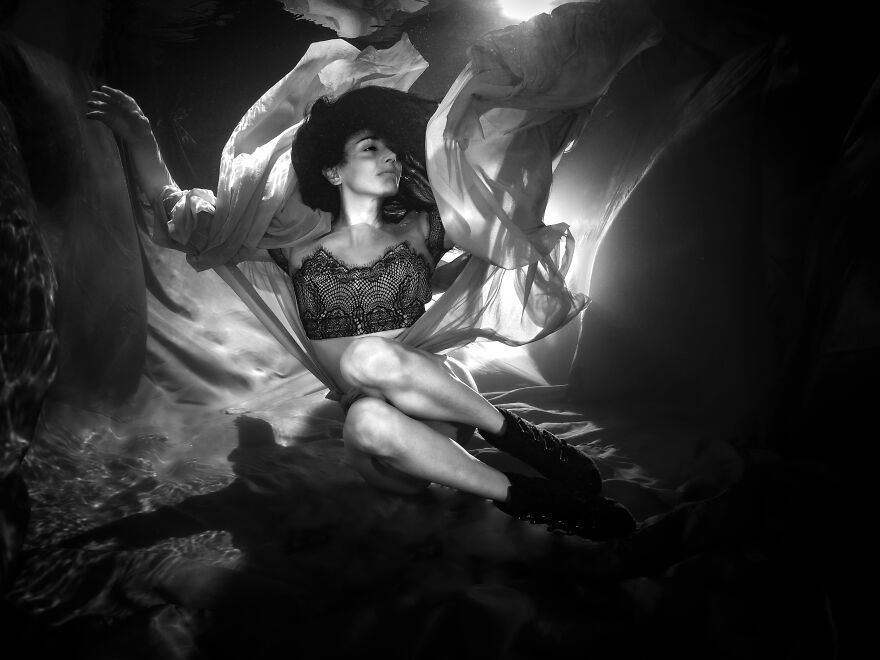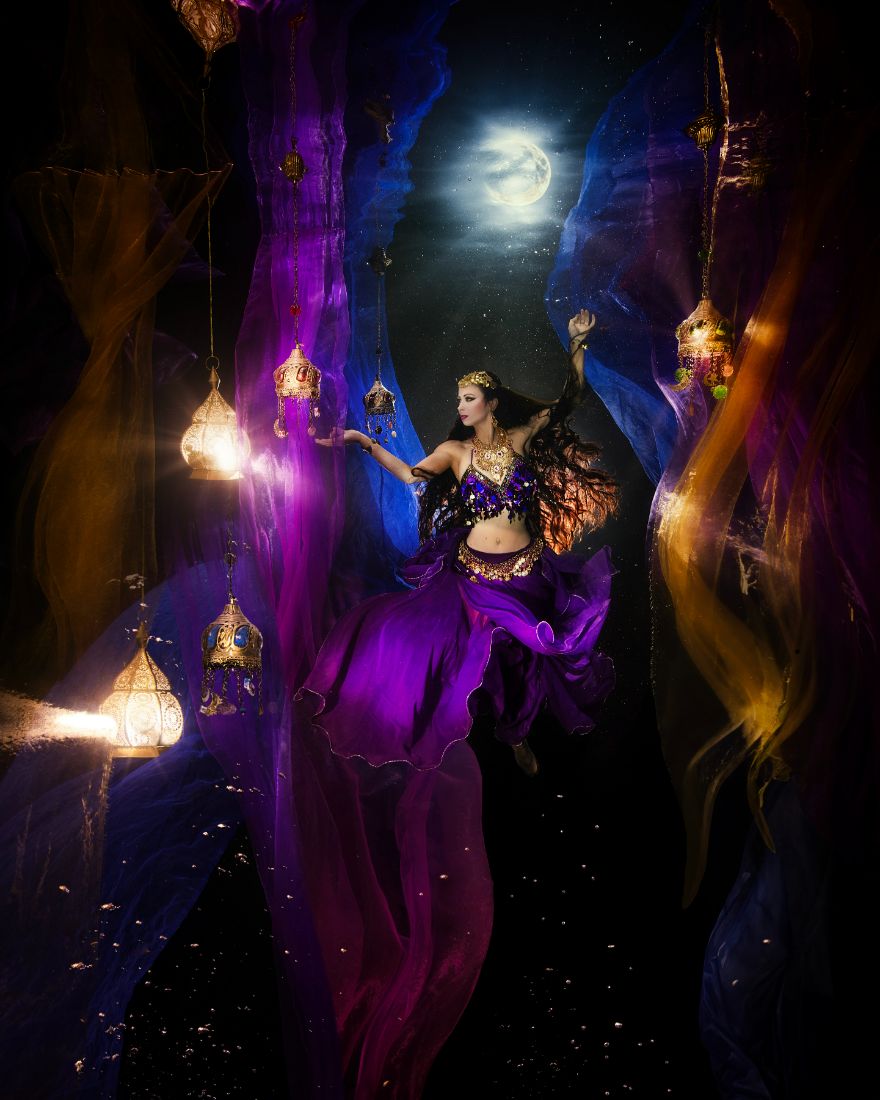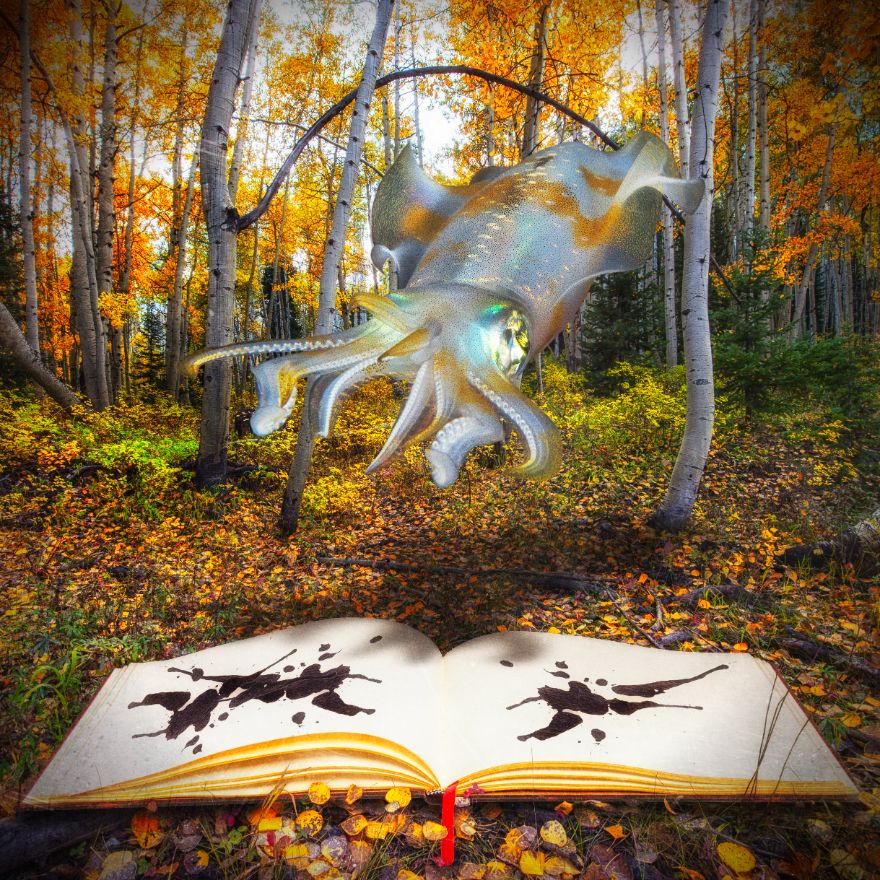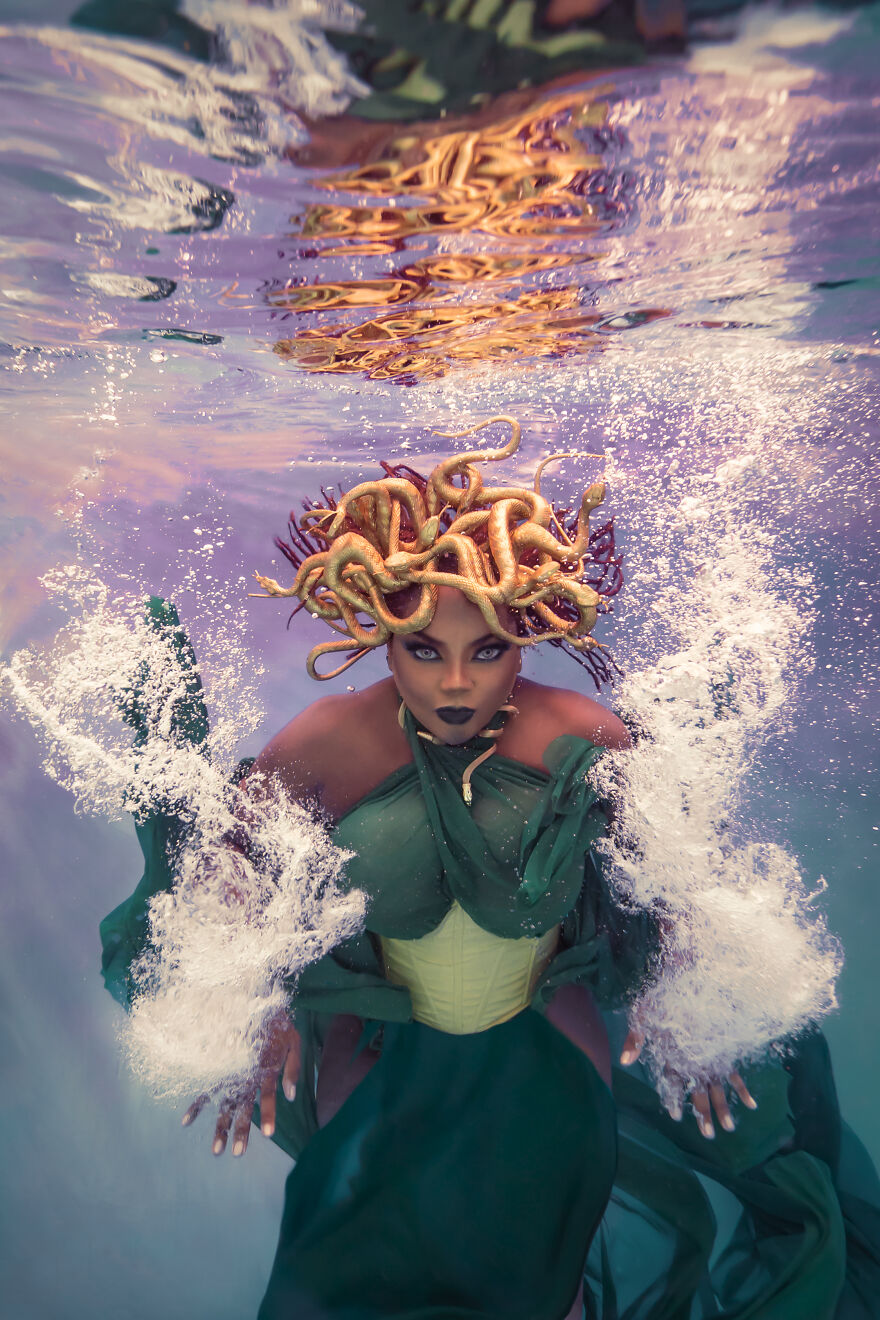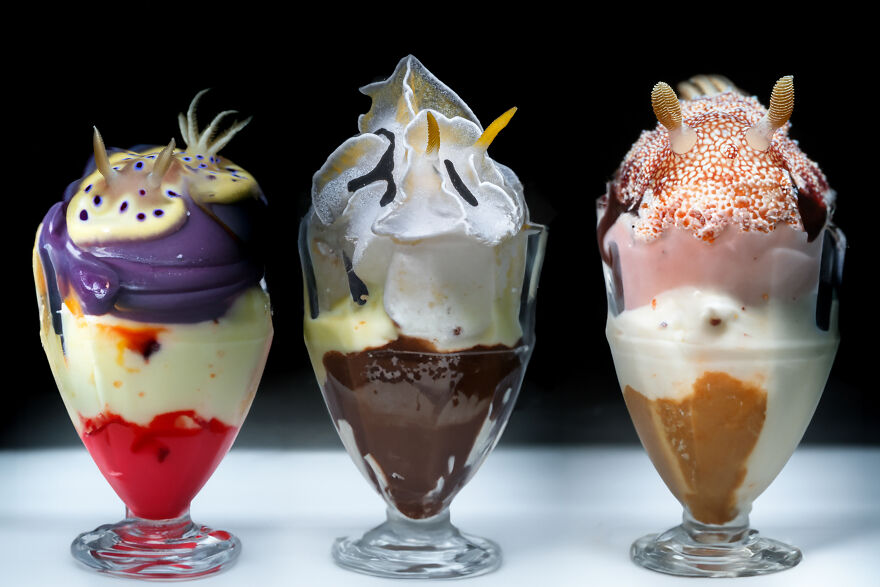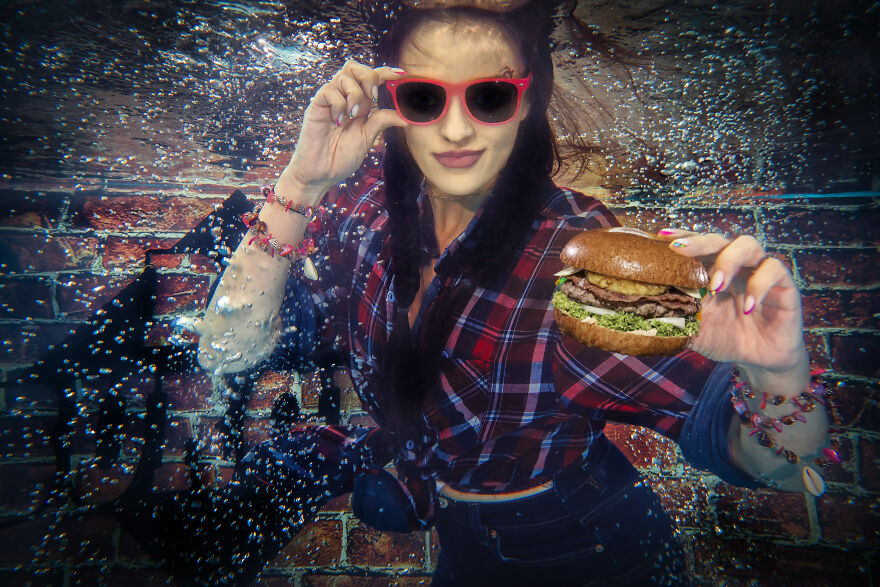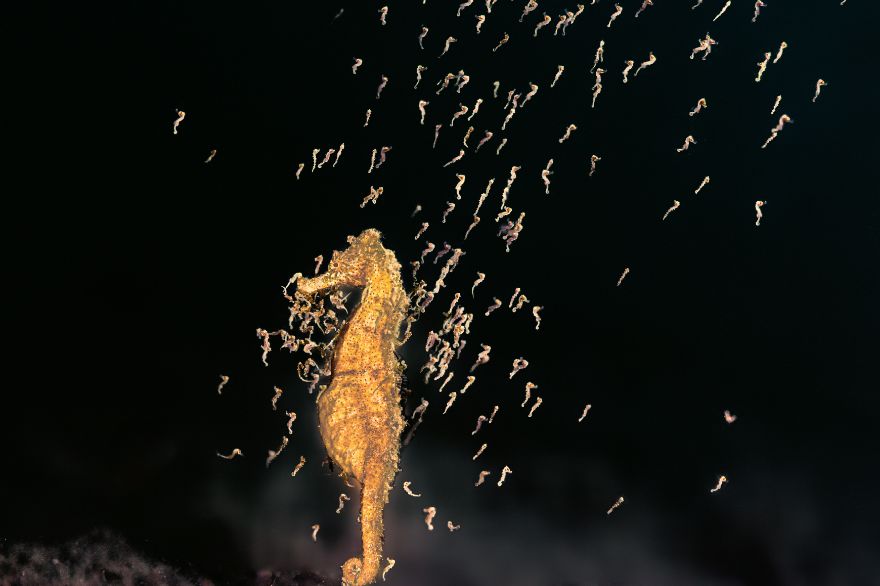Ocean Art Contest 2023: 72 Images Showcasing Never-Before-Seen Behaviors, Captivating Blackwater Scenes And More
The 2023 Ocean Art Contest winners have been announced by the Underwater Photography Guide! In its 12th year, the competition received images from over 90 countries, celebrating both evolving photography skills and technological advancements.
Winning entries showcased never-before-seen behaviors, captivating blackwater scenes, inspiring messages on ocean conservation, clever lighting techniques, and stunning animal portraits. With 14 diverse categories, the contest provided a challenging platform for photographers of all levels.
Keep scrolling to witness the breathtaking images!
More info: uwphotographyguide.com | Facebook | twitter.com | Instagram
East Coast of Central Sulawesi, Indonesia
“I let my wife choose our last dive of the trip, either an unguided shore dive or a boat dive. Although she loves wide angle sites from the boat, she picked the shore dive. It was because the house reef was on fire! Mimics and wonderpus were so common we stopped pointing them out. There was an explosion of ghost pipefish of varies types. So many different types of frogfish. I saw so many hairy frogfish, I stopped taking pictures of them. I was diving the house reef before sunrise and at night without my wife and she surprisingly, had not seen a hairy the entire trip. This last dive was a quest for us to find her a hairy. The dive did not disappoint. We saw so many different types of cephalopods including a, yawn, mimic. We came across a newly laid patch of squid eggs which strangely, had a seahorse attached. While shooting this unusual combination, a school of razorfish photobombed the picture. We were at the end of the dive when I spotted something that did not make sense. Why was a seahorse in the water column? I could not believe my eyes at what happened next. The seahorse convulsed and out came hundreds of babies. Shooting is always my top priority but I wanted my wife to experience this moment with me so I banged my tank with my muck stick to get her attention and missed the opportunity to fire off a couple of shots. I was able to get into position and got three shots at the male seahorse’s next release. My wife was now at my side and the current took the baby seahorses right next to her mask. There was one more release with just few more babies than the seahorse dropped to the ocean floor exhausted. I was so happy my wife was able to experience this once in a lifetime encounter with me. But we never found her a hairy frogfish.”
“Although the AI revolution has quickly changed the global photographic landscape,this year’s winners are a testament to humanity’s creative perseverance over machines. With new rules against the use of regenerative AI imagery in our primary categories, these photos are 100% real,” say the organizers of the Ocean Art Underwater Photo Contest.
Phi Phi Islands, Thailand
“During fieldwork at Phi Phi Islands, Thailand, spanning several weeks, I focused my efforts on documenting the maritime behavior of the Crab-eating macaque with particular focus on their water forages. The macaques have adapted very well to living around the sea and will venture into the water for various reasons including transportation, scavenging, cooling down and playing. Highly efficient swimmers, they can dive for up to half a minute and can cover short distances faster than most humans. This photo offers a rare glimpse of the swimming movement of a male macaque.”
Lembeh Strait, Indonesia
“I have photographed pygmy sea horses for many years, there are a few challenges to shooting them, first the eye contact. To have a relaxed specimen making double eye contact with the camera is very rare, secondly the polyps of the coral are usually closed. In order to get the polyps out I had to be the first person on this sea fan in the morning, I already knew this was a playful specimen from the day before so requested to dive the site at dawn when the polyps were out. And this guy is also pregnant and about to burst, so this trifecta of eye contact, polyps out and pregnant male made it the shot I have been after for many years. There was minimal editing, a little contrast, a slight rotation and very minimal crop were all that was needed, the subject speaks for itself.”
The top image of the year shows a special picture of a crab-eating macaque swimming in the ocean. Suliman Alatiqi took this amazing photo after spending weeks planning and documenting. According to the competition organizers, it symbolizes the passion and dedication required to capture the best underwater picture in the world.
Norris Rocks, Hornby Island, Canada
“As I immersed myself in the underwater world at Norris Rocks, I took my time to observe and try to understand the Steller sea lions aiming to capture more meaningful images. This image was captured when a beautiful sea lion swam up to me and stared tenderly into my eyes melting my heart. Steller sea lions are listed as Near Threatened on the IUCN Red List. With this image I hope to ignite a desire within people to protect these extraordinary beings and their ocean home.”
Noli, Ligurian Sea, Italy
“This photo was taken in June 2023 at the dive site: “Sabbione delle Meraviglie” in front of Noli in the Ligurian Sea. I immediately identified this cephalopod by its characteristic spotted coat. I have met these animals other times, but they usually tend to run away, however the defense behavior of this subject was different, in fact the animal opened its tentacles to appear more threatening by rising from the seabed with 2 tentacles and widening the other 6.”
Ocean Art 2023 is a celebration of always-changing photography skills and new technology. Nirupam Nigam, who is the Editor-in-Chief of the Underwater Photography Guide and a partner in Bluewater Photo and Bluewater Travel, supervised the competition. He said, “This year’s contest focused on how judges make decisions to choose the best underwater photos of 2023. It made us think about the essence of a photo, AI, and AI tools. The winners truly represent genuine photography.”
Tulamben, Indonesia
“Costasiella kuroshimae is one of the famous nudibranchs in Tulamben. It has a tiny cute face and beautiful eggs in a perfect circle. I spent two dives waiting for it to creep up to its eggs. It looked like it was defending eggs. If it was, it must be the cutest guardian of all nudibranchs.”
Lauderdale-by-the-Sea Pier, Florida, USA
“Summer brings calm seas to South Florida where a dedicated community of shore divers heads out nearly every day to survey for cool critters. I was signaled over by my friends, Dewalt and Evelyn who had spotted this lizardfish grappling with a challenge, its eyes perhaps larger than its mouth. The comically calm doctorfish steals the spotlight, displaying a remarkable defense mechanism with splayed pectoral and dorsal spines. Typically, in these images, the lizardfish is the star of the show, but in this case, I rotated the image to emphasize the doctorfish’s stoic demeanor, reminiscent of the ‘everything is fine’ meme.”
The Underwater Photography Guide is the top destination for everything related to underwater photography. It offers valuable tutorials, technique tips, comprehensive gear reviews, exciting international workshops, and the latest breaking news in underwater photography. UWPG is here to assist divers worldwide in reaching their photo and video goals.
Anilao, Batangas, Philippines
“I captured this image during a blackwater dive a few days after the Taal Volcano eruption in the Philippines in early 2020. This female paper nautilus was hitchhiking on a floating piece of wood debris in the extremely turbid water. It belongs to the octopus genus called Argonauta, one of the few octopi’s lineages that live in the open ocean. The females are unique in having evolved a shell for laying eggs. As I pressed the shutter, the surrounding particles reflected my flashlight in a manner that created the illusion of falling snow. For blackwater photography, we like to place the strobes in an angle and position where the light can shine directly on the subject, ensuring a clean dark background. However, when I initially attempted to capture this Argonaut, I was unaware that the strobes were placed in a “wrong” position. The light was shining on the space between the subject and my camera, which had illuminated the presence of all the surrounding particles. Instead of portraying chaos in the aftermath a natural disaster, these particles evoked an unusual sense of serenity, transforming the scene into a fairytale set on a snowy night.
Blackwater photographers are obsessed with clear water. We are drawn to the pure darkness that mirrors the vacuum of outer space. We tend to forget that the suspended particles which include the sand grains, organic matter and even miniscule organisms are an integral part of the ecosystem. These particles always fade into the background or are simply removed through editing, but they form the foundation of the complex marine food web. If the water were genuinely transparent, there’s no way the ocean could sustain such abundance of life. The “snowflakes” in this captured scene always remind me of these tiny yet ubiquitous existences.”
Anilao, Batangas, Philippines
“In the past two years I dove in Anilao on three separate occasions. We encountered this species on our first tour and were delighted to find that they were mating. My two diving buddies busied themselves with the nudibranchs, and by the time it was my turn I had no air left. I hardly hoped to get a second chance to observe this special event. But on our third tour I cought them ‘in flagranti’.”
Crystal River, Florida, USA
“During the chilly winter months in northern Florida, West Indian manatees congregate in the crystal-clear natural spring waters to keep warm. Temperatures in the surrounding rivers can drop dangerously low so the aquifers act as safe havens where they can rest and raise their young. Manatee mums nurse their calves from just beneath their armpits until they are strong enough to strike out on their own. Over the years I have witnessed what wonderful parents they are, tending to every beck and call of the little ones. This tater tot must have been hungry because it spent most of the day attached to mom! I have also heard that calves hang on to hitch a ride if they are tired of swimming for the time being. The juvenile manatees are very curious, often coming right up to you as long as you are calm and find a respectable distance to patiently observe. The mother will typically swim over and scoop them up if they are getting too close to divers in the water. The springs must be a whole new world for them out there to explore, and I am so thankful for the encounter this year.”
Mornington Peninsula in Victoria, Australia
“Every year thousands of Giant Spider Crabs come into Port Phillip Bay for their annual molt. They gather in large numbers and shed their old exoskeletons. Once molted they double in size while their new shell hardens over the next couple of days. During this time, they are vulnerable to predators, so they gather tightly in large numbers to reduce the risk of being eaten. This freshly molted Giant Spider Crab stands in front of a group of crabs yet to molt, allowing me the opportunity to take a portrait shot.”
Raja Ampat, Indonesia
“We found this young whale shark during a diving trip in the south part or Raja Ampat National Park. He spent hours circling around us feeding on small schooling glassfish. I took this photo a few seconds before he vanished in the blue, with the white spots of its livery drawing the silhouette like a constellation.”
Manado, Indonesia
“I have seen many larval snails over the course of several years of blackwater diving, but on one particular dive in Manado, Indonesia this particular gastropod caught my eye. I had never seen one so colorful and dazzling before. The snail was in constant motion, but occasionally it would spread out symmetrically in full display for just a brief moment, displaying like a piece of underwater art. As I photographed it for several minutes, I was fortunate enough to able to capture one such pose with this photograph.”
Roca Partida, Mexico
“Whitetip reef sharks are one of few shark species that rest in place. At Roca Partida, a small island, real estate is limited for the many whitetips that live there and they can often be seen bunking together. I wanted to get a photo of all of them facing me and with a lot of patience and a careful approach I managed to do so.”
Male, Maldives
“I haven’t seen whale sharks for the longest time. Maldives are known for encountering Whale Sharks. I was very lucky on the first day as I manage to see a few. This one particular whale shark was very friendly. It kept circling around me as I had all the small fishes attracted to my focus lights. I guess for him it was a free buffet as the planktons were a lot that night as well. I stayed there for about an hour until dawn as I wanted the golden light to reflect on the small fishes and it paid off!”
University of the Virgin Islands, U.S. Virgin Islands
“Most corals spawn once a year in synchrony by using several environmental cues. Due to the ongoing degradation of coral reefs, many surviving corals of the same species are now spaced too far apart on a reef for successful fertilization to occur. At the University of the Virgin Islands, coral researchers temporarily removed several grooved brain corals from reefs surrounding the U.S. Virgin Islands and brought them into a land-based coral nursery, where they’re spawned in controlled conditions. These techniques allow researchers to collect sperm and eggs from several corals efficiently and fertilize them in the lab, where they can be grown and eventually outplanted back to the reef. After spawning, the corals removed from the reef are placed back to the same reef which they were collected from.
This technique of assisted fertilization is also sometimes called assisted evolution. The corals inside this table have survived several prior bleaching events, hurricanes, and disease outbreaks, such as the devastating Stony Coral Tissue Loss Disease. This means that these individuals may harbor essential genetics, making them more resilient to several environmental stressors that kill corals. By spawning and crossing these survivors, it’s hoped that this may lead to more robust and resilient corals better equipped for the future environmental parameters of our oceans.
Just before they’re expected to spawn in the nursery, the water flow is turned off, bringing a calmness to their environment and creating the perfect opportunity to shoot the reflection of the corals in the still water surface. With the corals-filled nursery, I only had a few locations to slip my camera in. Fortunately, this vantage point gave me lots of depth to work within the nursery.”
Lobster Shack, Coronado Islands, Mexico
“California sea lions are born in early summer in the Coronado Islands. Play is very important in their development. By late fall they have grown to be very confident in the water and can often be seen play fighting each other. I watched these two pups swirl around together and playfully bite each other. For now, it is all for fun as they learn skills that will help them later in life.”
Magdalena, Baja California, Mexico
“Each November, sardines aggregate offshore the Mexican west coast. This in turn attracts many predators. Working with a local fisherman, we search the deep water offshore near the continental shelf and we spotted a lonely sealion. The sealion was chasing the sardines and the ball was constantly changing shape as the sealion broke it up.”
Playa del Carmen, Mexico
“I was experimenting with my new Marelux Snoot in a Playa del Carmen reef, about 10-12 meters deep. After a while, I spotted a peacock flounder (Bothus lunatus) on the sandy seabed—a common fish in the area. Initially, it seemed wary of me and my photographic equipment, attempting to evade my presence. However, I carefully trailed it until it grew accustomed to me and my gear. Suddenly, it came to a halt and began surveying the surroundings. While adjusting my snoot and focusing to capture the perfect shot, I managed to take five shots as the flounder patiently waited for me to get it right. Eventually, it darted away and disappeared into the vast ocean. This particular shot is one I consider myself fortunate to have captured, as the flounder allowed me to capture its essence.”
Miura Peninsula in Kanagawa Prefecture, Japan
“Black cardinal fish live in shallow coastal waters, and males raise eggs they receive from females in their mouth (mouth brooder). The eggs hatch in about a week. Until they hatch, males stay still behind a rock and feed the eggs with fresh seawater. At first, I did not know when the eggs would hatch, but after a few observations, I could tell when the eggs would hatch. Hatching occurs within a few hours after sunset. At the moment of hatching, the father swims upward and spits out the babies in an instant. So, it’s difficult to take a picture.
It is said that the number of fries in a single hatching is about 20,000, so the moment of hatching is quite impressive. As soon as the babies hatched, they scattered all over the place. I hope that many of the fry will grow up and survive next year.”
Anilao, Batangas, Philippines
“I found this Favorinus tsuruganus, along with its eggs, on the egg ribbon of the Spanish dancer (Hexabranchus sanguineus). This image captures a stark contrast between nature’s beauty and its harsh realities. The bright colors and intricate designs of the nudibranchs are captivating, but they hide a harsh reality. The nudibranch in the foreground is feeding of the eggs of another of its kind: the ribbon of purple eggs laid by the Spanish dancer fell prey to the Favorinus tsuruganus, which also deposited its white eggs on top.
This scene illustrates intraspecific predation, a phenomenon where an animal consumes another of its own species, typically targeting the eggs or the young. Shooting this image required a great deal of patience, as the constant movement of the purple eggs, caused by the undertow, obscured the nudibranch and its eggs. After some attempts, I succeeded in capturing this vivid portrayal of the ‘circle of life’.”
Mayotte Indian Ocean
“Tursiops dolphins living just below the surface in the Mayotte lagoon. This photo shows them as a family and as social animals with a hierarchy. The best place to see them is in the Ocean. It’s a magical encounter when they accept you in their environment.”
Anilao, Batangas, Philippines
“I noticed the paper nautilus riding on the jellyfish at the end of our dive. I had 30 bar left on my tank. I took some photos and then I exited the water.”
Bunaken Island, Sulawesi, Indonesia
“During my years in Jakarta, Lembeh emerged as our prime spot for critter and macro photography. On a particular expedition, we extended our journey to the islands of Bangka and Bunaken. Little did we know, Bunaken is home to a sizeable green turtle population.
During my years in Jakarta, Lembeh emerged as our prime spot for critter and macro photography. On a particular expedition, we extended our journey to the islands of Bangka and Bunaken. Little did we know, Bunaken is home to a sizeable green turtle population.
A 90mm macro lens would not be my first choice to photograph turtles! My previous attempts at capturing close-ups of turtles, when I have been lucky enough to find one have always been thwarted. Invariably I have found them skittish despite my cautious approach. With this in the back of my mind, I focused on critter hunting along the wall, as the rest of my party enjoyed the turtle activity and what seemed like endless turtle fly-bys.
As luck would have it towards the end of the dive, I spotted a large green turtle nestled in the wall. It seemed to be observing us from afar and showed no signs of swimming off. With slow movements I managed to get within macro range and cautiously maneuvered my camera into position waiting for the right moment. To my surprise the turtle turned its head and gazed directly into the camera as if to check me out. As its eye came into focus, I paused; me looking at the turtle, the turtle looking at me…click… it was done.
On the dive that I obtained this shot, there were only 3 divers in our group, all highly respectful of marine life. This was a unique moment for us all where the turtle was clearly comfortable around us and not skittish in any way allowing me to capture what for me is one of my favorite shots which says ‘Eye See you’.”
Florida, USA
“Over the past seven years of studying juvenile manta rays in Florida with my partner, marine biologist Jessica Pate, capturing images that illustrate the impact that our world has on these rays has been a priority for me. Easier said than done. Photography usually takes a backseat to science during our field days and Florida’s mantas do not behave like mantas elsewhere in the world. They are seldom seen on traditional dive sites and are sparsely populated. On this occasion I was lucky to encounter a tolerant individual in shallow water, which allowed me to capture this split shot of a mansion looming over a juvenile manta named Cricket. Manta rays are listed as endangered by the IUCN, and are listed on the US Endangered Species Act. While they are protected from harvest in Florida waters, they still suffer many anthropogenic impacts along our densely populated coast. Twenty five percent of the rays in our study have been sighted while entangled in fishing lines and eight percent have suffered boat strikes. Further, it is hard to say what impacts coastal development and pollution have on these rays. As the first dedicated long-term study of Florida’s manta rays, our Florida Manta Project team seeks not only to gather baseline scientific information, but also to conduct outreach and conservation to protect these rays. This includes educating the public about best practices for fishing around mantas, boating in their vicinity, and limiting disruptive in-water activities like tourism that could negatively impact this vulnerable population. “
Bali, Indonesia
“For the first time in what felt like a lifetime, I was back in the water. After the years of restrictions and being separated geographically from my passion, I booked my ticket and headed to Bali. It was a rush, feeling the sensations of those first few dives, but also being reunited with my well-worn camera and housing.
The northern shores of Bali have always held a special place in my heart, so naturally I wound up there. After doing several dives around Amed, I found a great dive shop and did a few exploration dives with them. On one of the dives, I found this decorator crab on an enormous barrel sponge at the bottom of a barren slope. Sitting at roughly 30m and completely shrouded in darkness, owing to the depth and overcast conditions, this usually nocturnal species of crab was perched relatively exposed.
I have had an idea for a few years now to use a pair of snoots on this type of subject to backlight and isolate the anemones on its back, while using just a touch of light to illuminate the eyes and “face.” While it took a few shots and some adjustments – especially to get the subject’s eyes in focus, the hardest aspect was to isolate the subject from the background of the barrel sponge.
Finally, after a lot of twisting and turning the camera to get the background out of the photo and the subject in frame with the proper lighting, I left this crab to continue its exploration of the sponge- having happily taken some photos showing the beauty of this tiny and cryptic animal.”
Japan
“I collect and photograph floating creatures at night, Bonfire style. Many squid and shrimp will gather in the underwater torch. The squid in the photo is known to be the smallest in the world, and the pygmy squid successfully preyed on a shrimp as large as its own body. Pygmy squid eat shrimp by inserting their mouths into the gaps between their shells.”
Reunion Island
“During a night dive on Reunion Island, I saw a huge Spanish dancer. And when I looked closer, I noticed that there was an emperor shrimp hidden in its gills!
I was happy because it’s the first time I’ve seen this association on a dive on Reunion Island (rarer to see it than in Indonesia!).
I tried to put my camera at gill level to get the black background. The shrimp was just above her head, giving the impression that she was in the middle of flames!”
Porta Lake, Tuscany, Italy
“In the photo, an Italian green frog is seen devouring an insect, specifically a scolopendra. This remarkable moment occurred during lunchtime at Porta Lake, a protected natural area—a muddy swamp teeming with aquatic plants, insects, and amphibians located in Tuscany, Italy. I couldn’t believe my eyes as I witnessed this unique and swift scene unfold. The entire sequence lasted only a few seconds. In an instant, the frog skillfully captured and consumed the scolopendra, resulting in a sophisticated yet fortuitous photograph!”
Lembeh Strait, Indonesia
“While I was on a blackwater dive in Lembeh, Indonesia, I noticed a bright pink worm swimming by me. Since I hadn’t seen a worm of this color before, I stopped to snap a few shots. It was only after I went and looked at my photos afterwards that I realized the pink coloration was due to the worm’s eggs, and it was releasing them into the water column!”
Anilao, Batangas, Philippines
“We found this flying gurnard near the surface at the end of a blackwater dive in Anilao. I count myself exceptionally lucky, since this fish is very rarely seen on the surface. The unusually calm sea made it possible to take a photo of the gurnard’s reflection. I have tried to take a picture of a sea creature and its reflection a few times before, but was never satisfied. This time, as I looked at the LCD, I momentarily thought I had found two gurnards…”
Quarry Westbruch near Leipzig, Germany
“Every year in the spring time the sunbass are mating. At this time, I got a chance to get close to them. Normally they move away. For this shot, I was using a wide-angle macro wet lens, the Nauticam EMWL 160 degrees field of view. I attached this lens to my compact camera and it works great.”
Mornington Peninsula, Australia
“In the shallow waters of Naarm (Port Phillip Bay), sparse colonies of Tubular Hydroids poke their heads out of the sand in cold, shallow water. There are hundreds of individuals, but at just 4cm or so tall it’s easy to dismiss these tiny animals which are endemic to the Great Southern Reef of Australia. Each individual here is either male or female and extend their outer tentacles to catch passing plankton.
Blairgowrie Pier is a sheltered site, well known to local divers for the spectacular colours of sessile and invertebrate creatures. After 90 minutes in 12°C water, my fingers were becoming numb. Usually, I exit the site at the dive platform, but this time I began a shore exit, noticing tiny hydroids on the sandy bottom. After inspecting several groups, I chanced on this beautifully arranged colony of ‘Underwater Fireworks’. Trying not to disturb the sand was challenging in this environment. I watched the tentacles move delicately in the water, making small adjustments until I was happy with the composition.”
Everglades National Park, Florida, USA
“Exploring new environments, especially seldom visited ones, is one of the greatest pleasures of underwater photography for me. The Everglades is a rightfully foreboding environment, but also one of great beauty and interest. To capture this image, I was careful about avoiding risks, like alligators, in the area that I was snorkeling. Shooting with my GoPro made getting the camera close to my subjects easy. In this frame, I sought to capture a beautiful, native, Florida Gar against the backdrop of a cypress dome with light rays filtering through the trees. As a fish nerd, observing the many beautiful species that call this environment home is another joy. This image also features native largemouth bass in the background. Although not featured here, many of my frames from this day of shooting also captured invasive fishes, illustrating just one of the many impacts human actions have had on this imperiled ecosystem.”
West Palm Beach, Florida, USA
“Larval-stage jacks sheltering in various species of jellyfish are somewhat common in blackwater diving off coastal Florida, and after shooting them countless times over the years, I nowadays hunt for both quality and quantity. The quality comes from a jellyfish that is perfectly round, with aesthetically perfect tentacles, with an unbroken bell, and the quantity comes from the number of jacks living within it – the more the better, and while one or two is the norm, nine is exceptional! Always striving to “do no harm”, I’ve learned that with these particular subjects, the jacks may be somewhat resistant to the jelly’s sting, but definitely not immune. I therefor limit myself to 2 or 3 rapid shots, then I avert my lights and swim away, so as not to disorient the jacks, causing them to bump into the tentacles. Similarly, I’ve learned the best way to approach, is to immediately shut off all but the dimmest light upon locating such a subject, and approach with only the bare minimum light needed for the camera to focus by. To the best of our knowledge, this is commensalism symbiosis, wherein the jacks receive the benefit of a dangerous shelter while drifting through the open ocean as they mature, but the jellyfish is neither helped nor harmed.”
Anilao, Batangas, Philippines
“I noticed this clownfish kept coming back to the same spot, and when I looked closely I found there were babies. The parent clownfish nurtured them using its pelvic fins. I used Backscatter miniflash with a snoot just to highlight the eggs and the face of the clownfish.”
Magdalena Bay, Mexico
“When I went out to sea in the morning, I passed a small island and saw the fishermen on the island cutting up the sharks and tossing the useless parts on the beach. When I was back from diving in the afternoon, the abandoned parts were washed into the sea due to the high tide, allowing me to go underwater and capture this heartbreaking scene. I hope that through this photo, more people can work together to protect sharks. There will be no killing if there is no trading.”
Reunion Island
“Bornella anguilla is a very elegant nudibranch, well known for its capacity to swim like an eel, hence its name. It is not common where I live so I was delighted to find it during a night dive, seeing it moving and raising its head as is pictured in this shot. The night conditions and a fast shutter speed helped me get a black background, which puts the slug’s colors and patterns in their best value.”
Sea of Cortez, Mexico
“I came across this Gulf Signal Blenny (Emblemaria hypacanthus) displaying frequently on a dive in the Sea of Cortez. After approaching slowly I positioned my snoot so as to backlight the fish when its dorsal fin was fully unfurled. After just 3 attempts I was rewarded with this image.”
Vattern, Sweden
“Birds play a crucial role as scouts for underwater activities, and this holds true for the small creek I’ve been observing for days in anticipation of spring spawning. The signal to enter the water came during a confrontation between goosanders and brook lamprey. The spawning event unfolded within a compact one-square-meter area over a couple of hours. The scene resembled a chaotic ball of yarn, presenting the challenge of capturing a simplified composition.”
Sund Rock, Hoodsport, Washington, USA
“While GPOs are a common sight here in the Pacific Northwest, seeing a female nesting is rare enough that when someone does find one, word of mouth spreads quickly. In this case, my dive group had heard a couple nests were found at Sund Rock, an excellent site for finding GPOs in general. Since their dens tend to be in crevices and cuts in the rocks, getting a well-lit and well-composed photo with a large full-frame camera can be difficult (and risky if you’re shooting with a dome). Although the female will spend months caring for her eggs, we can never predict when they’ll hatch and she’ll die. I was intent on making the most of my opportunity since it may have been my only one.
Therefore, I decided to bring my TG-6 instead of my normal SLR. With the smaller form factor and very short minimum focusing distance, I was confident I could get the camera and the strobes close enough to capture a striking image. It turned out to be a good call because this particular nest was tightly ensconced in a pile of rocks. I captured a series of close-ups of the mama octopus circulating water through her eggs before getting distracted by another GPO wandering out in the open. This specific image best portrayed the tightness of the quarters and balanced the mama and her eggs. From the RAW file, my edits were focused primarily on boosting the contrast to make the colors and textures pop.”
Papeto’ai, Mo’orea, French Polynesia
“Professor Jodie Rummer releases a newborn blacktip reef shark (Carcharhinus melanopterus) in Mo’orea, French Polynesia, after tagging it, and collecting biometric data. Professor Rummer leads Physioshark, a research team headquartered at James Cook University in Australia that investigates the impact of climate change on the physiological performance of newborn sharks in tropical shark nurseries. These habitats typically occur in shallow waters and are therefore highly exposed to rising temperatures and lower oxygen concentrations. Scientists are untangling the challenges newborn sharks face in such rapidly changing environmental conditions. Professor Rummer and her students have so far been able to show how despite the burden climate change is placing on the physiology of young sharks, these are displaying an exceptional resilience to these changes, giving scientists hope that they will be able to adjust to a warming ocean.”
Seattle, Washington, USA
“Pacific spiny lumpsuckers make for fascinating macro subjects. With every color variety imaginable (we adoringly refer to them as “flavors”) and their large, expressive eyes, one could spend an entire dive following a single individual as they hop and hover around the dive site. Lumpsuckers are particularly difficult to photograph since they are little bundles of energy who are constantly searching for the perfect perch on which to rest. They have specialized pelvic fins that create a modified suction cup, allowing them to anchor themselves to kelp and various debris on the ocean floor. My favorite thing about lumpsuckers is that they are very picky with what they will and will not hang on to. Watching them land on an undesirable object never ceases to make me laugh, causing my mask to flood. They tend to suddenly shoot straight up and away in the water columns when this happens – Safely floating back down elsewhere!”
Raja Ampat, Indonesia
“In Raja Ampat, there’s a dive spot that holds a special place in my heart. Near the village of Sawandarek, at approximately 30 meters depth, lies a magnificent cluster of Turbinaria coral. Thanks to its substantial size, numerous fish species congregate here, finding shelter effortlessly among the coral formations. Among the diverse species, a small group of Sweet Lips is often encountered, and with a bit of patience and skill, they can be approached quite easily. Moving in slowly, I managed to capture them in a picturesque setting, surrounded by many other fish and the stunning blue hues of the water.”
Eleuthera, Bahamas
“The mating ritual of nurse sharks is quite violent! A male shark will grab onto the pectoral fin of a female and try to flip her over to her into a state of tonic immobility. Female nurse sharks end up with many scars from the mating process. Though the timing of the mating period for nurse sharks is difficult to predict, we found a few male nurse sharks chasing females around on the first afternoon that I was in Eleuthera. This was the only mating attempt I saw that ended successfully for the male, and we did not see any other mating attempts for the rest of the trip, so I was lucky to get this chance!”
Sataya Reef, Marsa Alam, Egypt
“While on assignment in Marsa Alam, Egypt I was fortunate to capture this family portrait of a local pod of nearly hundred majestic spinner dolphins. Known for their acrobatic displays, they exhibit intricate social behaviors that strengthen group cohesion and communication, indicating a high level of social intelligence. While respecting their boundaries, I observed and photographed the pod coming in for a closer look at that strange human object hovering in front of them, resulting in this photograph. Ever so thrilled I was seeing the capture afterwards. A mind-blowing, emotional and humble encounter never to forget. One of those precious and ever so intriguing ocean moments where you forget who is actually investigating who.”
Puerto Galera, Mindoro, Philippines
“This image isn’t stacked; I was able to photograph the two fish close together, which is unusual for this species. I approached them gently and slowly to avoid frightening them, ensuring they maintained their position. The image was achieved by using a snoot to backlight the subjects from an appropriate distance and angle. The resulting elliptical light, which passed through the bodies of the subjects, created the desired atmosphere. The seemingly affectionate behavior of the fish adds a unique touch to the photo.”
Red Sea, Egypt
“I framed the motorcycle and the water to achieve a contrast of complementary colors, also using the torch of another diver as a compositional element.
It was necessary to increase the ISO to allow the flashes to illuminate the entire motorcycle, and use a slow shutter speed to render a pleasant blue of the water.”
South Maui, Hawaii
“In the waters off South Maui, our boat was approached by two adult humpback whales. From the surface, they were so close together that they appeared to be one. When we saw two exhalations, we knew there were two. As we are not allowed to enter the water, I laid on the back swim step, and with my mask, snorkel and camera, dipped my head and arms into the water (engines are shut down when whales are close by). To my amazement, I saw two whales that appeared to be frolicking. Upon closer inspection, and after them circling the boat several times, it was determined that one of the whales was seemingly very ill. It was covered in whale lice and appeared to have a broken jaw. The other whale seemed to be using the injured one as “target” practice, not allowing it to come up for air, and constantly harassing it. It is believed that the injured whale came close to the boat as a way to try and deter the aggressor. They circled the boat a half dozen times and then went on their way. In this image, the whales are approximately 15 yards from the boat and the aggressor has successfully penetrated the victim, which was later determined to be a male as well. “
Ginnie Springs, Florida, USA
“‘Water Sprite’ was captured in the crystal-clear waters of Florida’s natural springs. I’ve been traveling to Florida to shoot for years, as the springs’ clarity and natural beauty create a breathtaking canvas for underwater portraits. For this image, I worked with professional mermaid and underwater performer, Abbey Blake.
Everything in this image was shot practically and captured in-camera. Abbey wore a mesh bodysuit to which we attached the fairy wings, and together we ventured out into the springs in early January.
We captured this shot in fairly shallow waters, late in the afternoon after the sun started to dip below the tree line. I used mostly natural light, using the sun as a backlight, and just a small amount of front fill light from my on-camera strobe.
Abbey and I would submerge simultaneously using a breath-hold technique, capturing multiple photos before resurfacing to review and discuss. To achieve a comfortable pose on the crevasse’s edge, Abbey had to exhale most of her air to fully descend.
The water temperature was a brisk 72 degrees, giving us a narrow window to capture the shot before the risk of hypothermia set in. Additionally, this location presented another hurdle, being a favored spot for local cave divers. We frequently had to pause our attempts, waiting for divers to pass through the frame. This is where working with someone as talented as Abbey really helps. Her ability to perform under such demanding conditions and limiting time constraints made all the difference in our success in capturing the shot.
The majority of post-processing done was blending in the harsh, noticeable lines of the body suit as well as overall color toning and levels adjustments to bring focus to the subject and enhance the overall drama of the underwater landscape.”
San Carlos Beach, Monterey, California, USA
“Summer’s rich bounty of sardines, squid, and anchovies bring an increased concentration in the number of California sea lions in the Monterey Bay. They haul out along jetties, harbors, and rocky areas throughout the bay between their fishing expeditions. Hundreds of sea lions congregate on and around the breakwater at the Monterey harbor which also happens to be one of the most visited dive sites in Monterey. It’s nearly impossible to dive here and not catch at least a glimpse of a sea lion out of the corner of your eye. I noticed a pattern of sea lions swimming parallel to the wall, navigating through the kelp forest to return to the end of the breakwater where they haul out and socialize. Imagining this photograph in my head, I determined I would need a bright sunny afternoon for the light to be right and patience to wait for a sea lion to swim through the kelp forest scene I had selected.”
Eleuthera, Bahamas
“This photo shows a baby lemon shark cruising through red mangroves in the Bahamas. Lemon shark pups spend up to the first 4 years of their lives in shallow mangrove environments, where they are more protected from predators. I particularly loved the scene created by red mangrove roots in this area, and I was hoping a shark pup would swim over these roots. Luckily, one did, and I was able to snap this shot!”
Shetland,United Kingdom
“There are some fantastic gannets colonies in Shetland and they aggressively hunt herrings or mackerels in the morning. Normally Shetland has very rough sea conditions even summer time, and you could have very small chance to see this great Gannets feeding action. I was really lucky to capture this moment. In 2022 60% of Gannets suffered bird flue and it had a big impact on the gannets population in Shetland. They recovered very well in 2023. I was so happy to see that great numbers of gannets are fighting to get herrings for survival.”
Gilchrist Springs, High Springs, Florida, USA
“This photo was taken at Gilchrist Blue Springs State Park, in High Springs, Florida. I shot with natural light and a safety diver dropped the train of the dress to make it flow. I used Lightroom and Photoshop to bring the colors back.”
Tulamben, Bali, Indonesia
“As a scuba diver and underwater photographer, I’m constantly in pursuit of those moments that define the beauty and mystery of the underwater world. At a modest depth of 18 meters, nestled within the vibrant ecosystem of a tropical coral reef, I was fortunate enough to capture this image of a Durban Dancing Shrimp, scientifically known as Rhynchocinetes durbanensis. In this photo, the body of the shrimp glows with delicate colors of red and white, a stark contrast to the blues and greens of the surrounding waters. The calm of the ocean allowed for a clear shot, focusing on the eye of this tiny creature—a glistening orb that seemed to hold the vastness of the sea. This serene encounter was a game of patience. As I hovered, motionless, the shrimp seemed to grow comfortable with my presence. It was a dance of trust as it positioned itself, allowing me to capture its portrait. The eye, especially, with its magnificent detail, became the center of this visual story. This image is a reminder of the intricate, often unnoticed lives that thrive beneath the waves. It speaks to the artistry and resilience of marine life, and to the deep, personal connection I feel with the ocean every time I dive into its depths.”
Tustna, Kristiansund, Norway
“Do you know how mating cucumbers look like? I did for sure not have clue when I took this picture. But I did now that night dives often surprise with unusual subjects. So was also the case this cold night in Norway. When I got back after the dive and showed the picture to a Marine Biologist, he got extremely enthusiastic and called it a unique shoot. “
South of Madalena Bay, Mexico
“Every year, in the South of Magdalena Bay, on the Pacific coast of Mexico, a sardine run occurs between October and November and millions of Pacific sardines (Sardines sagax) gather over sea mounts. Whales, striped marlin, mahi-mahi, Pacific sea lions and other predators are attracted by the feast.
This year the mahi-mahi was particularly abundant and sometimes limited access to resources to other predators. Striped marlins remained under the bait balls and preferred to hunt isolated sardines. This abundance could be due to the El Niño phenomenon but has already been observed in the past.
Although mahi-mahi is a common species in offshore tropical waters, sightings by photographers are rare. However, that day and faced with such abundance, my concern was rather to photograph them in an orderly movement.
By swimming quickly and pointing my camera backwards, I was able to photograph the mahi-mahi coming towards me, as well as the variety of changing colors of the fish intrigued by the agitation of the water.”
Prague, Czech Republic
“This photo is part of my project Once Upon a Dream in Waterland, which I have been working on since 2017. All the scenes are real, including the food and cakes, which were made from concrete and covered with special colored foam, photographed underwater. Costumes, props, and scenes are hand made by me.
About my project Once Upon a Dream in Waterland:
Once upon a time, in magical, enchanted depths, in the land of the endless water, there lived a girl named Stella. When she was born, her godmother, the Sea Angel, gave her the book “Once Upon a Dream in Waterland”.
While Stella is sleeping, she is dreaming stories from her favorite fairytale book. Alice in Waterland is one of those stories.
The project represents a return to my childhood, to the stories that I imagined as a child and these are the stories, I wanted to tell one day to my daughter. Unfortunately, she was never born.
This is the reason I am working on my project, to tell the underwater stories and in the time this project became my baby.”
Prague, Czech Republic
“This photo is part of my project Once Upon a Dream in Waterland, which I have been working on since 2017. All the scenes are real, including the food and cakes, which were made from concrete and covered with special colored foam, photographed underwater. Costumes, props, and scenes are hand made by me.
About my project Once Upon a Dream in Waterland:
Once upon a time, in magical, enchanted depths, in the land of the endless water, there lived a girl named Stella. When she was born, her godmother, the Sea Angel, gave her the book “Once Upon a Dream in Waterland”.
While Stella is sleeping, she is dreaming stories from her favorite fairytale book. Alice in Waterland is one of those stories.
The project represents a return to my childhood, to the stories that I imagined as a child and these are the stories, I wanted to tell one day to my daughter. Unfortunately, she was never born.
This is the reason I am working on my project, to tell the underwater stories and in the time this project became my baby.”
Puerto Galera, Mindoro, Philippines
“The coconut octopus is famous for being one of the few animals that can use tools. For instance, it often covers itself with shells that it uses as shields. However, this octopus encountered a plastic bag thrown into the sea, and took refuge in it, unaware that its transparency does not help it to escape predators. This is a sad symbol of the impact that humans have on the seas and the planet in general. I used the selective lighting of my snoot, held in front, to isolate the subject from the sandy bottom.”
Tulamben, Indonesia
“Teamwork makes the dream work! I captured this spotlight nudibranch as a silhouette on the back of a fallen leaf in the beautiful warm waters of Tulamben, Bali. My exceptionally talented guide (and torch shiner), Ajiex Dharma, and I, discussed our aims for this image before we submerged. However, underwater we were faced with interesting obstacles, such as angle of torch beam, leaf vein thickness, and size of nudibranch. Expressive underwater communication and signaling between Ajiex and I (whilst underwater), was key to us getting the shot.”
Mona Vale, Sydney, Australia
“I’m lucky to have a couple great freediving friends who I can call for any of my photoshoot ideas. In this picture, Virginia, who is an incredible freediver, was tasked to deal with fabrics and high heel shoes in a very shallow pool. I decided to use two large (and hand sewn) pieces of fabric to hide the beaten walls of the pool but these fabrics turned out to be two unruly beasts so I decided to just embrace it and paired with a great model, the shoot was a success.
Virginia is holding another 3-meter piece of fabric around her and it took a few takes to get the effortless look and whimsical atmosphere. There was no lead/weight on her and the sitting position was achieved by relaxing and exhaling a great portion of her breath.
When I have an idea for a shoot, I usually resort to my usual models, because they have already been briefed on hand, leg and body positioning and we can get straight to shooting.
I generally shoot in color but the clothing and the shoes spoke to me of old-time film noir, so the editing consisted of making the image black and white, highlighting the contrasts and softening the background to make the model the star of the image.”
Prague, Czech Republic
“This photo is part of my project Once Upon a Dream in Waterland, which I have been working on since 2017. All the scenes are real, including the food and cakes, which were made from concrete and covered with special colored foam, photographed underwater. Costumes, props, and scenes are hand made by me.
About my project Once Upon a Dream in Waterland:
Once upon a time, in magical, enchanted depths, in the land of the endless water, there lived a girl named Stella. When she was born, her godmother, the Sea Angel, gave her the book “Once Upon a Dream in Waterland”.
While Stella is sleeping, she is dreaming stories from her favorite fairytale book. Alice in Waterland is one of those stories.
The project represents a return to my childhood, to the stories that I imagined as a child and these are the stories, I wanted to tell one day to my daughter. Unfortunately, she was never born.
This is the reason I am working on my project, to tell the underwater stories and in the time this project became my baby.”
Big Fin Reef Squid from Beangabang, Alor, Indonesia. Background is from Crested Butte, Colorado USA
“This image is part of my body of work titled “These Dreams of Mine”. I wanted to create an image to reference the inking capabilities from the Big Fin Reef Squid and have the squid look like it is an artist. As artists, we often put our emotions into the work we create. When Squid are distressed, they use their ink. I decided on the background for two reasons, one was for the color to match the yellow in the squid. The other reason was to reference how I imagine authors writing books: in the cool weather of the mountains surrounded by beauty and nature.”
Jacksonville, Florida, USA
“The powerful Medusa is ready to strike. The model created the bubbles moving her hands downwards. We shoot this image in my pool using natural light. The costume was created by myself.”
Puerto Galera, Mindoro, Philippines
“In the watery playground of The Philippines, I dived into a quirky experiment with nudibranchs, those candy-colored sea slugs that are sometimes referred as gummy bears. This resemblance gave me the idea to convert three species into vibrant ice cream with Photoshop and AI magic.
Picture this: Goniobranchus kuniei rocking vanilla and blueberry vibes, Reticulidia fungia playing the smooth cream card, and Goniobranchus sp. as a strawberry sensation. Blurring the lines between nudibranchs and ice cream using generative prompts, I created a mashup where sea slugs morph into frozen delights.
Enjoy the fanciful ride where underwater marvels take on a sugary twist, a visual treat celebrating the magic when marine biology meets a sweet tooth.”
Varna, Bulgaria
“I took this photo for one of my favorite clients – Big Burger – Swiss.
With a great team, concept and flawless technical execution! I am extremely grateful to my model Militsa Lipiskova – for her dedication to my idea and incredible professionalism!”
[ad_2]
The 2023 Ocean Art Contest winners have been announced by the Underwater Photography Guide! In its 12th year, the competition received images from over 90 countries, celebrating both evolving photography skills and technological advancements.
Winning entries showcased never-before-seen behaviors, captivating blackwater scenes, inspiring messages on ocean conservation, clever lighting techniques, and stunning animal portraits. With 14 diverse categories, the contest provided a challenging platform for photographers of all levels.
Keep scrolling to witness the breathtaking images!
More info: uwphotographyguide.com | Facebook | twitter.com | Instagram
East Coast of Central Sulawesi, Indonesia
"I let my wife choose our last dive of the trip, either an unguided shore dive or a boat dive. Although she loves wide angle sites from the boat, she picked the shore dive. It was because the house reef was on fire! Mimics and wonderpus were so common we stopped pointing them out. There was an explosion of ghost pipefish of varies types. So many different types of frogfish. I saw so many hairy frogfish, I stopped taking pictures of them. I was diving the house reef before sunrise and at night without my wife and she surprisingly, had not seen a hairy the entire trip. This last dive was a quest for us to find her a hairy. The dive did not disappoint. We saw so many different types of cephalopods including a, yawn, mimic. We came across a newly laid patch of squid eggs which strangely, had a seahorse attached. While shooting this unusual combination, a school of razorfish photobombed the picture. We were at the end of the dive when I spotted something that did not make sense. Why was a seahorse in the water column? I could not believe my eyes at what happened next. The seahorse convulsed and out came hundreds of babies. Shooting is always my top priority but I wanted my wife to experience this moment with me so I banged my tank with my muck stick to get her attention and missed the opportunity to fire off a couple of shots. I was able to get into position and got three shots at the male seahorse’s next release. My wife was now at my side and the current took the baby seahorses right next to her mask. There was one more release with just few more babies than the seahorse dropped to the ocean floor exhausted. I was so happy my wife was able to experience this once in a lifetime encounter with me. But we never found her a hairy frogfish."
"Although the AI revolution has quickly changed the global photographic landscape,this year’s winners are a testament to humanity’s creative perseverance over machines. With new rules against the use of regenerative AI imagery in our primary categories, these photos are 100% real," say the organizers of the Ocean Art Underwater Photo Contest.
Phi Phi Islands, Thailand
"During fieldwork at Phi Phi Islands, Thailand, spanning several weeks, I focused my efforts on documenting the maritime behavior of the Crab-eating macaque with particular focus on their water forages. The macaques have adapted very well to living around the sea and will venture into the water for various reasons including transportation, scavenging, cooling down and playing. Highly efficient swimmers, they can dive for up to half a minute and can cover short distances faster than most humans. This photo offers a rare glimpse of the swimming movement of a male macaque."
Lembeh Strait, Indonesia
"I have photographed pygmy sea horses for many years, there are a few challenges to shooting them, first the eye contact. To have a relaxed specimen making double eye contact with the camera is very rare, secondly the polyps of the coral are usually closed. In order to get the polyps out I had to be the first person on this sea fan in the morning, I already knew this was a playful specimen from the day before so requested to dive the site at dawn when the polyps were out. And this guy is also pregnant and about to burst, so this trifecta of eye contact, polyps out and pregnant male made it the shot I have been after for many years. There was minimal editing, a little contrast, a slight rotation and very minimal crop were all that was needed, the subject speaks for itself."
The top image of the year shows a special picture of a crab-eating macaque swimming in the ocean. Suliman Alatiqi took this amazing photo after spending weeks planning and documenting. According to the competition organizers, it symbolizes the passion and dedication required to capture the best underwater picture in the world.
Norris Rocks, Hornby Island, Canada
"As I immersed myself in the underwater world at Norris Rocks, I took my time to observe and try to understand the Steller sea lions aiming to capture more meaningful images. This image was captured when a beautiful sea lion swam up to me and stared tenderly into my eyes melting my heart. Steller sea lions are listed as Near Threatened on the IUCN Red List. With this image I hope to ignite a desire within people to protect these extraordinary beings and their ocean home."
Noli, Ligurian Sea, Italy
"This photo was taken in June 2023 at the dive site: "Sabbione delle Meraviglie" in front of Noli in the Ligurian Sea. I immediately identified this cephalopod by its characteristic spotted coat. I have met these animals other times, but they usually tend to run away, however the defense behavior of this subject was different, in fact the animal opened its tentacles to appear more threatening by rising from the seabed with 2 tentacles and widening the other 6."
Ocean Art 2023 is a celebration of always-changing photography skills and new technology. Nirupam Nigam, who is the Editor-in-Chief of the Underwater Photography Guide and a partner in Bluewater Photo and Bluewater Travel, supervised the competition. He said, "This year's contest focused on how judges make decisions to choose the best underwater photos of 2023. It made us think about the essence of a photo, AI, and AI tools. The winners truly represent genuine photography."
Tulamben, Indonesia
"Costasiella kuroshimae is one of the famous nudibranchs in Tulamben. It has a tiny cute face and beautiful eggs in a perfect circle. I spent two dives waiting for it to creep up to its eggs. It looked like it was defending eggs. If it was, it must be the cutest guardian of all nudibranchs."
Lauderdale-by-the-Sea Pier, Florida, USA
"Summer brings calm seas to South Florida where a dedicated community of shore divers heads out nearly every day to survey for cool critters. I was signaled over by my friends, Dewalt and Evelyn who had spotted this lizardfish grappling with a challenge, its eyes perhaps larger than its mouth. The comically calm doctorfish steals the spotlight, displaying a remarkable defense mechanism with splayed pectoral and dorsal spines. Typically, in these images, the lizardfish is the star of the show, but in this case, I rotated the image to emphasize the doctorfish's stoic demeanor, reminiscent of the 'everything is fine' meme."
The Underwater Photography Guide is the top destination for everything related to underwater photography. It offers valuable tutorials, technique tips, comprehensive gear reviews, exciting international workshops, and the latest breaking news in underwater photography. UWPG is here to assist divers worldwide in reaching their photo and video goals.
Anilao, Batangas, Philippines
"I captured this image during a blackwater dive a few days after the Taal Volcano eruption in the Philippines in early 2020. This female paper nautilus was hitchhiking on a floating piece of wood debris in the extremely turbid water. It belongs to the octopus genus called Argonauta, one of the few octopi’s lineages that live in the open ocean. The females are unique in having evolved a shell for laying eggs. As I pressed the shutter, the surrounding particles reflected my flashlight in a manner that created the illusion of falling snow. For blackwater photography, we like to place the strobes in an angle and position where the light can shine directly on the subject, ensuring a clean dark background. However, when I initially attempted to capture this Argonaut, I was unaware that the strobes were placed in a “wrong” position. The light was shining on the space between the subject and my camera, which had illuminated the presence of all the surrounding particles. Instead of portraying chaos in the aftermath a natural disaster, these particles evoked an unusual sense of serenity, transforming the scene into a fairytale set on a snowy night.
Blackwater photographers are obsessed with clear water. We are drawn to the pure darkness that mirrors the vacuum of outer space. We tend to forget that the suspended particles which include the sand grains, organic matter and even miniscule organisms are an integral part of the ecosystem. These particles always fade into the background or are simply removed through editing, but they form the foundation of the complex marine food web. If the water were genuinely transparent, there’s no way the ocean could sustain such abundance of life. The “snowflakes” in this captured scene always remind me of these tiny yet ubiquitous existences."
Anilao, Batangas, Philippines
"In the past two years I dove in Anilao on three separate occasions. We encountered this species on our first tour and were delighted to find that they were mating. My two diving buddies busied themselves with the nudibranchs, and by the time it was my turn I had no air left. I hardly hoped to get a second chance to observe this special event. But on our third tour I cought them 'in flagranti'."
Crystal River, Florida, USA
"During the chilly winter months in northern Florida, West Indian manatees congregate in the crystal-clear natural spring waters to keep warm. Temperatures in the surrounding rivers can drop dangerously low so the aquifers act as safe havens where they can rest and raise their young. Manatee mums nurse their calves from just beneath their armpits until they are strong enough to strike out on their own. Over the years I have witnessed what wonderful parents they are, tending to every beck and call of the little ones. This tater tot must have been hungry because it spent most of the day attached to mom! I have also heard that calves hang on to hitch a ride if they are tired of swimming for the time being. The juvenile manatees are very curious, often coming right up to you as long as you are calm and find a respectable distance to patiently observe. The mother will typically swim over and scoop them up if they are getting too close to divers in the water. The springs must be a whole new world for them out there to explore, and I am so thankful for the encounter this year."
Mornington Peninsula in Victoria, Australia
"Every year thousands of Giant Spider Crabs come into Port Phillip Bay for their annual molt. They gather in large numbers and shed their old exoskeletons. Once molted they double in size while their new shell hardens over the next couple of days. During this time, they are vulnerable to predators, so they gather tightly in large numbers to reduce the risk of being eaten. This freshly molted Giant Spider Crab stands in front of a group of crabs yet to molt, allowing me the opportunity to take a portrait shot."
Raja Ampat, Indonesia
"We found this young whale shark during a diving trip in the south part or Raja Ampat National Park. He spent hours circling around us feeding on small schooling glassfish. I took this photo a few seconds before he vanished in the blue, with the white spots of its livery drawing the silhouette like a constellation."
Manado, Indonesia
"I have seen many larval snails over the course of several years of blackwater diving, but on one particular dive in Manado, Indonesia this particular gastropod caught my eye. I had never seen one so colorful and dazzling before. The snail was in constant motion, but occasionally it would spread out symmetrically in full display for just a brief moment, displaying like a piece of underwater art. As I photographed it for several minutes, I was fortunate enough to able to capture one such pose with this photograph."
Roca Partida, Mexico
"Whitetip reef sharks are one of few shark species that rest in place. At Roca Partida, a small island, real estate is limited for the many whitetips that live there and they can often be seen bunking together. I wanted to get a photo of all of them facing me and with a lot of patience and a careful approach I managed to do so."
Male, Maldives
"I haven’t seen whale sharks for the longest time. Maldives are known for encountering Whale Sharks. I was very lucky on the first day as I manage to see a few. This one particular whale shark was very friendly. It kept circling around me as I had all the small fishes attracted to my focus lights. I guess for him it was a free buffet as the planktons were a lot that night as well. I stayed there for about an hour until dawn as I wanted the golden light to reflect on the small fishes and it paid off!"
University of the Virgin Islands, U.S. Virgin Islands
"Most corals spawn once a year in synchrony by using several environmental cues. Due to the ongoing degradation of coral reefs, many surviving corals of the same species are now spaced too far apart on a reef for successful fertilization to occur. At the University of the Virgin Islands, coral researchers temporarily removed several grooved brain corals from reefs surrounding the U.S. Virgin Islands and brought them into a land-based coral nursery, where they're spawned in controlled conditions. These techniques allow researchers to collect sperm and eggs from several corals efficiently and fertilize them in the lab, where they can be grown and eventually outplanted back to the reef. After spawning, the corals removed from the reef are placed back to the same reef which they were collected from.
This technique of assisted fertilization is also sometimes called assisted evolution. The corals inside this table have survived several prior bleaching events, hurricanes, and disease outbreaks, such as the devastating Stony Coral Tissue Loss Disease. This means that these individuals may harbor essential genetics, making them more resilient to several environmental stressors that kill corals. By spawning and crossing these survivors, it's hoped that this may lead to more robust and resilient corals better equipped for the future environmental parameters of our oceans.
Just before they're expected to spawn in the nursery, the water flow is turned off, bringing a calmness to their environment and creating the perfect opportunity to shoot the reflection of the corals in the still water surface. With the corals-filled nursery, I only had a few locations to slip my camera in. Fortunately, this vantage point gave me lots of depth to work within the nursery."
Lobster Shack, Coronado Islands, Mexico
"California sea lions are born in early summer in the Coronado Islands. Play is very important in their development. By late fall they have grown to be very confident in the water and can often be seen play fighting each other. I watched these two pups swirl around together and playfully bite each other. For now, it is all for fun as they learn skills that will help them later in life."
Magdalena, Baja California, Mexico
"Each November, sardines aggregate offshore the Mexican west coast. This in turn attracts many predators. Working with a local fisherman, we search the deep water offshore near the continental shelf and we spotted a lonely sealion. The sealion was chasing the sardines and the ball was constantly changing shape as the sealion broke it up."
Playa del Carmen, Mexico
"I was experimenting with my new Marelux Snoot in a Playa del Carmen reef, about 10-12 meters deep. After a while, I spotted a peacock flounder (Bothus lunatus) on the sandy seabed—a common fish in the area. Initially, it seemed wary of me and my photographic equipment, attempting to evade my presence. However, I carefully trailed it until it grew accustomed to me and my gear. Suddenly, it came to a halt and began surveying the surroundings. While adjusting my snoot and focusing to capture the perfect shot, I managed to take five shots as the flounder patiently waited for me to get it right. Eventually, it darted away and disappeared into the vast ocean. This particular shot is one I consider myself fortunate to have captured, as the flounder allowed me to capture its essence."
Miura Peninsula in Kanagawa Prefecture, Japan
"Black cardinal fish live in shallow coastal waters, and males raise eggs they receive from females in their mouth (mouth brooder). The eggs hatch in about a week. Until they hatch, males stay still behind a rock and feed the eggs with fresh seawater. At first, I did not know when the eggs would hatch, but after a few observations, I could tell when the eggs would hatch. Hatching occurs within a few hours after sunset. At the moment of hatching, the father swims upward and spits out the babies in an instant. So, it's difficult to take a picture.
It is said that the number of fries in a single hatching is about 20,000, so the moment of hatching is quite impressive. As soon as the babies hatched, they scattered all over the place. I hope that many of the fry will grow up and survive next year."
Anilao, Batangas, Philippines
"I found this Favorinus tsuruganus, along with its eggs, on the egg ribbon of the Spanish dancer (Hexabranchus sanguineus). This image captures a stark contrast between nature’s beauty and its harsh realities. The bright colors and intricate designs of the nudibranchs are captivating, but they hide a harsh reality. The nudibranch in the foreground is feeding of the eggs of another of its kind: the ribbon of purple eggs laid by the Spanish dancer fell prey to the Favorinus tsuruganus, which also deposited its white eggs on top.
This scene illustrates intraspecific predation, a phenomenon where an animal consumes another of its own species, typically targeting the eggs or the young. Shooting this image required a great deal of patience, as the constant movement of the purple eggs, caused by the undertow, obscured the nudibranch and its eggs. After some attempts, I succeeded in capturing this vivid portrayal of the ‘circle of life'."
Mayotte Indian Ocean
"Tursiops dolphins living just below the surface in the Mayotte lagoon. This photo shows them as a family and as social animals with a hierarchy. The best place to see them is in the Ocean. It's a magical encounter when they accept you in their environment."
Anilao, Batangas, Philippines
"I noticed the paper nautilus riding on the jellyfish at the end of our dive. I had 30 bar left on my tank. I took some photos and then I exited the water."
Bunaken Island, Sulawesi, Indonesia
"During my years in Jakarta, Lembeh emerged as our prime spot for critter and macro photography. On a particular expedition, we extended our journey to the islands of Bangka and Bunaken. Little did we know, Bunaken is home to a sizeable green turtle population.
During my years in Jakarta, Lembeh emerged as our prime spot for critter and macro photography. On a particular expedition, we extended our journey to the islands of Bangka and Bunaken. Little did we know, Bunaken is home to a sizeable green turtle population.
A 90mm macro lens would not be my first choice to photograph turtles! My previous attempts at capturing close-ups of turtles, when I have been lucky enough to find one have always been thwarted. Invariably I have found them skittish despite my cautious approach. With this in the back of my mind, I focused on critter hunting along the wall, as the rest of my party enjoyed the turtle activity and what seemed like endless turtle fly-bys.
As luck would have it towards the end of the dive, I spotted a large green turtle nestled in the wall. It seemed to be observing us from afar and showed no signs of swimming off. With slow movements I managed to get within macro range and cautiously maneuvered my camera into position waiting for the right moment. To my surprise the turtle turned its head and gazed directly into the camera as if to check me out. As its eye came into focus, I paused; me looking at the turtle, the turtle looking at me…click… it was done.
On the dive that I obtained this shot, there were only 3 divers in our group, all highly respectful of marine life. This was a unique moment for us all where the turtle was clearly comfortable around us and not skittish in any way allowing me to capture what for me is one of my favorite shots which says 'Eye See you'."
Florida, USA
"Over the past seven years of studying juvenile manta rays in Florida with my partner, marine biologist Jessica Pate, capturing images that illustrate the impact that our world has on these rays has been a priority for me. Easier said than done. Photography usually takes a backseat to science during our field days and Florida's mantas do not behave like mantas elsewhere in the world. They are seldom seen on traditional dive sites and are sparsely populated. On this occasion I was lucky to encounter a tolerant individual in shallow water, which allowed me to capture this split shot of a mansion looming over a juvenile manta named Cricket. Manta rays are listed as endangered by the IUCN, and are listed on the US Endangered Species Act. While they are protected from harvest in Florida waters, they still suffer many anthropogenic impacts along our densely populated coast. Twenty five percent of the rays in our study have been sighted while entangled in fishing lines and eight percent have suffered boat strikes. Further, it is hard to say what impacts coastal development and pollution have on these rays. As the first dedicated long-term study of Florida's manta rays, our Florida Manta Project team seeks not only to gather baseline scientific information, but also to conduct outreach and conservation to protect these rays. This includes educating the public about best practices for fishing around mantas, boating in their vicinity, and limiting disruptive in-water activities like tourism that could negatively impact this vulnerable population. "
Bali, Indonesia
"For the first time in what felt like a lifetime, I was back in the water. After the years of restrictions and being separated geographically from my passion, I booked my ticket and headed to Bali. It was a rush, feeling the sensations of those first few dives, but also being reunited with my well-worn camera and housing.
The northern shores of Bali have always held a special place in my heart, so naturally I wound up there. After doing several dives around Amed, I found a great dive shop and did a few exploration dives with them. On one of the dives, I found this decorator crab on an enormous barrel sponge at the bottom of a barren slope. Sitting at roughly 30m and completely shrouded in darkness, owing to the depth and overcast conditions, this usually nocturnal species of crab was perched relatively exposed.
I have had an idea for a few years now to use a pair of snoots on this type of subject to backlight and isolate the anemones on its back, while using just a touch of light to illuminate the eyes and “face.” While it took a few shots and some adjustments – especially to get the subject's eyes in focus, the hardest aspect was to isolate the subject from the background of the barrel sponge.
Finally, after a lot of twisting and turning the camera to get the background out of the photo and the subject in frame with the proper lighting, I left this crab to continue its exploration of the sponge- having happily taken some photos showing the beauty of this tiny and cryptic animal."
Japan
"I collect and photograph floating creatures at night, Bonfire style. Many squid and shrimp will gather in the underwater torch. The squid in the photo is known to be the smallest in the world, and the pygmy squid successfully preyed on a shrimp as large as its own body. Pygmy squid eat shrimp by inserting their mouths into the gaps between their shells."
Reunion Island
"During a night dive on Reunion Island, I saw a huge Spanish dancer. And when I looked closer, I noticed that there was an emperor shrimp hidden in its gills!
I was happy because it's the first time I've seen this association on a dive on Reunion Island (rarer to see it than in Indonesia!).
I tried to put my camera at gill level to get the black background. The shrimp was just above her head, giving the impression that she was in the middle of flames!"
Porta Lake, Tuscany, Italy
"In the photo, an Italian green frog is seen devouring an insect, specifically a scolopendra. This remarkable moment occurred during lunchtime at Porta Lake, a protected natural area—a muddy swamp teeming with aquatic plants, insects, and amphibians located in Tuscany, Italy. I couldn't believe my eyes as I witnessed this unique and swift scene unfold. The entire sequence lasted only a few seconds. In an instant, the frog skillfully captured and consumed the scolopendra, resulting in a sophisticated yet fortuitous photograph!"
Lembeh Strait, Indonesia
"While I was on a blackwater dive in Lembeh, Indonesia, I noticed a bright pink worm swimming by me. Since I hadn't seen a worm of this color before, I stopped to snap a few shots. It was only after I went and looked at my photos afterwards that I realized the pink coloration was due to the worm's eggs, and it was releasing them into the water column!"
Anilao, Batangas, Philippines
"We found this flying gurnard near the surface at the end of a blackwater dive in Anilao. I count myself exceptionally lucky, since this fish is very rarely seen on the surface. The unusually calm sea made it possible to take a photo of the gurnard’s reflection. I have tried to take a picture of a sea creature and its reflection a few times before, but was never satisfied. This time, as I looked at the LCD, I momentarily thought I had found two gurnards..."
Quarry Westbruch near Leipzig, Germany
"Every year in the spring time the sunbass are mating. At this time, I got a chance to get close to them. Normally they move away. For this shot, I was using a wide-angle macro wet lens, the Nauticam EMWL 160 degrees field of view. I attached this lens to my compact camera and it works great."
Mornington Peninsula, Australia
"In the shallow waters of Naarm (Port Phillip Bay), sparse colonies of Tubular Hydroids poke their heads out of the sand in cold, shallow water. There are hundreds of individuals, but at just 4cm or so tall it's easy to dismiss these tiny animals which are endemic to the Great Southern Reef of Australia. Each individual here is either male or female and extend their outer tentacles to catch passing plankton.
Blairgowrie Pier is a sheltered site, well known to local divers for the spectacular colours of sessile and invertebrate creatures. After 90 minutes in 12°C water, my fingers were becoming numb. Usually, I exit the site at the dive platform, but this time I began a shore exit, noticing tiny hydroids on the sandy bottom. After inspecting several groups, I chanced on this beautifully arranged colony of ‘Underwater Fireworks’. Trying not to disturb the sand was challenging in this environment. I watched the tentacles move delicately in the water, making small adjustments until I was happy with the composition."
Everglades National Park, Florida, USA
"Exploring new environments, especially seldom visited ones, is one of the greatest pleasures of underwater photography for me. The Everglades is a rightfully foreboding environment, but also one of great beauty and interest. To capture this image, I was careful about avoiding risks, like alligators, in the area that I was snorkeling. Shooting with my GoPro made getting the camera close to my subjects easy. In this frame, I sought to capture a beautiful, native, Florida Gar against the backdrop of a cypress dome with light rays filtering through the trees. As a fish nerd, observing the many beautiful species that call this environment home is another joy. This image also features native largemouth bass in the background. Although not featured here, many of my frames from this day of shooting also captured invasive fishes, illustrating just one of the many impacts human actions have had on this imperiled ecosystem."
West Palm Beach, Florida, USA
"Larval-stage jacks sheltering in various species of jellyfish are somewhat common in blackwater diving off coastal Florida, and after shooting them countless times over the years, I nowadays hunt for both quality and quantity. The quality comes from a jellyfish that is perfectly round, with aesthetically perfect tentacles, with an unbroken bell, and the quantity comes from the number of jacks living within it - the more the better, and while one or two is the norm, nine is exceptional! Always striving to "do no harm", I've learned that with these particular subjects, the jacks may be somewhat resistant to the jelly's sting, but definitely not immune. I therefor limit myself to 2 or 3 rapid shots, then I avert my lights and swim away, so as not to disorient the jacks, causing them to bump into the tentacles. Similarly, I've learned the best way to approach, is to immediately shut off all but the dimmest light upon locating such a subject, and approach with only the bare minimum light needed for the camera to focus by. To the best of our knowledge, this is commensalism symbiosis, wherein the jacks receive the benefit of a dangerous shelter while drifting through the open ocean as they mature, but the jellyfish is neither helped nor harmed."
Anilao, Batangas, Philippines
"I noticed this clownfish kept coming back to the same spot, and when I looked closely I found there were babies. The parent clownfish nurtured them using its pelvic fins. I used Backscatter miniflash with a snoot just to highlight the eggs and the face of the clownfish."
Magdalena Bay, Mexico
"When I went out to sea in the morning, I passed a small island and saw the fishermen on the island cutting up the sharks and tossing the useless parts on the beach. When I was back from diving in the afternoon, the abandoned parts were washed into the sea due to the high tide, allowing me to go underwater and capture this heartbreaking scene. I hope that through this photo, more people can work together to protect sharks. There will be no killing if there is no trading."
Reunion Island
"Bornella anguilla is a very elegant nudibranch, well known for its capacity to swim like an eel, hence its name. It is not common where I live so I was delighted to find it during a night dive, seeing it moving and raising its head as is pictured in this shot. The night conditions and a fast shutter speed helped me get a black background, which puts the slug's colors and patterns in their best value."
Sea of Cortez, Mexico
"I came across this Gulf Signal Blenny (Emblemaria hypacanthus) displaying frequently on a dive in the Sea of Cortez. After approaching slowly I positioned my snoot so as to backlight the fish when its dorsal fin was fully unfurled. After just 3 attempts I was rewarded with this image."
Vattern, Sweden
"Birds play a crucial role as scouts for underwater activities, and this holds true for the small creek I've been observing for days in anticipation of spring spawning. The signal to enter the water came during a confrontation between goosanders and brook lamprey. The spawning event unfolded within a compact one-square-meter area over a couple of hours. The scene resembled a chaotic ball of yarn, presenting the challenge of capturing a simplified composition."
Sund Rock, Hoodsport, Washington, USA
"While GPOs are a common sight here in the Pacific Northwest, seeing a female nesting is rare enough that when someone does find one, word of mouth spreads quickly. In this case, my dive group had heard a couple nests were found at Sund Rock, an excellent site for finding GPOs in general. Since their dens tend to be in crevices and cuts in the rocks, getting a well-lit and well-composed photo with a large full-frame camera can be difficult (and risky if you’re shooting with a dome). Although the female will spend months caring for her eggs, we can never predict when they'll hatch and she'll die. I was intent on making the most of my opportunity since it may have been my only one.
Therefore, I decided to bring my TG-6 instead of my normal SLR. With the smaller form factor and very short minimum focusing distance, I was confident I could get the camera and the strobes close enough to capture a striking image. It turned out to be a good call because this particular nest was tightly ensconced in a pile of rocks. I captured a series of close-ups of the mama octopus circulating water through her eggs before getting distracted by another GPO wandering out in the open. This specific image best portrayed the tightness of the quarters and balanced the mama and her eggs. From the RAW file, my edits were focused primarily on boosting the contrast to make the colors and textures pop."
Papeto'ai, Mo’orea, French Polynesia
"Professor Jodie Rummer releases a newborn blacktip reef shark (Carcharhinus melanopterus) in Mo’orea, French Polynesia, after tagging it, and collecting biometric data. Professor Rummer leads Physioshark, a research team headquartered at James Cook University in Australia that investigates the impact of climate change on the physiological performance of newborn sharks in tropical shark nurseries. These habitats typically occur in shallow waters and are therefore highly exposed to rising temperatures and lower oxygen concentrations. Scientists are untangling the challenges newborn sharks face in such rapidly changing environmental conditions. Professor Rummer and her students have so far been able to show how despite the burden climate change is placing on the physiology of young sharks, these are displaying an exceptional resilience to these changes, giving scientists hope that they will be able to adjust to a warming ocean."
Seattle, Washington, USA
"Pacific spiny lumpsuckers make for fascinating macro subjects. With every color variety imaginable (we adoringly refer to them as "flavors") and their large, expressive eyes, one could spend an entire dive following a single individual as they hop and hover around the dive site. Lumpsuckers are particularly difficult to photograph since they are little bundles of energy who are constantly searching for the perfect perch on which to rest. They have specialized pelvic fins that create a modified suction cup, allowing them to anchor themselves to kelp and various debris on the ocean floor. My favorite thing about lumpsuckers is that they are very picky with what they will and will not hang on to. Watching them land on an undesirable object never ceases to make me laugh, causing my mask to flood. They tend to suddenly shoot straight up and away in the water columns when this happens - Safely floating back down elsewhere!"
Raja Ampat, Indonesia
"In Raja Ampat, there's a dive spot that holds a special place in my heart. Near the village of Sawandarek, at approximately 30 meters depth, lies a magnificent cluster of Turbinaria coral. Thanks to its substantial size, numerous fish species congregate here, finding shelter effortlessly among the coral formations. Among the diverse species, a small group of Sweet Lips is often encountered, and with a bit of patience and skill, they can be approached quite easily. Moving in slowly, I managed to capture them in a picturesque setting, surrounded by many other fish and the stunning blue hues of the water."
Eleuthera, Bahamas
"The mating ritual of nurse sharks is quite violent! A male shark will grab onto the pectoral fin of a female and try to flip her over to her into a state of tonic immobility. Female nurse sharks end up with many scars from the mating process. Though the timing of the mating period for nurse sharks is difficult to predict, we found a few male nurse sharks chasing females around on the first afternoon that I was in Eleuthera. This was the only mating attempt I saw that ended successfully for the male, and we did not see any other mating attempts for the rest of the trip, so I was lucky to get this chance!"
Sataya Reef, Marsa Alam, Egypt
"While on assignment in Marsa Alam, Egypt I was fortunate to capture this family portrait of a local pod of nearly hundred majestic spinner dolphins. Known for their acrobatic displays, they exhibit intricate social behaviors that strengthen group cohesion and communication, indicating a high level of social intelligence. While respecting their boundaries, I observed and photographed the pod coming in for a closer look at that strange human object hovering in front of them, resulting in this photograph. Ever so thrilled I was seeing the capture afterwards. A mind-blowing, emotional and humble encounter never to forget. One of those precious and ever so intriguing ocean moments where you forget who is actually investigating who."
Puerto Galera, Mindoro, Philippines
"This image isn't stacked; I was able to photograph the two fish close together, which is unusual for this species. I approached them gently and slowly to avoid frightening them, ensuring they maintained their position. The image was achieved by using a snoot to backlight the subjects from an appropriate distance and angle. The resulting elliptical light, which passed through the bodies of the subjects, created the desired atmosphere. The seemingly affectionate behavior of the fish adds a unique touch to the photo."
Red Sea, Egypt
"I framed the motorcycle and the water to achieve a contrast of complementary colors, also using the torch of another diver as a compositional element.
It was necessary to increase the ISO to allow the flashes to illuminate the entire motorcycle, and use a slow shutter speed to render a pleasant blue of the water."
South Maui, Hawaii
"In the waters off South Maui, our boat was approached by two adult humpback whales. From the surface, they were so close together that they appeared to be one. When we saw two exhalations, we knew there were two. As we are not allowed to enter the water, I laid on the back swim step, and with my mask, snorkel and camera, dipped my head and arms into the water (engines are shut down when whales are close by). To my amazement, I saw two whales that appeared to be frolicking. Upon closer inspection, and after them circling the boat several times, it was determined that one of the whales was seemingly very ill. It was covered in whale lice and appeared to have a broken jaw. The other whale seemed to be using the injured one as “target” practice, not allowing it to come up for air, and constantly harassing it. It is believed that the injured whale came close to the boat as a way to try and deter the aggressor. They circled the boat a half dozen times and then went on their way. In this image, the whales are approximately 15 yards from the boat and the aggressor has successfully penetrated the victim, which was later determined to be a male as well. "
Ginnie Springs, Florida, USA
"'Water Sprite' was captured in the crystal-clear waters of Florida’s natural springs. I’ve been traveling to Florida to shoot for years, as the springs' clarity and natural beauty create a breathtaking canvas for underwater portraits. For this image, I worked with professional mermaid and underwater performer, Abbey Blake.
Everything in this image was shot practically and captured in-camera. Abbey wore a mesh bodysuit to which we attached the fairy wings, and together we ventured out into the springs in early January.
We captured this shot in fairly shallow waters, late in the afternoon after the sun started to dip below the tree line. I used mostly natural light, using the sun as a backlight, and just a small amount of front fill light from my on-camera strobe.
Abbey and I would submerge simultaneously using a breath-hold technique, capturing multiple photos before resurfacing to review and discuss. To achieve a comfortable pose on the crevasse's edge, Abbey had to exhale most of her air to fully descend.
The water temperature was a brisk 72 degrees, giving us a narrow window to capture the shot before the risk of hypothermia set in. Additionally, this location presented another hurdle, being a favored spot for local cave divers. We frequently had to pause our attempts, waiting for divers to pass through the frame. This is where working with someone as talented as Abbey really helps. Her ability to perform under such demanding conditions and limiting time constraints made all the difference in our success in capturing the shot.
The majority of post-processing done was blending in the harsh, noticeable lines of the body suit as well as overall color toning and levels adjustments to bring focus to the subject and enhance the overall drama of the underwater landscape."
San Carlos Beach, Monterey, California, USA
"Summer’s rich bounty of sardines, squid, and anchovies bring an increased concentration in the number of California sea lions in the Monterey Bay. They haul out along jetties, harbors, and rocky areas throughout the bay between their fishing expeditions. Hundreds of sea lions congregate on and around the breakwater at the Monterey harbor which also happens to be one of the most visited dive sites in Monterey. It’s nearly impossible to dive here and not catch at least a glimpse of a sea lion out of the corner of your eye. I noticed a pattern of sea lions swimming parallel to the wall, navigating through the kelp forest to return to the end of the breakwater where they haul out and socialize. Imagining this photograph in my head, I determined I would need a bright sunny afternoon for the light to be right and patience to wait for a sea lion to swim through the kelp forest scene I had selected."
Eleuthera, Bahamas
"This photo shows a baby lemon shark cruising through red mangroves in the Bahamas. Lemon shark pups spend up to the first 4 years of their lives in shallow mangrove environments, where they are more protected from predators. I particularly loved the scene created by red mangrove roots in this area, and I was hoping a shark pup would swim over these roots. Luckily, one did, and I was able to snap this shot!"
Shetland,United Kingdom
"There are some fantastic gannets colonies in Shetland and they aggressively hunt herrings or mackerels in the morning. Normally Shetland has very rough sea conditions even summer time, and you could have very small chance to see this great Gannets feeding action. I was really lucky to capture this moment. In 2022 60% of Gannets suffered bird flue and it had a big impact on the gannets population in Shetland. They recovered very well in 2023. I was so happy to see that great numbers of gannets are fighting to get herrings for survival."
Gilchrist Springs, High Springs, Florida, USA
"This photo was taken at Gilchrist Blue Springs State Park, in High Springs, Florida. I shot with natural light and a safety diver dropped the train of the dress to make it flow. I used Lightroom and Photoshop to bring the colors back."
Tulamben, Bali, Indonesia
"As a scuba diver and underwater photographer, I'm constantly in pursuit of those moments that define the beauty and mystery of the underwater world. At a modest depth of 18 meters, nestled within the vibrant ecosystem of a tropical coral reef, I was fortunate enough to capture this image of a Durban Dancing Shrimp, scientifically known as Rhynchocinetes durbanensis. In this photo, the body of the shrimp glows with delicate colors of red and white, a stark contrast to the blues and greens of the surrounding waters. The calm of the ocean allowed for a clear shot, focusing on the eye of this tiny creature—a glistening orb that seemed to hold the vastness of the sea. This serene encounter was a game of patience. As I hovered, motionless, the shrimp seemed to grow comfortable with my presence. It was a dance of trust as it positioned itself, allowing me to capture its portrait. The eye, especially, with its magnificent detail, became the center of this visual story. This image is a reminder of the intricate, often unnoticed lives that thrive beneath the waves. It speaks to the artistry and resilience of marine life, and to the deep, personal connection I feel with the ocean every time I dive into its depths."
Tustna, Kristiansund, Norway
"Do you know how mating cucumbers look like? I did for sure not have clue when I took this picture. But I did now that night dives often surprise with unusual subjects. So was also the case this cold night in Norway. When I got back after the dive and showed the picture to a Marine Biologist, he got extremely enthusiastic and called it a unique shoot. "
South of Madalena Bay, Mexico
"Every year, in the South of Magdalena Bay, on the Pacific coast of Mexico, a sardine run occurs between October and November and millions of Pacific sardines (Sardines sagax) gather over sea mounts. Whales, striped marlin, mahi-mahi, Pacific sea lions and other predators are attracted by the feast.
This year the mahi-mahi was particularly abundant and sometimes limited access to resources to other predators. Striped marlins remained under the bait balls and preferred to hunt isolated sardines. This abundance could be due to the El Niño phenomenon but has already been observed in the past.
Although mahi-mahi is a common species in offshore tropical waters, sightings by photographers are rare. However, that day and faced with such abundance, my concern was rather to photograph them in an orderly movement.
By swimming quickly and pointing my camera backwards, I was able to photograph the mahi-mahi coming towards me, as well as the variety of changing colors of the fish intrigued by the agitation of the water."
Prague, Czech Republic
"This photo is part of my project Once Upon a Dream in Waterland, which I have been working on since 2017. All the scenes are real, including the food and cakes, which were made from concrete and covered with special colored foam, photographed underwater. Costumes, props, and scenes are hand made by me.
About my project Once Upon a Dream in Waterland:
Once upon a time, in magical, enchanted depths, in the land of the endless water, there lived a girl named Stella. When she was born, her godmother, the Sea Angel, gave her the book “Once Upon a Dream in Waterland”.
While Stella is sleeping, she is dreaming stories from her favorite fairytale book. Alice in Waterland is one of those stories.
The project represents a return to my childhood, to the stories that I imagined as a child and these are the stories, I wanted to tell one day to my daughter. Unfortunately, she was never born.
This is the reason I am working on my project, to tell the underwater stories and in the time this project became my baby."
Prague, Czech Republic
"This photo is part of my project Once Upon a Dream in Waterland, which I have been working on since 2017. All the scenes are real, including the food and cakes, which were made from concrete and covered with special colored foam, photographed underwater. Costumes, props, and scenes are hand made by me.
About my project Once Upon a Dream in Waterland:
Once upon a time, in magical, enchanted depths, in the land of the endless water, there lived a girl named Stella. When she was born, her godmother, the Sea Angel, gave her the book “Once Upon a Dream in Waterland”.
While Stella is sleeping, she is dreaming stories from her favorite fairytale book. Alice in Waterland is one of those stories.
The project represents a return to my childhood, to the stories that I imagined as a child and these are the stories, I wanted to tell one day to my daughter. Unfortunately, she was never born.
This is the reason I am working on my project, to tell the underwater stories and in the time this project became my baby."
Puerto Galera, Mindoro, Philippines
"The coconut octopus is famous for being one of the few animals that can use tools. For instance, it often covers itself with shells that it uses as shields. However, this octopus encountered a plastic bag thrown into the sea, and took refuge in it, unaware that its transparency does not help it to escape predators. This is a sad symbol of the impact that humans have on the seas and the planet in general. I used the selective lighting of my snoot, held in front, to isolate the subject from the sandy bottom."
Tulamben, Indonesia
"Teamwork makes the dream work! I captured this spotlight nudibranch as a silhouette on the back of a fallen leaf in the beautiful warm waters of Tulamben, Bali. My exceptionally talented guide (and torch shiner), Ajiex Dharma, and I, discussed our aims for this image before we submerged. However, underwater we were faced with interesting obstacles, such as angle of torch beam, leaf vein thickness, and size of nudibranch. Expressive underwater communication and signaling between Ajiex and I (whilst underwater), was key to us getting the shot."
Mona Vale, Sydney, Australia
"I’m lucky to have a couple great freediving friends who I can call for any of my photoshoot ideas. In this picture, Virginia, who is an incredible freediver, was tasked to deal with fabrics and high heel shoes in a very shallow pool. I decided to use two large (and hand sewn) pieces of fabric to hide the beaten walls of the pool but these fabrics turned out to be two unruly beasts so I decided to just embrace it and paired with a great model, the shoot was a success.
Virginia is holding another 3-meter piece of fabric around her and it took a few takes to get the effortless look and whimsical atmosphere. There was no lead/weight on her and the sitting position was achieved by relaxing and exhaling a great portion of her breath.
When I have an idea for a shoot, I usually resort to my usual models, because they have already been briefed on hand, leg and body positioning and we can get straight to shooting.
I generally shoot in color but the clothing and the shoes spoke to me of old-time film noir, so the editing consisted of making the image black and white, highlighting the contrasts and softening the background to make the model the star of the image."
Prague, Czech Republic
"This photo is part of my project Once Upon a Dream in Waterland, which I have been working on since 2017. All the scenes are real, including the food and cakes, which were made from concrete and covered with special colored foam, photographed underwater. Costumes, props, and scenes are hand made by me.
About my project Once Upon a Dream in Waterland:
Once upon a time, in magical, enchanted depths, in the land of the endless water, there lived a girl named Stella. When she was born, her godmother, the Sea Angel, gave her the book “Once Upon a Dream in Waterland”.
While Stella is sleeping, she is dreaming stories from her favorite fairytale book. Alice in Waterland is one of those stories.
The project represents a return to my childhood, to the stories that I imagined as a child and these are the stories, I wanted to tell one day to my daughter. Unfortunately, she was never born.
This is the reason I am working on my project, to tell the underwater stories and in the time this project became my baby."
Big Fin Reef Squid from Beangabang, Alor, Indonesia. Background is from Crested Butte, Colorado USA
"This image is part of my body of work titled “These Dreams of Mine”. I wanted to create an image to reference the inking capabilities from the Big Fin Reef Squid and have the squid look like it is an artist. As artists, we often put our emotions into the work we create. When Squid are distressed, they use their ink. I decided on the background for two reasons, one was for the color to match the yellow in the squid. The other reason was to reference how I imagine authors writing books: in the cool weather of the mountains surrounded by beauty and nature."
Jacksonville, Florida, USA
"The powerful Medusa is ready to strike. The model created the bubbles moving her hands downwards. We shoot this image in my pool using natural light. The costume was created by myself."
Puerto Galera, Mindoro, Philippines
"In the watery playground of The Philippines, I dived into a quirky experiment with nudibranchs, those candy-colored sea slugs that are sometimes referred as gummy bears. This resemblance gave me the idea to convert three species into vibrant ice cream with Photoshop and AI magic.
Picture this: Goniobranchus kuniei rocking vanilla and blueberry vibes, Reticulidia fungia playing the smooth cream card, and Goniobranchus sp. as a strawberry sensation. Blurring the lines between nudibranchs and ice cream using generative prompts, I created a mashup where sea slugs morph into frozen delights.
Enjoy the fanciful ride where underwater marvels take on a sugary twist, a visual treat celebrating the magic when marine biology meets a sweet tooth."
Varna, Bulgaria
"I took this photo for one of my favorite clients - Big Burger – Swiss.
With a great team, concept and flawless technical execution! I am extremely grateful to my model Militsa Lipiskova - for her dedication to my idea and incredible professionalism!"
Read original article here

